inbox and environment news: Issue 564
November 27 - December 3, 2022: Issue 564
Northern Beaches Clean Up Crew South Curl Curl Beach Clean Up: Sunday November 27
Northern Beaches Clean Up Crew, meets the last Sunday of every month at 10am on Sydney's northern beaches. We update our location every month. Come and join us for our South Curl Curl clean up. It will be our last clean up this year, because the last Sunday in December falls on Christmas Day. We'll meet in the grass area, close to the beach - see the map on our website or social media. For exact meeting point look at the map or type in "75 Carrington Parade, Curl Curl in NSW" - we'll be at opposite that address.
We have clean and washed gloves, bags and buckets. We'll clean up the surrounding area and the beach, to try and catch the litter before it hits the beach, trying to remove as much plastic, cigarette butts and rubbish as possible.
The ones in the crew that are certified wildlife rescuers will also look for an entangled seagull that has been reported needing help.
We're a friendly group of people and everyone is welcome to this family friendly event (just leave political, religious and business messages at home so everyone feel welcome). It's a nice community - make some new friends and do a good deed for the planet at the same time. Send us a message if you are lost - email or on our social media. Please invite family and friends and share this event.
We meet at 10am for a briefing. Then we generally clean between 60-90 minutes. After that, we sort and count the rubbish so we can contribute to litter research. We normally finish around 12.30 when we go to lunch together (at own cost). Please note, we completely understand if you cannot stay for the whole event. We are just grateful for any help we can get. No booking required. Just show up on the day. Looking forward to meeting you at South Curl Curl beach.

Help Guide Future Decisions For Manly Dam
The Council are calling for expressions of interest from the community to sit on the advisory committee that will guide decisions about how Manly Dam is managed over the next four years.
Officially known as the Manly Warringah War Memorial State Park, we’re seeking to appoint three community members to the Advisory Committee including:
- an environment representative
- a recreational representative
- a community representative.
Manly Dam is a popular spot for enjoying picnics, bushwalking, mountain biking, swimming, and water-skiing. Loved by locals and visitors, this dedicated war memorial and State Park is home to a wide variety of significant ecological communities and flora and fauna.
This is your opportunity to have your say on how this beautiful park is managed over the next four years.
The Manly Warringah War Memorial State Park Advisory Committee includes three community members, and representatives from Council and the NSW Government.
If you’re interested in a position, submit your expression of interest on the council website before 11 December 2022

Orchid at Manly Dam. Photo: Selena Griffith
Gilead Stage 2 Development
''no longer required to assess impacts to ‘biodiversity values’ as these have already been addressed by the Minister and ‘conservation areas’ will be required to be managed in perpetuity for conservation''.
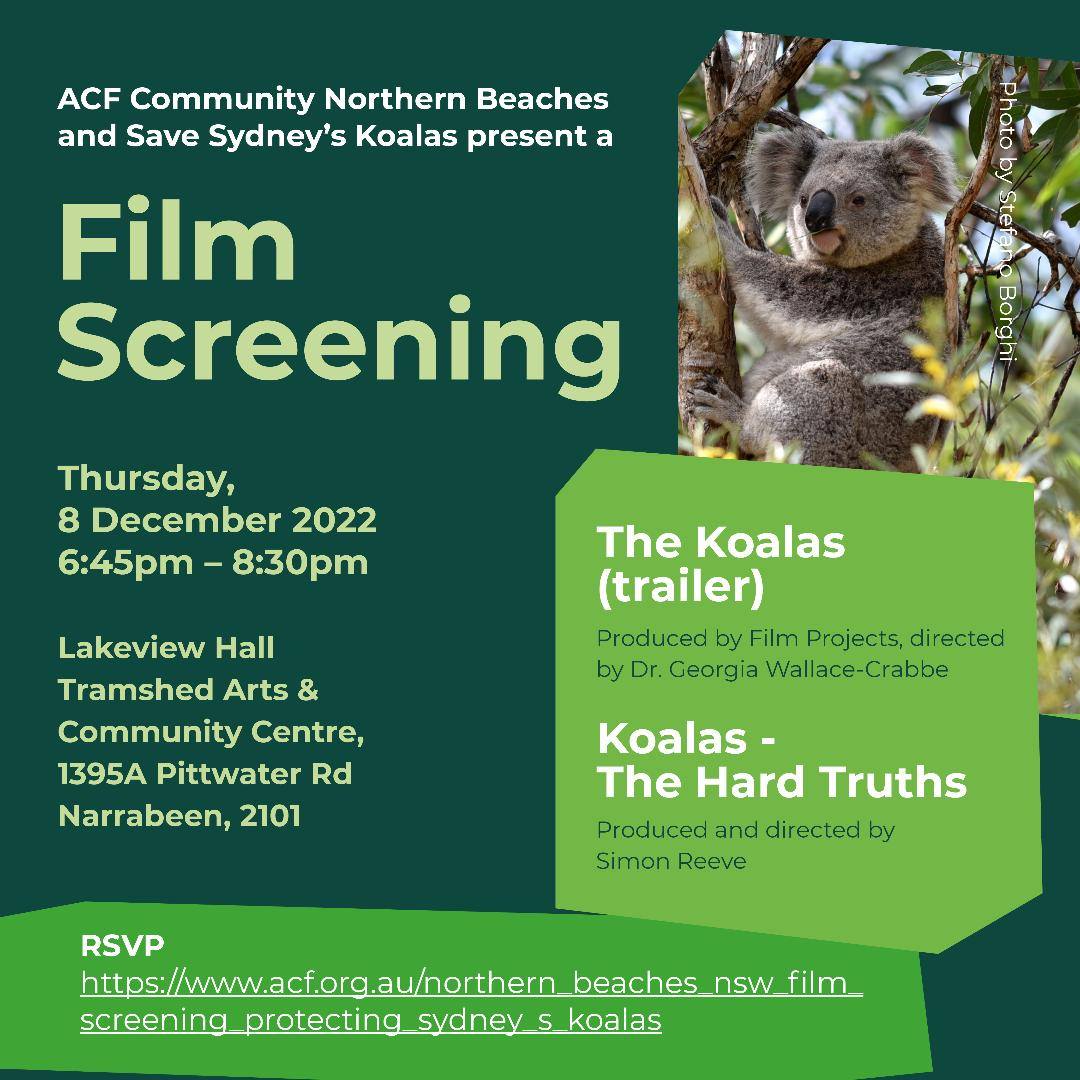
Land Court In Queensland Recommends Against Clive Palmer’s Coal Mine
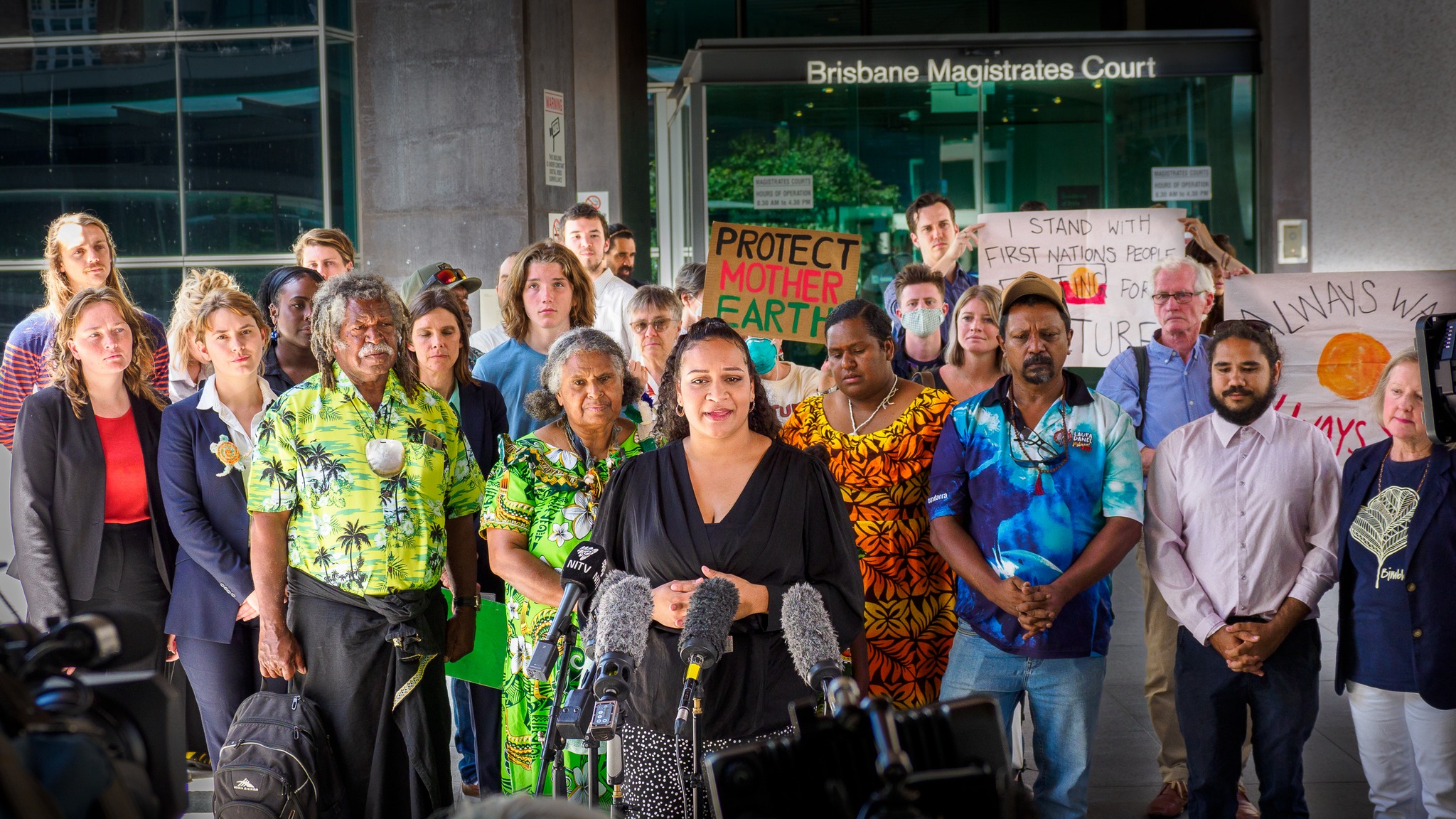
BirdLife Australia Photography Awards 2022 Winners Announced
Regent Honeyeaters Being Helped To Find Their Songs Again
Help Needed To Save Sea Turtle Nests As Third La Nina Summer Looms
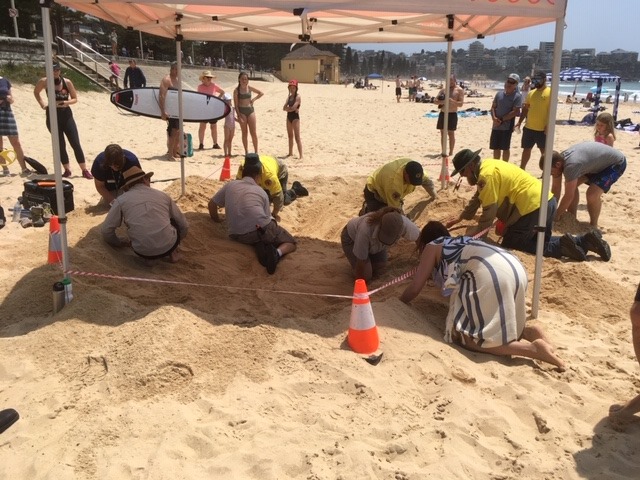

Watch Out - Shorebirds About
.JPG.opt1460x973o0,0s1460x973.jpg?timestamp=1663629195339)
Wanted: Photos Of Flies Feeding On Frogs (For Frog Conservation)

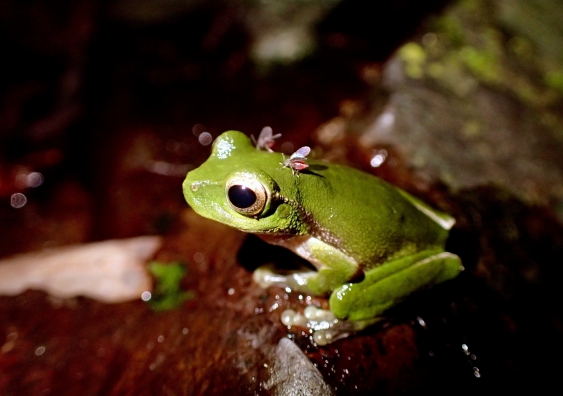
Possums In Your Roof?: Do The Right Thing

Local Wildlife Rescuers And Carers State That Ongoing Heavy Rains Are Tough For Us But Can Be Tougher For Our Wildlife:
- Birds and possums can be washed out of trees, or the tree comes down, nests can disintegrate or hollows fill with water
- Ground dwelling animals can be flooded out of their burrows or hiding places and they need to seek higher ground
- They are at risk crossing roads as people can't see them and sudden braking causes accidents
- The food may disappear - insects, seeds and pollens are washed away, nectar is diluted and animals can be starving
- They are vulnerable in open areas to predators, including our pets
- They can't dry out and may get hypothermia or pneumonia
- Animals may seek shelter in your home or garage.
You can help by:
- Keeping your pets indoors
- Assessing for wounds or parasites
- Putting out towels or shelters like boxes to provide a place to hide
- Drive to conditions and call a rescue group if you see an animal hit (or do a pouch check or get to a vet if you can stop)
- If you are concerned take a photo and talk to a rescue group or wildlife carer
There are 2 rescue groups in the Northern Beaches:
Sydney Wildlife: 9413 4300
WIRES: 1300 094 737
Please be patient as there could be a few enquiries regarding the wildlife.
Generally Sydney Wildlife do not recommend offering food but it may help in some cases. Please ensure you know what they generally eat and any offerings will not make them sick. You can read more on feeding wildlife here
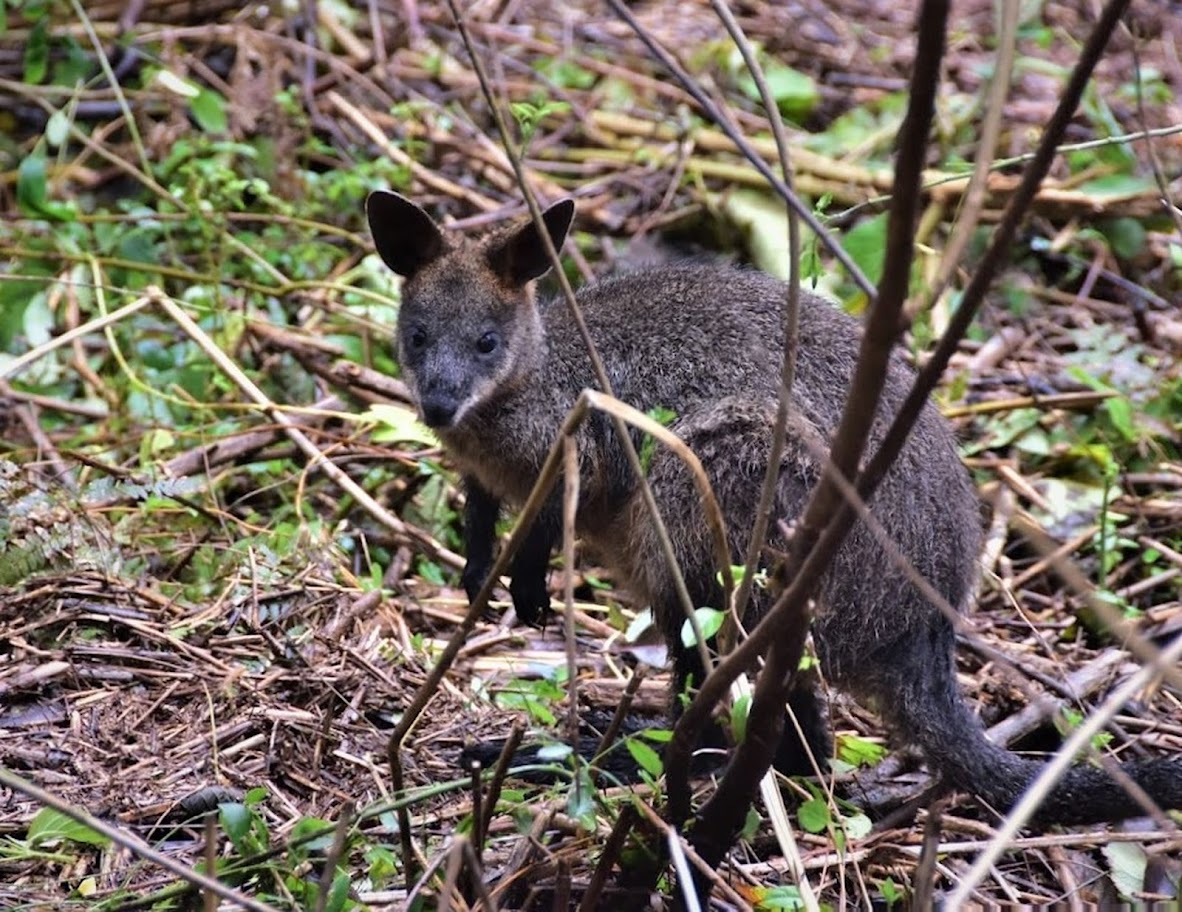
Information courtesy Ed Laginestra, Sydney Wildlife volunteer. Photo: Warriewood Wetlands Wallaby by Kevin Murray, March 2022.
Aviaries + Possum Release Sites Needed

Sydney Wildlife Rescue: Helpers Needed

Bushcare In Pittwater
Where we work Which day What time
Avalon
Angophora Reserve 3rd Sunday 8:30 - 11:30am
Avalon Dunes 1st Sunday 8:30 - 11:30am
Avalon Golf Course 2nd Wednesday 3 - 5:30pm
Careel Creek 4th Saturday 8:30 - 11:30am
Toongari Reserve 3rd Saturday 9 - 12noon (8 - 11am in summer)
Bangalley Headland 2nd Sunday 9 to 12noon
Bayview
Winnererremy Bay 4th Sunday 9 to 12noon
Bilgola
North Bilgola Beach 3rd Monday 9 - 12noon
Algona Reserve 1st Saturday 9 - 12noon
Plateau Park 1st Friday 8:30 - 11:30am
Church Point
Browns Bay Reserve 1st Tuesday 9 - 12noon
McCarrs Creek Reserve Contact Bushcare Officer To be confirmed
Clareville
Old Wharf Reserve 3rd Saturday 8 - 11am
Elanora
Kundibah Reserve 4th Sunday 8:30 - 11:30am
Mona Vale
Mona Vale Beach Basin 1st Saturday 8 - 11am
Mona Vale Dunes 2nd Saturday +3rd Thursday 8:30 - 11:30am
Newport
Bungan Beach 4th Sunday 9 - 12noon
Crescent Reserve 3rd Sunday 9 - 12noon
North Newport Beach 4th Saturday 8:30 - 11:30am
Porter Reserve 2nd Saturday 8 - 11am
North Narrabeen
Irrawong Reserve 2nd Saturday 2 - 5pm
Palm Beach
North Palm Beach Dunes 3rd Saturday 9 - 12noon
Scotland Island
Catherine Park 2nd Sunday 10 - 12:30pm
Elizabeth Park 1st Saturday 9 - 12noon
Pathilda Reserve 3rd Saturday 9 - 12noon
Warriewood
Warriewood Wetlands 1st Sunday 8:30 - 11:30am
Whale Beach
Norma Park 1st Friday 9 - 12noon
Western Foreshores
Coopers Point, Elvina Bay 2nd Sunday 10 - 1pm
Rocky Point, Elvina Bay 1st Monday 9 - 12noon
Friends Of Narrabeen Lagoon Catchment Activities

Gardens And Environment Groups And Organisations In Pittwater
They might not have a spine, but invertebrates are the backbone of our ecosystems. Let’s help them out
Peter Contos, La Trobe University and Heloise Gibb, La Trobe UniversityMany of Australia’s natural places are in a poor state. While important work is being done to protect particular species, we must also take a broader approach to returning entire ecosystems to their former glory – a strategy known as “rewilding”.
Rewilding aims to restore the complex interactions that make up a functioning ecosystem. It involves reintroducing long-lost plants and animals to both conserve those species and restore an area’s natural processes.
You might imagine this involves an ecologist releasing cute, furry bilbies, or an endangered songbird. This is a logical assumption. Research shows a marked bias in reintroduction programs towards vertebrates, especially birds and mammals.
Meanwhile, invertebrates are often overlooked. But our new research shows rewilding with invertebrates – insects, worms, spiders and the like – can go a long way in bringing our degraded landscapes back to life.

A Shocking Decline
Invertebrates make up 97% of animal life and drive key processes such as pollination and cycling nutrients. But they’re the focus of just 3% of reintroduction projects.
This reflects a taxonomic bias in conservation. Overseas, this has led to rewilding projects centred on large keystone mammals that alter ecosystems on a broad scale, such as wolves and bison.
Of course, traditional vertebrate rewilding projects are very important for ecosystem restoration. In Australia, for example, they are vital in restoring mammal communities decimated by cats and foxes.
But invertebrate species are declining at shocking rates around the world, especially as climate change worsens. They also need our help to re-colonise new areas.
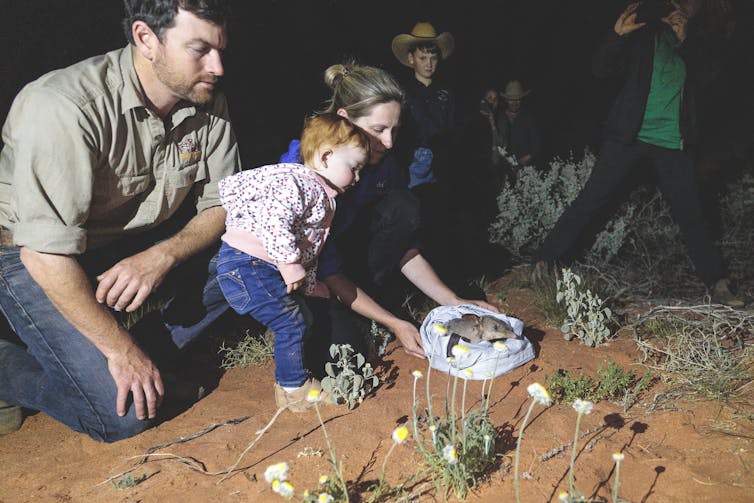
No Beetle Is An Island
Picture an island in the middle of the ocean. The further from shore it is, the more animals on the mainland will struggle to reach it – especially if they’re tiny and wingless, like many invertebrates.
My colleagues and I built our study around this analogy.
Instead of islands, our research involved six isolated patches of revegetated land on farms. And instead of an ocean, invertebrates had to cross a sea of pasture which, for many litter-dwelling invertebrates, is a barren, unsheltered wasteland.
The farm sites were “biologically poor”. That is, despite the habitat quality improving following revegetation, they contained lower-than-expected invertebrate biodiversity.
We surmised that invertebrates from surrounding “biologically rich” national parks were struggling to reach and recolonise the isolated revegetation patches.
Our study involved giving invertebrates a hand to find new homes. We moved leaf litter – and more than 300 invertebrates species hiding in it – from national park sites into six revegetated farm sites in central Victoria.
We moved litter samples several times between 2018 and 2020, over different seasons. Sites were “paired”, so a national park site was paired with a revegetated one that would have been similar had degradation had not occurred.
The litter community of invertebrates is incredibly complex and can be broken into three groups: macroinvertebrates (more than 5 mm), mesoinvertebrates (less than 5 mm) and microbes. We focused on mesoinvertebrates, which mostly comprise mites, ticks, ants, beetles and springtails (small, wingless arthropods).
We found among this group, beetles were most likely to survive and thrive in their new habitat, which was much drier than the one they left. Rove beetles did particularly well.

Beetles are hardy little things with strong exoskeletons that protect them from drying out. In fact, as early as seven months after being moved, beetle numbers at the new sites reached levels similar to that in pristine national parks that we sourced leaf litter from.
We did not have the same success with other types of invertebrates. For example, springtails are a massive component of leaf litter communities in national parks. But they’re soft-bodied and dry out easily, so were more likely to die when moved to a new, drier environment.
Understanding why some groups are more likely to survive leaf litter transplants than others is a vital step in the development of invertebrate rewilding. Nonetheless, our results show the relatively simple act of moving leaf litter can lead to comparatively large increases in species richness in a short time.
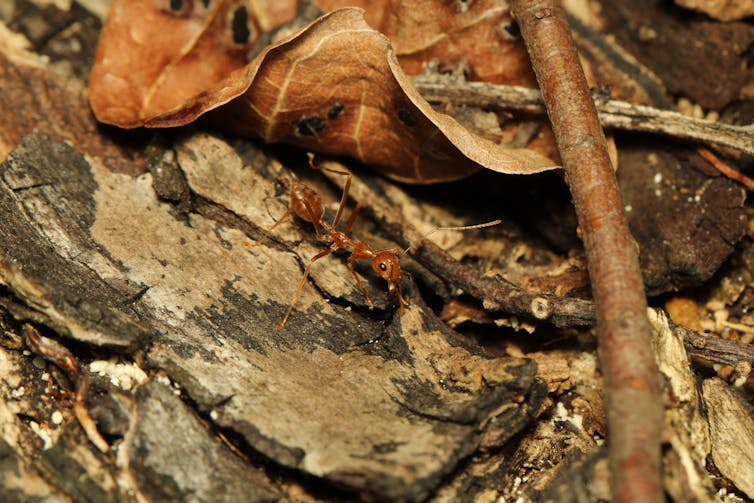
Loving Our Creepy Crawlies
Our study showed how a simple method of rewilding with invertebrates can effectively reintroduce multiple species at once. This is an important finding.
More research into the method is needed across different types of sites and over longer timeframes. However, our method has the potential to be applied widely in the fight against global invertebrate declines.
The method is cheap and easy. In contrast, rewilding projects involving vertebrates can be hard to execute and expensive, and often require breeding animals for release.
Invertebrates are the bulk of terrestrial diversity and the backbone for proper ecosystem functioning. We need to start putting them at the centre of rewilding projects.
Our results are just one small piece in the puzzle. Many other invertebrate communities will need safeguarding and restoring in the future.
Recent research has challenged the assumption that humans naturally find vertebrates more engaging than invertebrates. We might be pleasantly surprised to find the public is as engaged with invertebrate rewilding projects as those focused on cute and cuddly critters.![]()
Peter Contos, PhD Candidate, La Trobe University and Heloise Gibb, Professor, La Trobe University
This article is republished from The Conversation under a Creative Commons license. Read the original article.
That siren-imitating lyrebird at Taronga Zoo? He lost his song culture – and absorbed some of ours
Alex Maisey, La Trobe UniversityA fortnight after five lions escaped at Sydney’s Taronga Zoo, an amused zoo visitor captured footage of Echo the superb lyrebird as he mimicked alarm sirens and evacuation calls with astonishing accuracy.
News outlets were quick to link the lyrebird’s alarm impersonation with the lion’s great escape. But while this tale made for a great headline, the truth of this story is far more interesting.
Superb lyrebirds are arguably the bird world’s greatest mimics. Using their phenomenal voiceboxes, males will sing elaborate songs and perfectly imitate sounds made by other birds to impress prospective mates.
Not only this, they share songs in a form of cultural transmission. In the wild, some songs become more popular while others wane. Think of it as pop charts for the bush.
But Echo was bred in captivity. He wasn’t exposed to wild song culture. Instead, he learned from what he was exposed to – and that includes “songs” like the alarm call. Echo had been practising this call for years to get it that good – not just the two weeks after the lions escaped.
The ability of these birds to imitate sounds is rightly world-famous. But for their song culture to continue, we need healthy wild populations. Otherwise, they could face a future like critically endangered regent honeyeaters, which are now borrowing mating songs from other birds.
Why Do Lyrebirds Learn Human-Made Sounds And Songs?
Many of us are familiar with the famous sequence in David Attenborough’s Life of Birds where a lyrebird accurately imitates camera clicks, a chainsaw motor and construction sounds.
But most watchers wouldn’t have guessed the bird’s secret – it was bred in captivity. That’s why it was so good at imitating our sounds.
Similarly, Echo of Taronga Zoo was also captive-bred. Mimicking a human-origin sound such as the alarm is a behaviour not commonly seen in the wild, other than in heavily visited areas such as in Victoria’s Dandenong Ranges where wild lyrebirds may hear, say, human voices every day.
That’s because lyrebirds seem to learn which songs to sing by listening to their peers, rather than simply soaking up sounds around them like a sponge.
In Victoria’s Sherbrooke Forest, lyrebirds mimic the familiar melodic whip-crack of the whipbird above all other mimicked sounds. But in Kinglake forest just 60 kilometres north, the whipbird’s call was only the 12th most popular for local lyrebirds, while the calls of the grey shrike-thrush and laughing kookaburra took top billing.
This is culture – the songs and sounds are passed from one bird to the next, between generations, and undergo change over time.
But How Do They Do It?
It’s not magic – it’s a complicated organ. Our voicebox – the larynx – is in our throats. But birds have theirs – the syrinx – further down, at the bottom of their windpipes. As they breathe out, they pass air through the syrinx to make their calls and songs.
Remarkably, many songbirds can control airflow from each lung, meaning they can produce sound in mono or stereo and have greater control over the types of sound they can make. They can use one side of the syrinx, both together, or switch back and forth.
Lyrebirds take it a step further again. They have fewer pairs of muscles around their syrinx, but the ones they do have are extremely well adapted to the job of making sound. Some lyrebird researchers believe this may be the reason they can produce such an extraordinary range of sounds, but this has yet to be conclusively shown.

Even so, they’re not born superstars. Young lyrebirds struggle to reproduce mimicked sounds as perfectly as adult lyrebirds can. This suggests a lyrebird’s voice improves over years of practice.
Added to that is the dancing. Male courtship displays involve dance moves accompanying their song. That’s a cognitively challenging task, which is why not all of us are capable of being K-Pop stars.
To combine song and dance needs a large and well-developed brain. And that, after all, may be the point – the male’s ability to coordinate and song with dance is thought to be the key selection criteria for females choosing their mates.
So for Echo to perfect his fire alarm song, he had to practice and practice and practice to get it to the point where we can recognise it. Like humans practising a language or a musical instrument, lyrebirds must work at their songs.
Why Does Bird Culture Matter?
Imagine if Echo was inspired by the lions and escaped. How would he fare in the wild? It’s unlikely he’d ever manage to impress a mate with his “evacuate now” mimicry and siren song. It’s as if a human was raised by wolves – it would be all but impossible to reintegrate.
The reason why we watch videos of Echo and find them amusing is because we are instinctively drawn to animal behaviour we can make sense of through our own. Animals acting like humans is amusing and appealing for us. But, alas, there’s a serious point here.
Take the critically endangered regent honeyeater, which once flew through box-ironbark forests in dense, raucous flocks. Now there are only 300 or so left in the wild.
With a population this low, the species loses not only genetic diversity but culture as well. Regent honeyeaters are losing their courtship songs, because the young birds simply don’t have enough peers to listen to and learn from. Without peers, some males only sing the songs of other species.
While lyrebirds are good survivors during natural disasters, there’s no room for complacency. The Black Summer fires put the superb lyrebird at real risk from habitat loss as well as introduced predators. If we’re not careful, the lyrebird too, could lose its culture and its songs. ![]()
Alex Maisey, Postdoctoral research fellow, Research Centre for Future Landscapes, La Trobe University
This article is republished from The Conversation under a Creative Commons license. Read the original article.
Stripping carbon from the atmosphere might be needed to avoid dangerous warming – but it remains a deeply uncertain prospect

Australia’s latest State of the Climate Report offers grim reading. As if recent floods weren’t bad enough, the report warns of worsening fire seasons, more drought years and, when rain comes, more intense downpours. It begs the question: is it too late to avoid dangerous warming?
At the COP27 climate summit in Egypt some states began to question whether the target to limit global warming to 1.5℃ this century should be dropped. The commitment was ultimately retained, but it remains unlikely we’ll meet it.
This means attention is turning to other options for climate action, including large-scale carbon removal.
Carbon removal refers to human activities that take carbon dioxide from the atmosphere and store it (ideally permanently) – in rock formations, land or ocean reservoirs. The more common, and least controversial, forms of carbon removal are tree-planting, mangrove restoration and enhancing soil carbon.
All forms of carbon removal - including natural and high-tech measures - are defined as forms of geoengineering. All are increasingly part of the global climate discussion.
Proponents argue carbon removal is required at a massive scale to avoid dangerous warming. But the practice is fraught. Successfully stripping carbon from the atmosphere at the scale our planet requires is a deeply uncertain prospect.
Limiting Global Warming To 1.5℃ Is Getting Harder
In 2015 the international community set a goal of limiting warming to well below 2℃, and preferably to 1.5℃ this century, compared to pre-industrial levels. Seven years later, global emissions are not on track to achieve this.
The State of the Climate Report released this week found Australia has already warmed by 1.47℃. The Intergovernmental Panel on Climate Change (IPCC) says the planet overall has heated by 1.09℃.
Renewable energy is growing rapidly, but so too is the use of oil and coal. The emissions “budget” that would limit warming to 1.5℃ is almost spent.
The IPCC said in a report this year that large-scale deployment of carbon dioxide removal was “unavoidable” if the world is to reach net-zero greenhouse gas emissions.
It followed an IPCC report in 2018 containing scenarios in which warming could be limited to 1.5℃. These scenarios required significant emission reductions along with carbon removal of between 100–1,000 billion tonnes of CO₂ by 2100. For context, global annual energy emissions are now approximately 31 billion tonnes of CO₂.
Today, policy planners often assume large-scale carbon removal will become necessary. Meanwhile, critics worry that the promise of carbon removal will delay other actions to mitigate climate change.
Indeed, some critics question if large-scale removal will ever be feasible, saying it’s unlikely to be developed in time nor work effectively.
What Does Carbon Removal Look Like?
Cramming centuries of carbon pollution into the biosphere won’t be easy. One key challenge is making the storage permanent.
Consider trees. While forests store a lot of carbon, if they burn then the carbon goes straight back into the atmosphere. What’s more, there’s not enough land for forests to deliver negative emissions on the scales we require to limit global warming.
Carbon removal by planting new forests (afforestation) can also create social injustices. In some cases Indigenous communities have lost control of homelands appropriated for carbon storage.
As a result, some experts and civil society groups are calling for more complex methods of carbon removal. Two widely discussed examples include “direct air capture and storage” (use fans to force air through carbon-capturing filters) and “bioenergy, carbon capture and storage” (grow forests, burn them for electricity, capture and store the carbon).
In each case, the goal is to permanently sequester captured carbon in underground geologic formations. This will likely offer more permanent carbon removal than “natural solutions” such as planting trees. Their lower land requirements mean they should also be easier to scale.
However, these higher-tech methods are also more expensive and often lack public support. Consider plans for the Sizewell Nuclear Power Station in the United Kingdom to power “direct air capture” of carbon dioxide. Sizewell is promising carbon negative electricity, but nuclear-powered negative emissions are unlikely to be popular or cheap.
One Australian start-up has plans for solar-powered direct air capture of CO₂. However, this project’s costs are prohibitively high.
Much social learning will be needed before large-scale carbon removal of any type can become a thing. For now, we need to democratically review which, if any, carbon removal methods are actually a good idea.
Carbon Removal Credits Could Be Dodgy
As governments begin to grasp the difficulties in decarbonising sectors such as agriculture and aviation, they have begun to look to carbon removal technologies to meet their net-zero emissions pledges.
For example, in the United States, the Biden administration’s Inflation Reduction and CHIPS Acts promise massive new carbon removal programs.
At COP27, negotiators considered how carbon removals should be defined internationally. At stake is which carbon removal projects will be able to generate “tradeable” offsets.
Most decisions at COP27 ended up being delayed or referred to working groups. Nevertheless, civil society observers worried that dodgy carbon removal credits might undermine the Paris Agreement’s integrity.
When credits are awarded to projects that don’t really capture carbon or do so only temporarily, then carbon reduction schemes lose all credibility.
How To Avoid Integrity Issues
Assessing the material and social impacts of carbon removal – whether via a “natural solution” or a new technology – will first require small-scale deployment.
To avoid integrity issues, the world will need robust regulations on how carbon removal is conducted. This includes:
agreed standards to measure carbon removal in ways that rule out dodgy or temporary carbon removal
more advanced carbon removal technologies that bring down the cost and reduce land and energy requirements
more sophisticated ways of aligning carbon removal with social justice so that sovereignty and humanity rights are prioritised over carbon markets
a system of incentives to encourage carbon removal. States, companies and other actors should be rewarded for their climate restoration work, but these efforts must be additional to actual emissions reduction.
Of course, the best thing to do is to stop emitting carbon. However, preserving a safe climate will likely require us to go further. It’s time to start a democratic discussion about carbon removal.![]()
Jonathan Symons, Senior Lecturer, Macquarie School of Social Sciences, Macquarie University and Matt McDonald, Associate Professor of International Relations, The University of Queensland
This article is republished from The Conversation under a Creative Commons license. Read the original article.
State of the climate: what Australians need to know about major new report
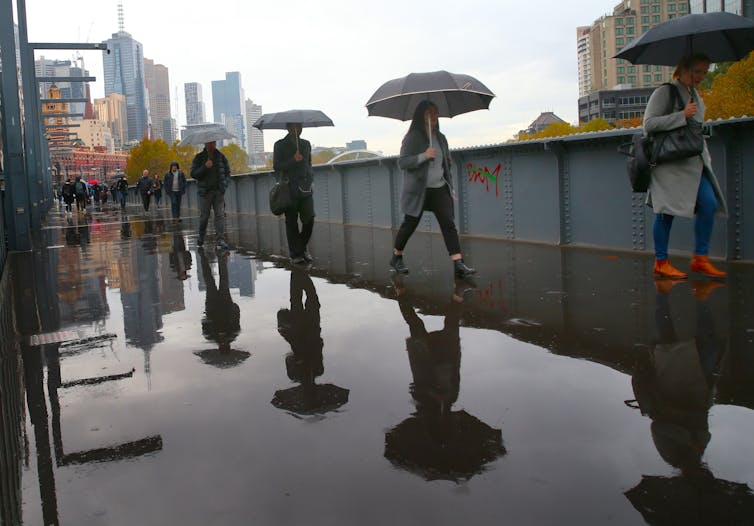
The latest State of the Climate report is out, and there’s not much good news for Australians.
Our climate has warmed by an average 1.47℃ since national records began, bringing the continent close to the 1.5℃ limit the Paris Agreement hoped would never be breached. When global average warming reaches this milestone, some of Earth’s natural systems are predicted to suffer catastrophic damage.
The report, released today, paints a concerning picture of ongoing and worsening climate change. In Australia, associated impacts such as extreme heat, bushfires, drought, heavy rainfall, and coastal inundation threaten our people and our environment.
The report is a comprehensive biennial snapshot of the latest trends in climate, with a focus on Australia. It’s compiled by the Bureau of Meteorology and CSIRO, drawing on the latest national and international climate research.
It synthesises the latest science about Australia’s climate and builds on the previous 2020 report by including, for example, information from the most recent assessment report by the Intergovernmental Panel on Climate Change.
And the take home message? Climate change continues unabated. The world is warming, sea levels are rising, ice is melting, fire weather is worsening, flooding rains are becoming more frequent – and the list goes on.
What follows is a summary of major findings in three key categories – and an explanation of what it all means.

1. Warming, Heat Extremes And Bushfire
The 2020 report said Australia’s climate has warmed on average by 1.44℃ since national records began in 1910. That warming has now increased to 1.47℃. This mirrors trends across the world’s land areas, and brings with it more frequent extreme heat events.
The year 2019 was Australia’s warmest on record. The eight years from 2013 to 2020 are all among the ten warmest ever measured. Warming is happening both by day and by night, and across all months.
Since the 1950s, extreme fire weather has increased and the fire season has lengthened across much of the country. It’s resulted in bigger and more frequent fires, especially in southern Australia.
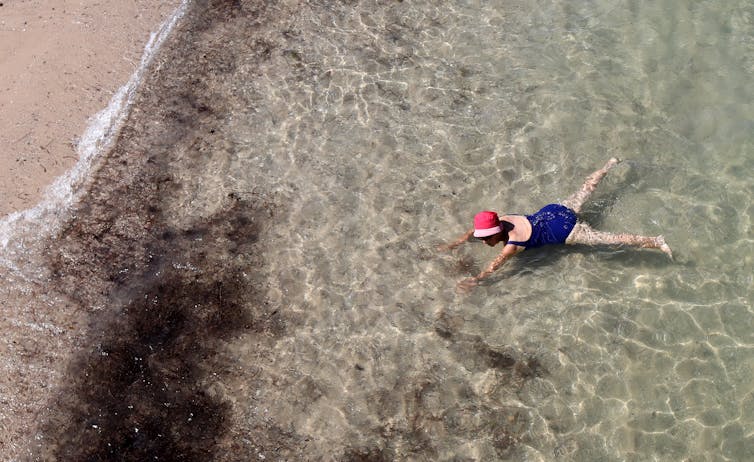
2. Rain, Floods And Snow
In Australia’s southwest, May to July rainfall has fallen by 19% since 1970. In the southeast of Australia, April to October rainfall has fallen by 10% since the late 1990s.
This will come as somewhat of a surprise given the relatively wet conditions across eastern Australia over the past few years. But don’t confuse longer term trends with year-to-year variability.
Lower rainfall has led to reduced streamflow; some 60% of water gauges around Australia show a declining trend.
At the same time, heavy rainfall events are becoming more intense – a fact not lost on flood-stricken residents in Australia’s eastern states in recent months. The intensity of extreme rainfall events lasting an hour has increased by about 10% or more in some regions in recent decades. This often brings flash flooding, especially in urban environments. The costs to society are enormous.
Warm air can hold more water vapour than cooler air. That’s why global warming makes heavy rainfall events more likely, even in places where average rainfall is expected to decline.
Also since the 1950s, snow depth and cover, and the number of snow days, have decreased in alpine regions. The largest declines are happening in spring and at lower altitudes.
Extremely cold days and nights are generally becoming less frequent across the continent. And while parts of southeast and southwest Australia have recently experienced very cold nights, that’s because cool seasons have become drier and winter nights clearer there, leading to more overnight heat loss.
Any camper will tell you how chilly it can get on a clear starry night, without the warm blanket of cloud cover.
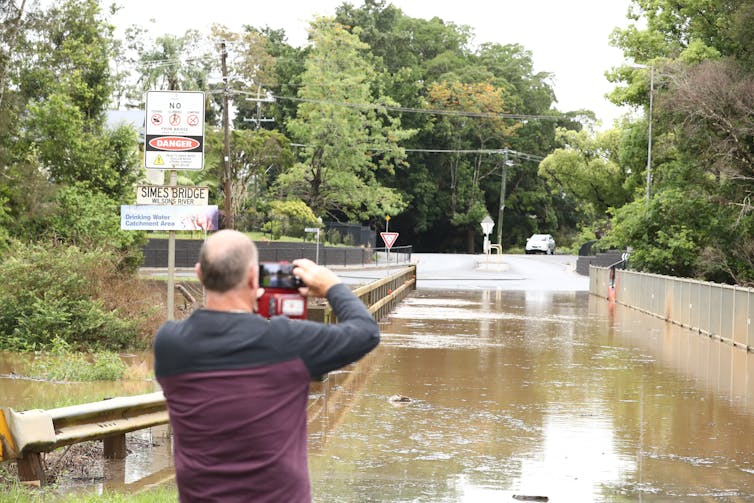
3. Oceans And Sea Levels
Sea surface temperatures around the continent have increased by an average 1.05℃ since 1900. The greatest ocean warming since 1970 has occurred off southeast Australia and Tasmania. In the Tasman Sea, the warming rate is now twice the global average.
Ongoing ocean warming has also contributed to longer and more frequent marine heatwaves. Marine heatwaves are particularly damaging to ecosystems, including the Great Barrier Reef, which is at perilous risk of ruin if nothing is done to address surging greenhouse gas emissions.
Oceans around Australia have also become more acidic, and this damage is accelerating. The greatest change is occurring in temperate and cooler waters to the south.
Sea levels are rising globally and around Australia. This is driven by both ocean warming and melting ice. Ice loss from Greenland, Antarctica and glaciers is increasing, and only set to get worse.
Around Australia, the largest sea level rise has been observed to the north and southeast of the continent. This is increasing the risk of inundation and damage to coastal infrastructure and communities.
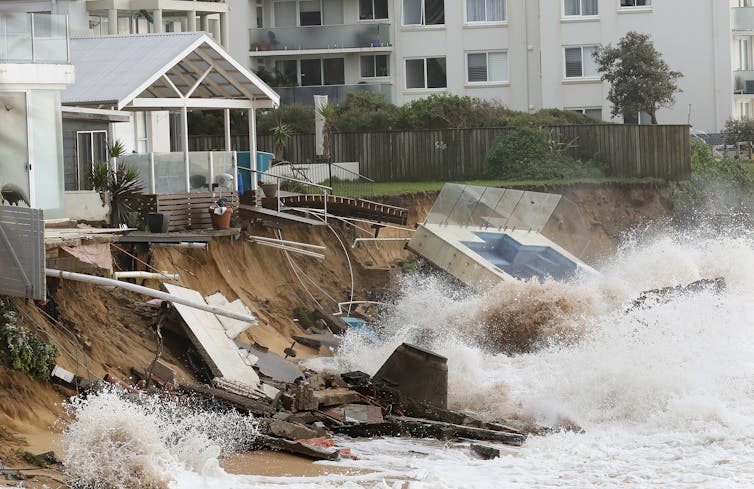
What’s Causing This?
All this is happening because concentrations of greenhouse gases in Earth’s atmosphere continue to rise. The principal driver of these gases is human burning of fossil fuels. These long-lived gases form a “blanket” in the atmosphere that makes it harder for Earth to radiate the Sun’s heat back into space. And so, the planet warms, with very costly impacts to society.
The report confirmed carbon dioxide (CO₂) has been accumulating in the atmosphere at an increasing rate in recent decades. Worryingly, over the past two years, levels of methane and nitrous oxide have also grown very rapidly.
What Comes Next?
None of these problems are going away. Australia’s weather and climate will continue to change in coming decades.
As the report states, these climate changes are increasingly affecting the lives and livelihoods of all Australians. It goes on:
Australia needs to plan for, and adapt to, the changing nature of climate risk now and in the decades ahead. The severity of impacts on Australians and our environment will depend on the speed at which global greenhouse gas emissions can be reduced.
This point is particularly confronting, given the abject failure of the recent COP27 climate talks in Egypt to build on commitments from Glasgow only a year earlier to phase out fossil fuels.
It’s no surprise, then, that the insurance sector is getting nervous about issuing new policies to people living at the front-line of climate extremes.
While the urgency for action has never been more pressing, we still hold the future in our hands - the choices we make today will decide our future for generations to come. Every 0.1℃ of warming we can avoid will make a big difference.
But it’s not all bad news. Re-engineering our energy and transport systems to be carbon neutral will create a whole new economy and jobs growth - with the added bonus of a safer climate future.
Do nothing, and these State of the Climate reports will continue to make for grim reading. ![]()
Matthew England, Scientia Professor and Deputy Director of the ARC Australian Centre for Excellence in Antarctic Science (ACEAS), UNSW Sydney
This article is republished from The Conversation under a Creative Commons license. Read the original article.
COP27: how the fossil fuel lobby crowded out calls for climate justice
Alix Dietzel, University of BristolCOP27 has just wrapped up. Despite much excitement over a new fund to address “loss and damage” caused by climate change, there is also anger about perceived backsliding on commitments to lower emissions and phase out fossil fuels.
As an academic expert in climate justice who went along this year, hoping to make a difference, I share this anger.
“Together for Implementation” was the message as COP27 got underway on November 6 and some 30,000 people descended on the Egyptian resort town of Sharm El Sheik. The UNFCCC strictly regulates who can attend negotiations. Parties (country negotiation teams), the media and observers (NGOs, IGOs and UN special agencies) must all be pre-approved.
I went along as an NGO observer, to represent the University of Bristol Cabot Institute for the Environment. Observers have access to the main plenaries and ceremonies, the pavilion exhibition spaces and side events. The negotiation rooms, however, are largely off limits. Most of the day is spent listening to speeches, networking and asking questions at side-events.

The main role of observers, then, is to apply indirect pressure on negotiators, report on what is happening and network. Meaningful impact on and participation in negotiations seems out of reach for many of the passionate people I met.
Who Does – And Doesn’t – Get A Say
It has long been known that who gets a say in climate change governance is skewed. As someone working on fair decision making as part of a just transition to less carbon-intensive lifestyles and a climate change-adapted society, it is clear that only the most powerful voices are reflected in treaties such as the Paris Agreement. At last year’s COP26, men spoke 74% of the time, indigenous communities faced language barriers and racism and those who could not obtain visas were excluded entirely.
Despite being advertised as “Africa’s COP”, COP27 further hampered inclusion. The run up was dogged by accusations of inflated hotel prices and concerns over surveillance, and warnings about Egypt’s brutal police state. The right to protest was limited, with campaigners complaining of intimidation and censorship.

Arriving in Sharm El Sheik, there was an air of intimidation starting at the airport, where military personnel scrutinised passports. Police roadblocks featured heavily on our way to the hotel and military officials surrounded the COP venue the next morning.
Inside the venue, there were rumours we were being watched and observers were urged not to download the official app. More minor issues included voices literally not being heard due to unreliable microphones and the constant drone of aeroplanes overhead, and a scarcity of food with queues sometimes taking an hour or more. Sponsored by Coca Cola, it was also difficult to access water to refill our bottles. We were sold soft drinks instead.
Outside of the venue, unless I was with a male colleague, I faced near constant sexual harassment, hampering my ability to come and go from the summit. All these issues, major and minor, affect who is able to contribute at COP.
Fossil Fuel Interests Dominated
In terms of numbers, the United Arab Emirates (UAE) registered the largest party delegation with more than 1,000 people. The oil and gas-rich nation of just 9 million people had a delegation almost twice the size of the next biggest, Brazil. More troublingly, the oil and gas lobby representatives were registered in the national delegations of 29 different countries and were larger than any single national delegation (outside of the UAE). According to one NGO, at least 636 of those attending COP27 were lobbyists for the fossil-fuel industry.

Despite the promise that COP27 would foreground African interests, the fossil lobby outnumbers any delegation from Africa. These numbers give a sense of who has power and say at these negotiations, and who does not.
Protecting The Petrostates
The main outcomes of COP27 are a good illustration of the power dynamics at play. There is some good news on loss and damage, which was added to the agenda at the last moment. Nearly 200 countries agreed that a fund for loss and damage, which would pay out to rescue and rebuild the physical and social infrastructure of countries ravaged by extreme weather events, should be set up within the next year. However, there is no agreement yet on how much money should be paid in, by whom, and on what basis.
Much more worryingly, there had been a push to phase out all fossil fuels by countries including some of the biggest producers: the EU, Australia, India, Canada, the US and Norway. However, with China, Russia, Brazil, Saudi Arabia and Iran pushing back, several commitments made at COP26 in Glasgow were dropped, including a target for global emissions to peak by 2025. The outcome was widely judged a failure on efforts to cut emissions: the final agreed text from the summit makes no mention of phasing out fossil fuels and scant reference to the 1.5℃ target.
Laurence Tubiana, one of the architects of the Paris Agreement, blamed the host country, Egypt, for allowing its regional alliances to sway the final decision, producing a text that clearly protects oil and gas petrostates and the fossil fuel industries.
The final outcomes demonstrate that, despite the thousands who were there to advocate for climate justice, it was the fossil fuel lobby that had most influence. As a climate justice scholar, I am deeply worried about the processes at COPs, especially given next year’s destination: Dubai. It remains to be seen what happens with the loss and damage fund, but time is running out and watered down commitments on emissions are at this stage deeply unjust and frankly dangerous.![]()
Alix Dietzel, Senior Lecturer in Climate Justice, University of Bristol
This article is republished from The Conversation under a Creative Commons license. Read the original article.
After COP27, all signs point to world blowing past the 1.5 degrees global warming limit – here’s what we can still do about it

The world could still, theoretically, meet its goal of keeping global warming under 1.5 degrees Celsius, a level many scientists consider a dangerous threshold. Realistically, that’s unlikely to happen.
Part of the problem was evident at COP27, the United Nations climate conference in Egypt.
While nations’ climate negotiators were successfully fighting to “keep 1.5 alive” as the global goal in the official agreement, reached Nov. 20, 2022, some of their countries were negotiating new fossil fuel deals, driven in part by the global energy crisis. Any expansion of fossil fuels – the primary driver of climate change – makes keeping warming under 1.5 C (2.7 Fahrenheit) compared to pre-industrial times much harder.
Attempts at the climate talks to get all countries to agree to phase out coal, oil, natural gas and all fossil fuel subsidies failed. And countries have done little to strengthen their commitments to cut greenhouse gas emissions in the past year.
There have been positive moves, including advances in technology, falling prices for renewable energy and countries committing to cut their methane emissions.
But all signs now point toward a scenario in which the world will overshoot the 1.5 C limit, likely by a large amount. The World Meteorological Organization estimates global temperatures have a 50-50 chance of reaching 1.5C of warming, at least temporarily, in the next five years.
That doesn’t mean humanity can just give up.
Why 1.5 Degrees?
During the last quarter of the 20th century, climate change due to human activities became an issue of survival for the future of life on the planet. Since at least the 1980s, scientific evidence for global warming has been increasingly firm , and scientists have established limits of global warming that cannot be exceeded to avoid moving from a global climate crisis to a planetary-scale climate catastrophe.
There is consensus among climate scientists, myself included, that 1.5 C of global warming is a threshold beyond which humankind would dangerously interfere with the climate system.
We know from the reconstruction of historical climate records that, over the past 12,000 years, life was able to thrive on Earth at a global annual average temperature of around 14 C (57 F). As one would expect from the behavior of a complex system, the temperatures varied, but they never warmed by more than about 1.5 C during this relatively stable climate regime.
Today, with the world 1.2 C warmer than pre-industrial times, people are already experiencing the effects of climate change in more locations, more forms and at higher frequencies and amplitudes.
Climate model projections clearly show that warming beyond 1.5 C will dramatically increase the risk of extreme weather events, more frequent wildfires with higher intensity, sea level rise, and changes in flood and drought patterns with implications for food systems collapse, among other adverse impacts. And there can be abrupt transitions, the impacts of which will result in major challenges on local to global scales.
Steep Reductions And Negative Emissions
Meeting the 1.5 goal at this point will require steep reductions in carbon dioxide emissions, but that alone isn’t enough. It will also require “negative emissions” to reduce the concentration of carbon dioxide that human activities have already put into the atmosphere.
Carbon dioxide lingers in the atmosphere for decades to centuries, so just stopping emissions doesn’t stop its warming effect. Technology exists that can pull carbon dioxide out of the air and lock it away. It’s still only operating at a very small scale, but corporate agreements like Microsoft’s 10-year commitment to pay for carbon removed could help scale it up.
A report in 2018 by the Intergovernmental Panel on Climate Change determined that meeting the 1.5 C goal would require cutting carbon dioxide emissions by 50% globally by 2030 – plus significant negative emissions from both technology and natural sources by 2050 up to about half of present-day emissions.

Can We Still Hold Warming To 1.5 C?
Since the Paris climate agreement was signed in 2015, countries have made some progress in their pledges to reduce emissions, but at a pace that is way too slow to keep warming below 1.5 C. Carbon dioxide emissions are still rising, as are carbon dioxide concentrations in the atmosphere.
A recent report by the United Nations Environment Program highlights the shortfalls. The world is on track to produce 58 gigatons of carbon dioxide-equivalent greenhouse gas emissions in 2030 – more than twice where it should be for the path to 1.5 C. The result would be an average global temperature increase of 2.7 C (4.9 F) in this century, nearly double the 1.5 C target.
Given the gap between countries’ actual commitments and the emissions cuts required to keep temperatures to 1.5 C, it appears practically impossible to stay within the 1.5 C goal.
Global emissions aren’t close to plateauing, and with the amount of carbon dioxide already in the atmosphere, it is very likely that the world will reach the 1.5 C warming level within the next five to 10 years.
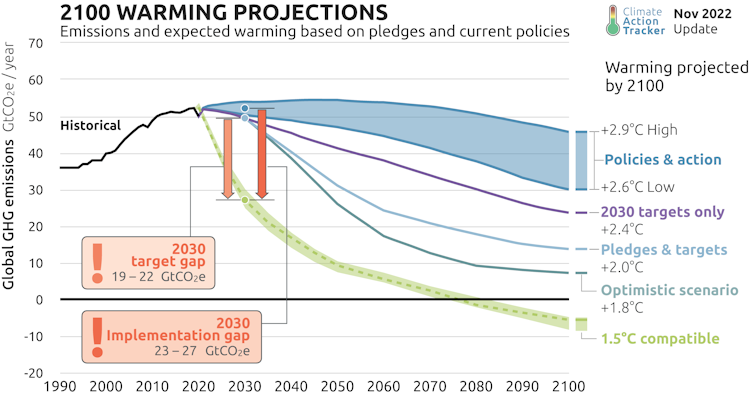
How large the overshoot will be and for how long it will exist critically hinges on accelerating emissions cuts and scaling up negative emissions solutions, including carbon capture technology.
At this point, nothing short of an extraordinary and unprecedented effort to cut emissions will save the 1.5 C goal. We know what can be done – the question is whether people are ready for a radical and immediate change of the actions that lead to climate change, primarily a transformation away from a fossil fuel-based energy system.![]()
Peter Schlosser, Vice President and Vice Provost of the Julie Ann Wrigley Global Futures Laboratory, Arizona State University
This article is republished from The Conversation under a Creative Commons license. Read the original article.
COP27 flinched on phasing out ‘all fossil fuels’. What’s next for the fight to keep them in the ground?
Fergus Green, UCL and Harro van Asselt, Stockholm Environment InstituteThe latest UN climate change summit (COP27) concluded, once again, with a tussle over the place of fossil fuels in the global economy.
An agreement by the world’s governments to phase out all fossil fuels would have been a welcome progression from last year’s Glasgow climate pact. It called on countries to “[accelerate] efforts towards the phasedown of unabated coal power and phase-out of inefficient fossil fuel subsidies”, making it the first UN treaty to acknowledge the need to do something about the main source of greenhouse gas emissions.
But at COP27, widespread anxieties about the cost and availability of energy made many governments cautious about expressing a clear intention to phase out all fossil fuels in the resulting agreement. The COP27 text reiterated the COP26 decision but failed to broaden it to encompass oil and gas, despite a proposal by India to that end (a move that would have helped take the emphasis off coal, of which it is a major consumer).
Still, growing support for such an extension is evident. More than 80 countries (including the EU and US) supported India’s proposal. Many nations are building international agreements outside of the UN negotiation process. After the failure of COP27, the question is what should happen next in the fight against continued fossil fuel use.
There is no doubt that, to preserve a liveable climate, the extraction and burning of coal, oil and gas must be rapidly reduced and, depending on how optimistic you are about carbon capture technologies, phased out altogether.
Despite large planned increases in fossil fuel production, recent research (released just before COP27) found, for the first time, that global demand for each of the fossil fuels will peak or plateau in all scenarios within 15 years. This is partly due to attempts to reduce energy use and increase renewables in the wake of the gas shortage created by sanctions against Russia for its invasion of Ukraine.
As the dangers of extracting and burning fossil fuels have become increasingly apparent, many experts, campaigners, international organisations and, increasingly, governments have contested the moral legitimacy of these activities. In a recent journal article, we argued that the Glasgow agreement represented a breakthrough (albeit a modest one) in the emergence of international anti-fossil fuel norms.
An international norm is a morally appropriate standard of behaviour among states (for example, prevailing norms prohibit foreign aggression, piracy, or the testing and use of nuclear weapons). International conferences such as COP27 catalyse emerging norms by specifying them in formal declarations.
COP decisions are not binding and the language on fossil fuels at COP26 was watered down during negotiations. But the Glasgow text reflected a growing sense among governments that certain activities relating to fossil fuels (like generating electricity from coal without capturing the CO₂ and policies which make fossil fuels cheaper to extract and consume) are becoming illegitimate.
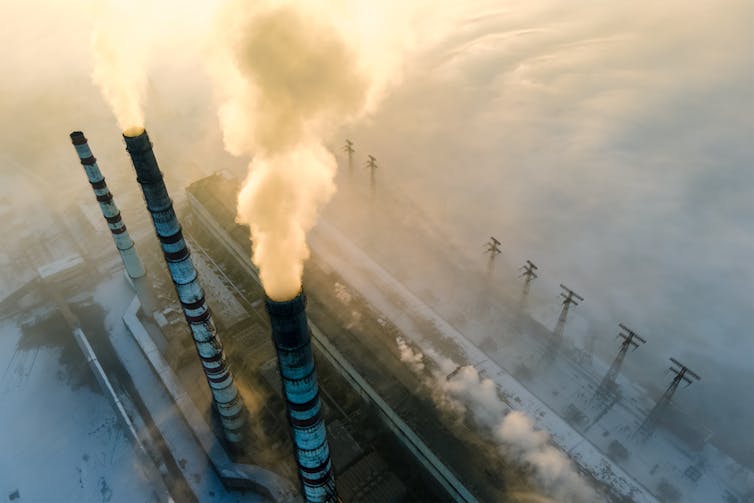
The lack of progress on fossil fuels reflects the upheavals in the energy sector as well as the constraints of the climate negotiations themselves, which operate by consensus. This often produces decisions that reflect the lowest common denominator among nearly 200 countries with diverse energy profiles and interests, and COP27 was no exception.
Large oil and gas producers are profiting handsomely from current market prices and have lobbied governments to permit them to explore and drill for yet more oil and gas. At COP27, there were more oil and gas industry lobbyists than the combined number of delegates from the ten countries most affected by climate change. Little wonder COP27 did not yield consensus on phasing down all fossil fuels.
Other international initiatives are not bound by such procedural constraints, and there was more progress on the sidelines of COP27. The Beyond Oil & Gas Alliance (Boga), an initiative launched around the time of COP26 by Denmark and Costa Rica that aims to phase out oil and gas production, attracted new members Chile, Fiji and the US state of Washington, with Portugal upgraded to “core member” status.
Emulating a deal between South Africa and several wealthy countries from a year earlier, a new just energy transition partnership was launched between Indonesia and Japan, Canada, the US, Denmark and others, to help Indonesia transition from coal to renewables.
What More Can Be Done?
In the coming years, there will be growing civil society and diplomatic pressure for a phase-out of all fossil fuels in a COP decision. But independent initiatives among states, like Boga, must be nurtured in parallel, and the high-level pledges made in these initiatives must be implemented.
For instance, a group of nations pledged at COP26 to end public finance for fossil fuels by the end of 2022. While some countries are on track to meet this goal, others are not following through.
Countries should also develop an international agreement to restrict and phase out fossil fuels. Building on a global campaign for such an agreement, the small island nations of Tuvalu and Vanuatu have called for a fossil fuel non-proliferation treaty. We suggest two ways to advance these efforts which draw on our recent research.
First, Tuvalu and Vanuatu could encourage their Pacific Island counterparts to create a regional fossil free zone treaty that prohibits the extraction and transportation of fossil fuels throughout the territories and territorial waters of members.
Second, more must be done to name and shame governments, especially rich ones, who are expanding how much fossil fuel they extract and burn. This effort demands greater transparency around government activities. A new global registry of fossil fuels is helping to catalogue this information. But governments should also disclose all fossil fuel infrastructure that is being planned or considered on their territory, or with their support.
The COP27 outcome is a timely reminder that curbing the growth in fossil fuels will not come about through consensus-oriented negotiations among governments that include those corrupted by the fossil fuel industry. It will require social movements pressuring leaders to legislate a managed phase out of fossil fuels, while ensuring a just transition for affected workers and communities. And it will require pioneering governments to work together internationally to forge new alliances that accelerate this goal.

Don’t have time to read about climate change as much as you’d like?
Get a weekly roundup in your inbox instead. Every Wednesday, The Conversation’s environment editor writes Imagine, a short email that goes a little deeper into just one climate issue. Join the 10,000+ readers who’ve subscribed so far.![]()
Fergus Green, Lecturer in Political Theory and Public Policy, UCL and Harro van Asselt, Professor of Climate Law and Policy, University of Eastern Finland, Visiting Researcher, Copernicus Institute of Sustainable Development, Utrecht University & Affiliated Researcher, Stockholm Environment Institute
This article is republished from The Conversation under a Creative Commons license. Read the original article.
Adapting to a hotter planet has never been more important, and progress edged forward at COP27
Johanna Nalau, Griffith UniversityAs the COP27 climate summit drew to a close over the weekend, it’s important to acknowledge that progress was made on climate adaptation – even if more can be done.
“Climate adaptation” is a term for how countries adapt to the impacts of climate change. It could be, for instance, by strengthening infrastructure to better withstand disasters, moving towns out of floodplains, or transforming the agriculture sector to minimise food insecurity.
As the costs of disasters climb, working out who will finance climate adaptation has become increasingly urgent for developing nations. For decades, they’ve called upon wealthy countries – largely responsible for causing the climate crisis in the first place – to foot the bill.
So let’s explore what COP27 achieved, how these achievements might translate into tangible commitments, and what must happen now to give everyone a fighting chance to survive on a hotter planet.
A Thorny Issue
The thorniest issues at climate change negotiations are about finance: who is giving, who is receiving, how is the money received and what kind of finance is made available.
Developed countries don’t have a good track record on this. In 2009, they committed to mobilising US$100 billion per year of climate finance by 2020 – a target that remains unmet.
What’s more, most climate finance so far has been directed towards helping developing nations mitigate their emissions, rather than for adaptation.
As Dina Saleh, the Regional Director of the United Nations International Fund for Agricultural Development, explained during the conference, failing to help rural populations adapt could lead to more poverty, migrations and conflict. She said:
We are calling on world leaders from developed nations to honour their pledge to provide the $100 billion a year in climate finance to developing nations and to channel half of that [for] climate adaptation.
Adaptation Finance Still Falls Short
The United Nations has established different funds to channel adaptation finance, including the Least Developing Countries Fund, Special Climate Change Fund and Adaptation Fund.
At COP27, eight countries pledged US$105.6 million for adaptation via the Least Developing Countries Fund and Special Climate Change Fund, including Sweden, Germany and Ireland. Others, such as the United States and Canada, expressed potential future financial commitments.
These funds are in addition to the US$413 million promised at COP26 in Glasgow last year, via the Least Developing Countries Fund. The money will target the most urgently needed adaptation efforts, such as strengthening infrastructure, social safety nets and diversifying livelihoods.
There is also a specific new funding for small-island developing states. While this development has been welcomed by the Alliance of Small Island States, it also says faster processes are needed to make the money available.
Small island nations such as Tuvalu are already experiencing severe climate impacts, and the projections are dire. For example, the Intergovernmental Panel on Climate Change found some atoll islands are likely to experience coral bleaching every year by 2040.
These islands are also particularly vulnerable to tropical cyclones. One single large event can set development back years. For example, in 2016 tropical cyclone Winston took out over a third of Fiji’s GDP in about 36 hours.
Similarly, other highly vulnerable nations across Africa and Asia are asking for easier access to adaptation finance. The Adaptation Fund included an innovation that gave countries easier access to money, and ensured it responds directly to each country’s needs.
At COP27, this fund received over US$230 million in new pledges. However, it currently has unfunded adaptation projects worth US$380 million in the pipeline, signalling the urgent need to ramp up finance.
Progress Is Edging Forward
The Paris Agreement in 2015 set the “global goal on adaptation” to drive collective progress on climate adaptation worldwide. At COP27, countries agreed to develop a framework for this goal in 2023. This includes gender-responsive approaches, and science-based metrics and targets to track progress.
Another big-ticket item is the “global stocktake” on adaptation, which measures progress at the national level on fulfilling Paris Agreement obligations.
At COP27, it was noted only 40 countries so far have submitted their national adaptation plans, which identify adaptation priorities and strategies for reducing climate vulnerability. Questions remain about how to accelerate the planning, implementation and financing of these plans.
The Sharm-el-Seikh Adaptation Agenda was also launched by the two UN-appointed High-Level Climate Champions. These seek to engage non-state actors, such as cities, businesses and investors, to boost ambition for climate adaptation.
The agenda’s ultimate aim is to help 4 billion people become more resilient to climate change impacts by 2030. It has 30 adaptation outcomes to aim for, including:
protecting 3 billion people from disasters by installing smart and early warning systems in the most vulnerable communities
investing US$4 billion to secure the future of 15 million hectares of mangroves worldwide
mobilising US$140-300 billion across both public and private finance sources for adaptation.
What Now?
Many pledges on adaptation finance have been made in COP26 and COP27, and the next step is to get the money where it is most urgently needed.
As climate impacts are already unfolding rapidly, communities worldwide must develop the capacity to plan for climate adaptation. This requires action at every level, and shouldn’t be left to local communities alone.
Making progress on climate adaptation in the coming years is crucial. Early action and planning can save thousands of dollars, but only if we have robust processes in place to make decisions before impacts occur. This calls for more planning, investments and collaboration across local, regional, state and international levels.
But most important is the willingness to change our mindset. We must stop operating in a business-as-usual model and push for a more sustainable world in this changing climate. ![]()
Johanna Nalau, Research Fellow, Climate Adaptation, Griffith University
This article is republished from The Conversation under a Creative Commons license. Read the original article.
Wildfires often lead to dust storms – and they’re getting bigger

Wildfires affect large areas of the Earth’s surface and many of their effects occur at an alarming speed. The fires that consumed half of Australia’s Kangaroo Island in 2019 left a trail of animal corpses in their wake. In 2021, wildfires burned over 2.5 million acres of land in California.
But wildfires have other harmful effects that are slower to materialise. Wildfires reduce vegetation cover and can damage soil to the extent that it retains less moisture. As wind blows over the scarred landscape this can lead to the increased release of dust made from fine mineral grains (often less than 0.01 mm in diameter).
The wind lifts the dust emissions into the air where they can find themselves suspended in a global atmospheric process that transfers them around the world. Dust events can therefore affect areas far from the land close to a wildfire.
Scientists have long established that concentrations of atmospheric dust increase following large wildfires. But the global extent of post-fire dust events has been an underresearched aspect of the study into the impact of wildfires. Now researchers from Peking and Princeton universities have identified that the duration and scale of post-fire atmospheric dust storms may be far greater than previously understood.
Larger Dust Storms
Using two decades of satellite observations, the researchers found that over 150,000 large wildfires had occurred worldwide between 2003 and 2020. At least 20 1km by 1km squares within an area of approximately 100km² had to include detectable fires for at least seven consecutive days for a fire event to be defined as a large wildfire.

Over half of the large wildfires identified were followed by dust events. In these events, the concentration of atmospheric dust in the area surrounding the fire-affected region increased more than threefold on average.
Most of the dust storms continued for a few days after a fire. But in 10% of the events occurring in savannah and grassland areas, dust concentrations were still exceptionally high ten days later and occasionally more than three weeks after the fire.
Across the period of study, the researchers found that the duration of post-fire dust events increased significantly. A dust event that occurred in 2020 lasted 24 hours longer on average than it did in 2003.
Should We Be Concerned?
Atmospheric dust storms can have serious impacts on ecology and human health.
Dust emissions are rich in chemical nutrients including phosphorus, nitrogen and iron. Nutrients such as these are key elements of soil productivity. As the nutrient-rich top layer of soil is removed by wind, soil quality in the area affected by a fire is depleted.
But dust can also be transported vast distances via the global dust cycle. When deposited, nutrient-rich dust emissions can fertilise soils and oceans far from the affected area.
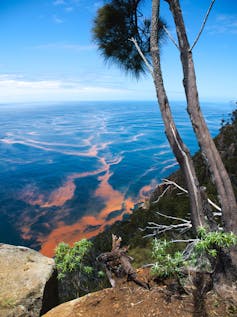
Research has linked Australia’s wildfires in 2019–2020 to extensive phytoplankton blooms in the Southern Ocean. Dust emissions can provide phytoplankton with the nutrients needed for rapid growth, leading to the formation of blooms. Such blooms can harm local marine ecosystems by reducing the oxygen content of the water.
Smoke is an obvious health concern associated with wildfires. Small, inhalable, coarse particles within smoke can cause respiratory damage. Research links airborne particulate matter to over two million deaths worldwide each year.
Fine dust particles are even smaller (2.5 micrometres in diameter) and pose a similar threat. The researchers suggest that the risks posed by large wildfires to human health may extend well beyond the immediate plume of smoke and may continue long after the smoke has cleared.
Does Climate Change Have A Role?
It might be tempting to ascribe the observed increase in the duration of post-fire dust events to our warming climate. Climate change can make hot and dry weather conditions more common and create the conditions for dangerous wildfires.
Yet the researchers are cautious to adopt this explanation. They note only that enhanced dust emissions correlate with the number of previous fires at a given location.
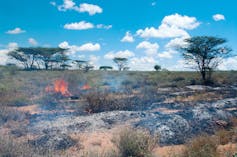
Fire is a natural part of many ecosystems and evidence for increasing wildfire frequency is complex. Savannah ecosystems, which the study identifies as the landscape most prone to post-fire dust emissions, owe their existence to the presence of fire. Regular fires remove young trees and return the grassland community to its original state.
Determining whether a wildfire has been caused by direct human actions or climate change is also difficult. Just as for climate change, human actions can influence wildfire activity. The use of fire to burn farming or logging residue, for example, increases the risk of wildfire.
Scientists increasingly understand that wildfires are a feature of the natural world. But their impacts can be dangerous and extend well beyond the margins of the fire itself.![]()
Matt Telfer, Associate Professor of Physical Geography, University of Plymouth
This article is republished from The Conversation under a Creative Commons license. Read the original article.
How to design clean energy subsidies that work – without wasting money on free riders
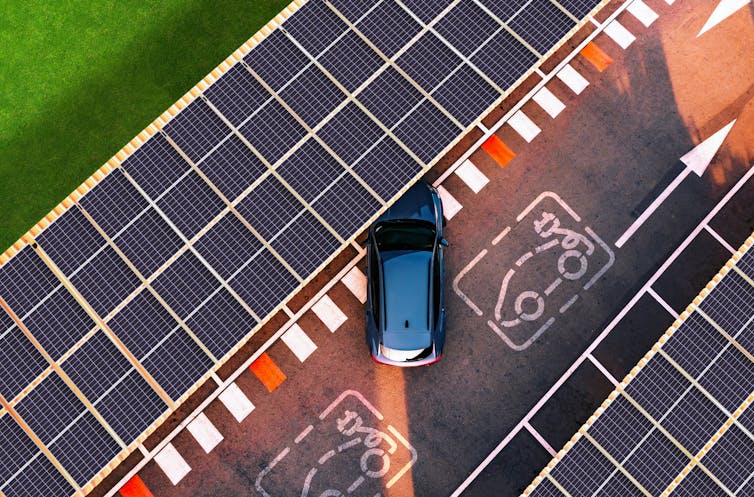
The planet is heating up as greenhouse gas emissions rise, contributing to extreme heat waves and once-unimaginable flooding. Yet despite the risks, countries’ policies are not on track to keep global warming in check.
The problem isn’t a lack of technology. The International Energy Agency recently released a detailed analysis of the clean energy technology needed to lower greenhouse gas emissions to net zero globally by 2050. What’s needed, the IEA says, is significant government support to boost solar and wind power, electric vehicles, heat pumps and a variety of other technologies for a rapid energy transition.
One politically popular tool for providing that government support is the subsidy. The U.S. government’s new Inflation Reduction Act is a multibillion-dollar example, packed with financial incentives to encourage people to buy electric vehicles, solar panels and more.
But just how big do governments’ clean energy subsidies need to be to meet their goals, and how long are they needed?
Our research points to three important answers for any government considering clean energy subsidies – and for citizens keeping an eye on their progress.
Why Subsidize At All?
An obvious first question is: Why should governments subsidize clean energy at all?
The most direct answer is that clean energy helps to reduce harmful emissions – both of gases that cause local pollution and of those that warm the planet.
Reducing emissions helps to lower both public health costs and damage from climate change, which justifies government spending. Reports have estimated that the U.S. spends US$820 billion a year just on health costs associated with air pollution and climate change. Globally, the World Health Organization estimated that the costs reached $5.1 trillion in 2018. Taxing and regulating polluting industries can also cut emissions, but carrots are often more politically popular than sticks.

A less obvious reason for subsidies is that government support can help a new and initially expensive technology become competitive in the market.
Governments have been central to the development of many technologies that are pervasive today, including microchips, the internet, solar panels and GPS. Microchips were fantastically expensive when first developed in the 1950s. Demand from the U.S. military and NASA, which could pay the high price, fueled the growth of the industry, and costs eventually dropped enough that they’re now found in everything from cars to toasters.
Government support has also helped to bring down the cost of solar power. Rooftop solar system costs fell 64% from 2010 to 2020 in the U.S. because cells became more efficient and higher volumes drove prices down.
How Much Money?
So, subsidies can work, but what’s the right amount?
Too low, and a subsidy has no effect. Giving everyone a coupon for $1 off an electric car won’t change anyone’s buying plans. But subsidies can also be set too high.
The government doesn’t need to spend money persuading consumers who already plan to buy an electric car and can afford one, yet studies show clean energy subsidies disproportionately go to richer people. When people who would have purchased the item anyway receive subsidies, they’re known as “free riders.”
The ideal subsidy attracts new buyers while avoiding free riders and overspending on people who are already convinced. The subsidy can only work when it convinces a previously uninterested consumer to buy a product.
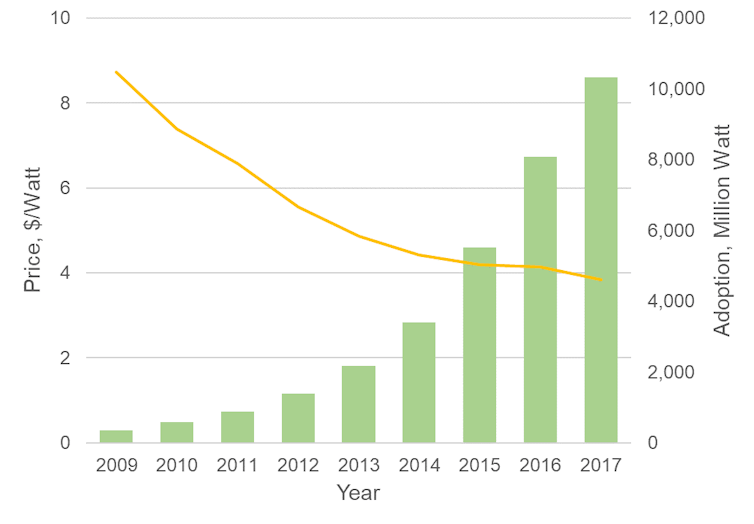
How Long Should Subsidies Last?
Timing is also important when thinking about the size of subsidies. When a promising technology is new and expensive, free riders are less of an issue. A large subsidy may be needed to attract even a few buyers, build out the emerging market and support the industry’s growth.
Solar power is a good example: In 2005, solar was several times more expensive than traditional electricity sources. Subsidies, like the 30% Investment Tax Credit established that year, helped lower the cost, and today’s solar is about one-tenth the price and cost-competitive with other electricity sources.
Once a clean technology is competitive, subsidies can still play an important role in speeding up the energy transition, but at a lower level than in the past.
In our research on residential solar panels, we estimate that the ideal subsidy for rooftop solar should have been initially higher than the actual federal tax credit but fall more quickly, declining to zero after 14 years from its start date.
By starting the subsidy about 20% higher, our models found that it would have boosted production faster, which would cut costs faster and reduce the need for high future subsidies.
Should Subsidies Eventually Disappear?
It makes sense for subsidies to disappear altogether once a technology is sufficiently cost-competitive. However, even if a technology is competitive, it might be worth further subsidy if the speed of adoption is important.
The argument for continuing a subsidy depends on whether the additional adoption it stimulates is cost-effective in reducing emissions. Wind power is cheaper than fossil fuel power in many parts of the country. Even so, we found that continuing subsidies for wind power would lead to valuable emission benefits.
That said, sometimes subsidies stick around when they shouldn’t.
Fossil fuels have been heavily subsidized for decades, despite their harm to human health, the environment and the climate, all of which raise public costs. Governments globally spent almost $700 billion on fossil fuel subsidies in 2021. The U.S. government, in recent years, has spent more on renewable energy tax credits than fossil fuels, which is a promising transition of government support.
Global Impact
While the U.S. was the focus of our solar subsidy research, this way of thinking – balancing the costs and benefits of subsidies – can be applied in other nations to design better subsidies for clean energy technologies.
The subsidy is just one policy tool, but it is an important one for both stimulating early-stage technologies and accelerating deployment of more competitive options. As the world attempts the fastest energy transition in history, today’s energy subsidy decisions will affect its ability to succeed.![]()
Eric Hittinger, Associate Professor of Public Policy, Rochester Institute of Technology; Eric Williams, Professor of Sustainability, Rochester Institute of Technology; Qing Miao, Associate Professor of Public Policy, Rochester Institute of Technology, and Tiruwork B. Tibebu, Ph.D. Student, Rochester Institute of Technology
This article is republished from The Conversation under a Creative Commons license. Read the original article.
What planting tomatoes shows us about climate change

There’s a piece of gardening lore in my hometown which has been passed down for generations: never plant your tomatoes before Show Day, which, in Tasmania, is the fourth Saturday in October. If you’re foolhardy enough to plant them earlier, your tomato seedlings will suffer during the cold nights and won’t grow.
But does this kind of seasonal wisdom still work as the climate warps? We often talk about climate change in large-scale ways – how much the global average surface temperature will increase.
Nations are trying to keep the temperature rise well under 2℃. Taken as an average, that sounds tiny – after all, the temperature varies much more than that when day gives way to night. But remember – before the industrial revolution, the world’s average surface temperature was 12.1℃. Now it’s almost a degree hotter – and could be up to 3℃ hotter by the end of the century if high emissions continue.
For many of us, climate change can seem abstract. But the natural world is very sensitive to temperature change. Wherever we look, we can see that the seasons are changing. Gardening lore no longer holds. Flowering may happen earlier. Many species have to move or die. Here’s what you might notice.

Spring Is Coming Earlier
Warmer temperatures mean spring is arriving earlier and earlier. In Australia, it’s also now five days shorter than the 1950–1969 period, according to Australia Institute research. Trees and plants put out new leaves days earlier.
For some Australian plants, earlier spring means early flowering and fruiting – an average of 9.7 days earlier per decade.
Japan’s famous spring cherry blossoms are blooming earlier than they have in centuries. The cherry blossom peak last year was the earliest recorded bloom in a data record going back to the year 812.
Not only are flowers blooming earlier, birds are also migrating earlier, and may also be delaying their autumn migrations.
Summer Is Getting Hotter And Longer
A hotter planet means hotter and longer summers.
It might not feel like it this year with all the rain, but the overall trend is clear. In turn, this means bushfire risk is growing year on year, with more days of high to catastrophic fire danger. Every year for the last three decades, an extra 48,000 hectares of forest has burnt across Australia.
Longer fire seasons are making it harder to schedule fuel reduction burns, and reducing the amount of time for firefighters to rest and recover between fire seasons.
Hotter temperatures are already posing challenges for salmon farmers in Tasmania. Atlantic salmon grow best in cold water and climate change has already pushed ocean temperatures up. In summers now, the waters around Tasmania are close to the fish’s limit. Warmer summers will be a substantial challenge for salmon farmers in the future.
Hotter water has also killed off almost all Tasmania’s giant kelp, and made it possible for warm-water fish to migrate south.
For millennia, the North Pole has been covered by sea ice. This, too, is changing. Arctic sea ice is melting earlier in summer and freezing later in winter. As warming intensifies, the central Arctic is likely to go from permanent ice cover to ice free over summer by 2100.
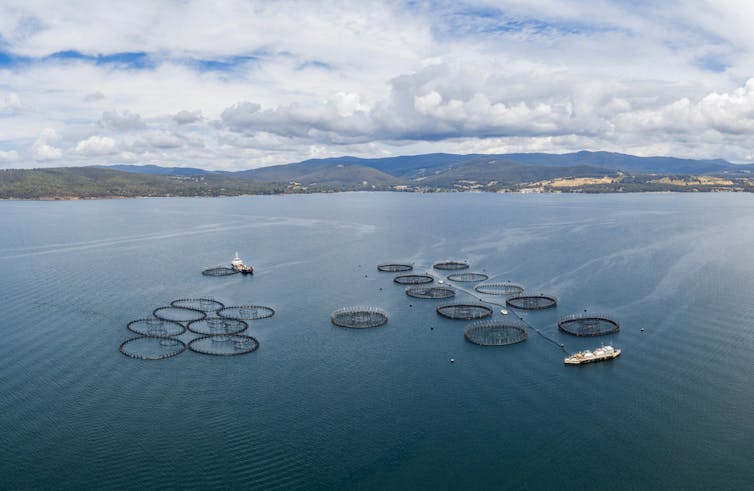
Autumn Is Falling Behind
At the beginning of autumn, the leaves of nothofagus, Australia’s only temperate deciduous tree, change colour and fall to the ground, just as many Northern Hemisphere trees do.
Here, too, we can see the climate changing. Around the world, warmer temperatures and rising atmospheric carbon dioxide are delaying the arrival of autumn colours by up to a month.
Winter Is Disappearing
Alpine species such as the mountain pygmy possum have life cycles built around winter snow, while many of the world’s cities rely on snow melt for their water supply. In Australia, snowfall has been decreasing in recent decades.
In a warmer world, there’s less snow and ice. That’s posing major challenges for cities like Santiago in Chile, as well as semi-arid areas in the United States which have relied on snowmelt.
Species Are On The Move
What else might you notice? Different animals, birds, fish and plants. Not only are the seasons changing, but many species are now found in areas they could never have survived before.
Tropical corals have now been found happily growing near Sydney. Coral reef fish, too, are heading south to areas well outside their historic range.
You can see some of the surprising new finds on the citizen science project Redmap, such as sightings of the tropical yellow bellied sea snake in Tasmanian waters.
For First Australians, climate change brings a different upheaval. The seasonal link between, say, a wattle flowering and the arrival of fish species is breaking down.
Changes Everywhere
Climate change really does mean change – both large scale and small. From extreme weather to ecosystems changing all the way through to the time when you can plant tomatoes.
For gardeners, this means accepted wisdom no longer holds. In Tasmania, you can now safely plant tomatoes 18 days earlier than you could in the 1900s. That’s because minimum temperatures in October are now about 1℃ warmer than they were in 1910.
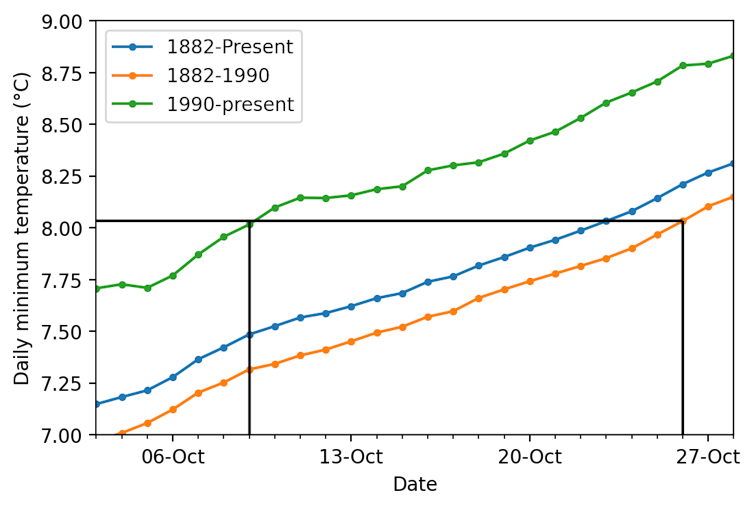
Climate change is altering our seasons and changing our world in both obvious and subtle ways.
So while planting tomatoes may seem like a trivial example, it’s yet another sign of the climate changing all around us. It’s no longer a problem for the far-off future. It’s our problem, now.![]()
Edward Doddridge, Research Associate in Physical Oceanography, University of Tasmania
This article is republished from The Conversation under a Creative Commons license. Read the original article.
Remaking our suburbs’ 1960s apartment blocks: a subtle and greener way to increase housing density

As cities grow, new buildings gradually replace the older ones. Ideally, the new buildings are higher quality, more sustainable and better suited to today’s needs. But there’s a risk current approaches to urban renewal will produce poorer amenities and buildings that are less flexible and more environmentally damaging than those they replace.
Take, for example, the 1960s walk-up apartment block. These ageing buildings are often derided for being unattractive, utilitarian and cheap.
But these buildings also have design features we have come to celebrate: narrow footprints that allow cross ventilation, flexible floorplans, minimal use of shared walls, low-maintenance design and a modest human scale. We seldom find these features in apartment developments today.
As pressure to renew ageing apartment buildings mounts, we can expect calls to rezone and redevelop these areas at higher densities to make demolition and redevelopment financially viable. We propose a more subtle and sustainable way to remake these buildings. It’s one that will allow us to increase housing density while preserving neighbourhood character.
Remaking Campsie And Its Old Brick Apartments
The New South Wales government has identified the Sydney suburb of Campsie as a strategic growth hub in the Sydenham-to-Bankstown urban renewal corridor. A projected 35,000 new homes will be required in the corridor over the next 20 years.
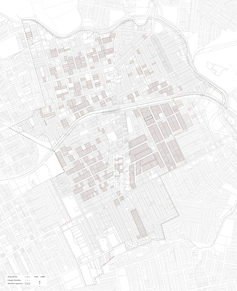
Like suburbs across Australia, Campsie has hundreds of brick apartment buildings developed in the 1960s and ’70s. How could these 350 or so housing apartment blocks (shaded areas on the map) be reimagined to provide more new homes?
We have come up with a proposal for subtle densification that could transform and preserve Campsie and the neighbouring suburbs of Belmore, Punchbowl and Earlwood. It could also be applied to suburbs with similar housing types across Australia.
Adaptive reuse reduces the damaging impacts of an all-new development. These impacts include emissions from demolition, construction and the energy used for making and transporting both the discarded and new building materials.

Four Blocks Remade As One
Remaking this awkward yet quintessential housing type offers an alternative path to medium-density living. Let’s start by looking at these apartments not as individual buildings but as groups. Four similar adjoining blocks in an adequate state are perfect candidates for intervention.
We propose to remove the fences between the blocks and create a shared collective space to join them. This new timber structure hosts half-sunk parking and common areas for everyday life. It will include a light semi-outdoor pavilion that could be used for washing, exercising, reading, gardening, hobbies, daydreaming and cooking.

It’s a straightforward architectural strategy featuring: a new steel core with stairs and lifts shared between two blocks; semi-interior spaces carved out of the building’s façade; and balconies, winter gardens and new residential units added on top of the buildings.
These new timber structures provide the most generous space possible. And, by increasing the number of dwellings, they make refurbishment financially viable.
In summary, the refurbishment operates at five levels by:
adding the common infrastructure at the heart of the four blocks
adding two new stairways
refurbishing the apartments while offering a mix of outdoor spaces, shaded areas and semi-outdoor terraces, allowing for different weather conditions and connecting seamlessly with indoor spaces
adding a layer of external spaces and winter gardens on the main facades
adding four new dwellings on the rooftop.
With some adjustments, this subtle densification would also work for individual blocks or pairs of blocks.

Higher Density Doesn’t Have To Mean Bigger Buildings
This approach challenges the idea that much bigger developments are needed to renew suburban housing and increase its density. This alternative strategy can retain existing buildings, their footprints and floor plans.
This renewal approach reduces costs and carbon footprints, while preserving the local social fabric.
Strata ownership does present challenges to this type of renewal – there may well be as many owners as there are units in these developments. Involving developers, local councils, designers, builders and communities in developing these strategies will be essential for success.
Successful Renewal Depends On Local Input
In European cities like Berlin, Paris and Zurich, urban renewal projects are being publicly driven (on public and private property) with incentives to refurbish post-war housing. Municipal and European funds are supporting these upgrades.
There is a role for Australian local councils to promote alternative approaches to urban renewal that are more sustainable than conventional models. Local and state governments might even work together to encourage this more nuanced and localised model of regeneration.
These interventions must be planned at the neighbourhood scale. Local government would provide the framework via a sensitive and detailed master plan.
In our experience, developers typically need at least six to eight levels to be interested in redevelopment after demolishing a building in this sort of neighbourhood. We are arguing for more subtle densification: refurbishment that adds no more than one or two storeys to the building. This would allow neighbourhoods to maintain buildings at three to four levels, quite similar to the existing housing.
Because the walk-up apartment building is so common in Australian suburbs, this incremental change could have a significant wider impact. It is designed to engage local owners and preserve neighbourhood life, while updating old housing to today’s needs and energy standards.![]()
Guillermo Fernández-Abascal, Academic Fellow in Architectural Practice, University of Sydney and Urtzi Grau, Senior Lecturer, Director of The Master of Architecture, University of Technology Sydney
This article is republished from The Conversation under a Creative Commons license. Read the original article.
Queensland’s high-tech plan to make the 2032 Brisbane Olympic Games smarter and greener

With Brisbane to host the 2032 Olympic Games, Queensland is accelerating “smart” and “green” infrastructure projects right across the coast from Coolangatta to Coolum.
So what practical steps is the state government taking to bring Brisbane closer to being a smart city while managing rapid growth? And what differences can city residents realistically expect to see for themselves?
Exploiting A Quarter Century Of Technological Progress
Vastly more ambitious than the South Bank building boom, which preceded Brisbane’s World Expo 88 in the pre-internet era, Queensland’s current infrastructure programs are exploiting the last quarter-century of technological progress.
Think sensor-triggered street lights, automated air conditioning and watering of parks and green facades. Envision robots for cleaning and construction, satmaps, swipe cards and QR codes. Data technology will be embedded in 32 existing and planned Olympic venues, the future athletes’ village at Northshore Hamilton (near Breakfast Creek) and the international media centres.

Technology will also underpin a substantial city centre at Maroochydore. Here, a mid-rise precinct will be powered via a solar farm at nearby Valdora, and will include fibre-optic telecommunications cables. In what may be a first for Australia, a new system will sluice garbage from chutes through underground vacuum pipes.
A ‘New Norm’ Olympics
All Games facilities must align with a set of 118 reforms the International Olympic Committee (IOC) calls its “New Norm” guidelines.
These were introduced in 2018 to improve energy efficiency, cost-effectiveness and long-term value from the huge development expenditure required of host governments. There had been concerns about integrity and wastefulness in the IOC’s old-school supervision of Games bidding and delivery processes.
Brisbane’s Games win is accelerating and expanding some major public mobility programs offering “turn up and go” transport routes for the 4.4 million people expected to live in South-East Queensland by 2031.
Aerial Taxis Without Pilots
The most provocative proposal – still speculative – is to introduce aerial taxis to fly passengers without pilots, but remotely supervised, between future “vertiports”.

A prototype eVTOL (electric vertical take-off and landing) aircraft is in Brisbane while its American manufacturer, Wisk Aero, seeks approval from the Civil Aviation Safety Authority to operate commercially before the 2032 Games.
Wisk (backed by Boeing) has completed more than 1,600 test flights with six generations of aircraft. The Brisbane model has 12 lift fans on two 15-metre wings and is powered by a battery in the tail.
Delegates at a recent Smart Cities Council transport workshop I attended noted the potential of autonomous aerial vehicles to change patterns of housing development beyond road and rail links. Even so, Queensland is rapidly expanding its terrestrial network.
Land Transport Projects
Brisbane’s Cross River Rail line is being extended northwards through a new twin tunnel under Brisbane River and four new underground stations at Boggo Road, Woolloongabba, Albert Street and Roma Street.
This project uses smart tunnel-boring machines to carve through the tuff (a type of volcanic rock, pronounced toof) that formed Brisbane’s geology more than 200 million years ago.
As well as supporting the new health, science and education precinct near Boggo Road, this rail extension will connect the city’s southern suburbs with the existing line north from Bowen Hills.

And work continues on extending the Brisbane-to-Gold Coast light railway (also known as the G:Link).
This extension will provide eight new stations along a 6.7km track from Broadbeach to Burleigh Heads. The G:Link service uses German Bombardier Flexity carriages that are bi-directional and air-conditioned, with low-level floors matching station platforms and storage for wheelchairs, bikes, prams and surfboards. These are electric-powered via 750V overhead cables.
Superfast Bus Charging
More innovative is the Brisbane Metro project, which is being tested to potentially supply 60 electric buses (or “trackless trams”) to supplement the city’s existing fleet. These would be battery-powered by a combination of 600kW, six-minute, superfast “flash chargers” at end-of-line stations and 50kW, overnight, slow chargers at depots.

Each bus can be recharged up to 85 times faster than an electric car at home – but the flash system degrades batteries more than slow charging overnight.

Healthy Footbridges
Although two of Brisbane’s four proposed “green bridges” for pedestrians and cyclists were paused to prioritise flood recovery, new crossings from the city to Kangaroo Point and Newstead to Albion are expected to open in 2024.

The Kangaroo Point green bridge will include a restaurant overlooking the botanic gardens. Newstead bridge will join the 1.2km-long Lores Bonney Riverwalk.
These are examples of a new phenomenon in public transport planning – to not merely move people between destinations but also boost their health and enjoyment outdoors.
As Corey Gray, global CEO of the Smart Cities Council, told me at the Smart Cities Council conference:
Smart cities are not ultimately about data and technology, but improving human systems.
Davina Jackson, Visiting Scholar, Department of Architecture, University of Cambridge
This article is republished from The Conversation under a Creative Commons license. Read the original article.
What mirrored ants, vivid blue butterflies and Monstera house plants can teach us about designing buildings

Almost all buildings today are built using similar conventional technologies and manufacturing and construction processes. These processes use a lot of energy and produce huge carbon emissions.
This is hardly sustainable. Perhaps the only way to truly construct sustainable buildings is by connecting them with nature, not isolating them from it. This is where the field of bioarchitecture emerges. It draws on principles from nature to help solve technological questions and address global challenges.
Take desert organisms, for example. How do they survive and thrive under extreme conditions?
One such desert species is the Saharan silver ant, named for its shiny mirror-like body. Its reflective body reflects and dissipates heat. It’s an adaptation we can apply in buildings as reflective walls, or to pavements that don’t heat up.
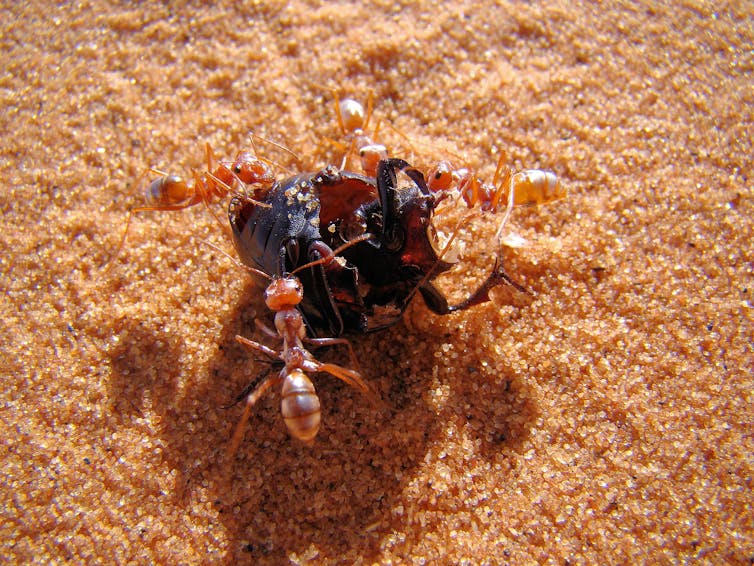
There are so many aspects of nature we can drawn on. Picture cities with shopping centres based on water lilies, stadiums resembling seashells, and lightweight bridges inspired by cells.
Water lilies can teach us how to design large buildings efficiently with smooth pedestrian circulation. Seashells can inspire the walls of large-span buildings without the need for columns. Cells can show us how to develop lightweight suspending structures.
Bioarchitecture Works With Nature, Not Against It
Bioarchitecture can reinvent the natural environment in the form of our built environment, to provide the ultimate and somehow obvious solutions for the threats Earth is facing.
Most industry-led and research-based approaches focus on the “technology to save us” from climate change. In contrast, bioarchitecture offers a more sustainable approach that aims to develop a positive relationship between buildings and nature.
Living organisms constantly communicate with the natural world. They move around their environment, employ chemical processes and undergo complex reactions, patterning their habitat. This means living systems constantly model and organise the environment around them. They are able to adapt and, in doing so, they change their environment too.
Can buildings do the same in cities? If buildings could grow, self-repair and adapt to climate, they might ultimately become truly sustainable.
Early examples of bioarchitecture can be found in traditional and early modern buildings. Their architects observed nature to copy its principles and design more habitable, locally made and environmentally friendly buildings. For example, Gaudi’s Sagrada Familia in Barcelona, Spain, is inspired by natural shapes that give the church its organic form.

More recent works showcase bioarchitecture that learnt from nature coupled with technology and innovation. Examples include using bio-based materials such as wood, hemp and bamboo, applying biophilia through using greenery on external walls and plants indoors to boost our connection with nature, and restoring the environment by making buildings part of it.
Considering the climate emergency, we should strengthen buildings’ coherence with nature. Bioarchitecture can do this.
So What Can A Butterfly Teach Us?
The blue Menelaus butterfly offers another striking example of design solutions from nature. Despite its radiant blue colour, it is not actually blue and does not have any pigments. Producing and maintaining pigments is expensive in nature, as it requires a lot of energy.
The Menelaus butterfly has an ingenious way to achieve its unique colour without pigments. Its brilliant blue shine comes from scattering light, similar to soap bubbles glimmering in rainbow colours under the sun, despite being completely transparent. The light is scattered by micro-grooves on the butterfly’s wings – so small that they can only be seen with an ultra-high-resolution microscope.

This is nature’s way to achieve high performance with cheap forms instead of costly materials. Learning from the Menelaus butterfly, we can have windows with climate-adaptable properties – changing their colour and scattering light according to the position of the sun. Butterfly wings have already inspired the development of new materials, and the next step is to use these on buildings.
In this way, we can design biobuildings that reflect excessive radiation and reduce cooling needs and glare. And the beautiful part is that this may all be done without obstructing views and without the need for shading devices or tinted windows.
And What Does A Pot Plant Have To Do With Buildings?

Then there is Monstera, a sought-after indoor plant that climbs up the walls. It’s also called the “Swiss cheese plant” for the holes on its leaves. Have you ever thought about how it thrives and grows like no other plant indoors?
Monstera simply needs to sustain fewer cells to maintain extra large leaves because of their holes. This enables it to capture more of the sunlight it needs to grow and spread out over a bigger area.
Now imagine if we designed hollow building structures such as columns and beams. This could help minimise the need for materials and cut carbon emissions by reducing the embodied energy that goes into making these materials.
Nature Offers A Vast Design Catalogue
We can look at nature as a catalogue of designs and solutions to be reimagined as bioarchitecture. So, we could have shiny silver pavements like the silver ant, metallic-coloured but transparent windows like the Menelaus butterfly, and buildings that use the minimum of materials like Monstera’s leaves.
Nature is wealthy, nature is generous. Through bioarchitecture, buildings can dive into that wealth and become a part of the generosity. Truly sustainable biobuildings can be constructed that work with nature and reverse the harm our conventional building technologies have done to the planet.![]()
Aysu Kuru, Lecturer in Architecture and Construction, University of Sydney
This article is republished from The Conversation under a Creative Commons license. Read the original article.
Pittwater Reserves: Histories + Notes + Pictorial Walks
A History Of The Campaign For Preservation Of The Warriewood Escarpment by David Palmer OAM and Angus Gordon OAM
America Bay Track Walk - photos by Joe Mills
An Aquatic June: North Narrabeen - Turimetta - Collaroy photos by Joe Mills
Angophora Reserve Angophora Reserve Flowers Grand Old Tree Of Angophora Reserve Falls Back To The Earth - History page
Annie Wyatt Reserve - A Pictorial
Avalon's Village Green: Avalon Park Becomes Dunbar Park - Some History + Toongari Reserve and Catalpa Reserve
Bairne Walking Track Ku-Ring-Gai Chase NP by Kevin Murray
Bangalley Headland Bangalley Mid Winter
Banksias of Pittwater
Barrenjoey Boathouse In Governor Phillip Park Part Of Our Community For 75 Years: Photos From The Collection Of Russell Walton, Son Of Victor Walton
Barrenjoey Headland: Spring flowers
Barrenjoey Headland after fire
Bayview Baths
Bayview Wetlands
Beeby Park
Bilgola Beach
Botham Beach by Barbara Davies
Bungan Beach Bush Care
Careel Bay Saltmarsh plants
Careel Bay Birds
Careel Bay Clean Up day
Careel Bay Playing Fields History and Current
Careel Creek
Careel Creek - If you rebuild it they will come
Centre trail in Ku-ring-gai Chase National Park
Chiltern Track- Ingleside by Marita Macrae
Clareville Beach
Clareville/Long Beach Reserve + some History
Coastal Stability Series: Cabbage Tree Bay To Barrenjoey To Observation Point by John Illingsworth, Pittwater Pathways, and Dr. Peter Mitchell OAM
Cowan Track by Kevin Murray
Curl Curl To Freshwater Walk: October 2021 by Kevin Murray and Joe Mills
Currawong and Palm Beach Views - Winter 2018
Currawong-Mackerel-The Basin A Stroll In Early November 2021 - photos by Selena Griffith
Currawong State Park Currawong Beach + Currawong Creek
Deep Creek To Warriewood Walk photos by Joe Mills
Drone Gives A New View On Coastal Stability; Bungan: Bungan Headland To Newport Beach + Bilgola: North Newport Beach To Avalon + Bangalley: Avalon Headland To Palm Beach
Duck Holes: McCarrs Creek by Joe Mills
Dunbar Park - Some History + Toongari Reserve and Catalpa Reserve
Dundundra Falls Reserve: August 2020 photos by Selena Griffith - Listed in 1935
Elsie Track, Scotland Island
Elvina Track in Late Winter 2019 by Penny Gleen
Elvina Bay Walking Track: Spring 2020 photos by Joe Mills
Elvina Bay-Lovett Bay Loop Spring 2020 by Kevin Murray and Joe Mills
Fern Creek - Ingleside Escarpment To Warriewood Walk + Some History photos by Joe Mills
Iluka Park, Woorak Park, Pittwater Park, Sand Point Reserve, Snapperman Beach Reserve - Palm Beach: Some History
Ingleside
Ingleside Wildflowers August 2013
Irrawong - Ingleside Escarpment Trail Walk Spring 2020 photos by Joe Mills
Irrawong - Mullet Creek Restoration
Katandra Bushland Sanctuary - Ingleside
Lucinda Park, Palm Beach: Some History + 2022 Pictures
McCarrs Creek
McCarr's Creek to Church Point to Bayview Waterfront Path
McKay Reserve
Mona Vale Beach - A Stroll Along, Spring 2021 by Kevin Murray
Mona Vale Headland, Basin and Beach Restoration
Mount Murray Anderson Walking Track by Kevin Murray and Joe Mills
Mullet Creek
Narrabeen Creek
Narrabeen Lagoon Catchment: Past Notes Present Photos by Margaret Woods
Narrabeen Lagoon State Park
Narrabeen Lagoon State Park Expansion
Narrabeen Rockshelf Aquatic Reserve
Nerang Track, Terrey Hills by Bea Pierce
Newport Bushlink - the Crown of the Hill Linked Reserves
Newport Community Garden - Woolcott Reserve
Newport to Bilgola Bushlink 'From The Crown To The Sea' Paths: Founded In 1956 - A Tip and Quarry Becomes Green Space For People and Wildlife
Pittwater spring: waterbirds return to Wetlands
Pittwater's Lone Rangers - 120 Years of Ku-Ring-Gai Chase and the Men of Flowers Inspired by Eccleston Du Faur
Pittwater's Parallel Estuary - The Cowan 'Creek
Resolute Track at West Head by Kevin Murray
Resolute Track Stroll by Joe Mills
Riddle Reserve, Bayview
Salvation Loop Trail, Ku-Ring-Gai Chase National Park- Spring 2020 - by Selena Griffith
Seagull Pair At Turimetta Beach: Spring Is In The Air!
Stapleton Reserve
Stapleton Park Reserve In Spring 2020: An Urban Ark Of Plants Found Nowhere Else
Stony Range Regional Botanical Garden: Some History On How A Reserve Became An Australian Plant Park
The Chiltern Track
The Resolute Beach Loop Track At West Head In Ku-Ring-Gai Chase National Park by Kevin Murray
Topham Track Ku-Ring-Gai Chase NP, August 2022 by Joe Mills and Kevin Murray
Towlers Bay Walking Track by Joe Mills
Trafalgar Square, Newport: A 'Commons' Park Dedicated By Private Landholders - The Green Heart Of This Community
Tranquil Turimetta Beach, April 2022 by Joe Mills
Turimetta Beach Reserve by Joe Mills, Bea Pierce and Lesley
Turimetta Beach Reserve: Old & New Images (by Kevin Murray) + Some History
Turimetta Headland
Warriewood Wetlands and Irrawong Reserve
Whale Beach Ocean Reserve: 'The Strand' - Some History On Another Great Protected Pittwater Reserve
Wilshire Park Palm Beach: Some History + Photos From May 2022
Winji Jimmi - Water Maze

New Shorebirds WingThing For Youngsters Available To Download
A Shorebirds WingThing educational brochure for kids (A5) helps children learn about shorebirds, their life and journey. The 2021 revised brochure version was published in February 2021 and is available now. You can download a file copy here.
If you would like a free print copy of this brochure, please send a self-addressed envelope with A$1.10 postage (or larger if you would like it unfolded) affixed to: BirdLife Australia, Shorebird WingThing Request, 2-05Shorebird WingThing/60 Leicester St, Carlton VIC 3053.

 Shorebird Identification Booklet
Shorebird Identification Booklet
The Migratory Shorebird Program has just released the third edition of its hugely popular Shorebird Identification Booklet. The team has thoroughly revised and updated this pocket-sized companion for all shorebird counters and interested birders, with lots of useful information on our most common shorebirds, key identification features, sighting distribution maps and short articles on some of BirdLife’s shorebird activities.
The booklet can be downloaded here in PDF file format: http://www.birdlife.org.au/documents/Shorebird_ID_Booklet_V3.pdf
Paper copies can be ordered as well, see http://www.birdlife.org.au/projects/shorebirds-2020/counter-resources for details.
Download BirdLife Australia's children’s education kit to help them learn more about our wading birdlife
Shorebirds are a group of wading birds that can be found feeding on swamps, tidal mudflats, estuaries, beaches and open country. For many people, shorebirds are just those brown birds feeding a long way out on the mud but they are actually a remarkably diverse collection of birds including stilts, sandpipers, snipe, curlews, godwits, plovers and oystercatchers. Each species is superbly adapted to suit its preferred habitat. The Red-necked Stint is as small as a sparrow, with relatively short legs and bill that it pecks food from the surface of the mud with, whereas the Eastern Curlew is over two feet long with a exceptionally long legs and a massively curved beak that it thrusts deep down into the mud to pull out crabs, worms and other creatures hidden below the surface.
Some shorebirds are fairly drab in plumage, especially when they are visiting Australia in their non-breeding season, but when they migrate to their Arctic nesting grounds, they develop a vibrant flush of bright colours to attract a mate. We have 37 types of shorebirds that annually migrate to Australia on some of the most lengthy and arduous journeys in the animal kingdom, but there are also 18 shorebirds that call Australia home all year round.
What all our shorebirds have in common—be they large or small, seasoned traveller or homebody, brightly coloured or in muted tones—is that each species needs adequate safe areas where they can successfully feed and breed.
The National Shorebird Monitoring Program is managed and supported by BirdLife Australia.
This project is supported by Glenelg Hopkins Catchment Management Authority and Hunter Local Land Services through funding from the Australian Government’s National Landcare Program. Funding from Helen Macpherson Smith Trust and Port Phillip Bay Fund is acknowledged.
The National Shorebird Monitoring Program is made possible with the help of over 1,600 volunteers working in coastal and inland habitats all over Australia.
The National Shorebird Monitoring program (started as the Shorebirds 2020 project initiated to re-invigorate monitoring around Australia) is raising awareness of how incredible shorebirds are, and actively engaging the community to participate in gathering information needed to conserve shorebirds.
In the short term, the destruction of tidal ecosystems will need to be stopped, and our program is designed to strengthen the case for protecting these important habitats.
In the long term, there will be a need to mitigate against the likely effects of climate change on a species that travels across the entire range of latitudes where impacts are likely.
The identification and protection of critical areas for shorebirds will need to continue in order to guard against the potential threats associated with habitats in close proximity to nearly half the human population.
Here in Australia, the place where these birds grow up and spend most of their lives, continued monitoring is necessary to inform the best management practice to maintain shorebird populations.
BirdLife Australia believe that we can help secure a brighter future for these remarkable birds by educating stakeholders, gathering information on how and why shorebird populations are changing, and working to grow the community of people who care about shorebirds.
To find out more visit: http://www.birdlife.org.au/projects/shorebirds-2020/shorebirds-2020-program
Aussie Bread Tags Collection Points

The Australian Magpie: Our Suburban Caroller
Although this wonderful suburban bird may be often taken for granted, it has a LOT going for it and is one of our most beautiful and musical suburban birds and also one of the few suburban birds that offers 'protection for other birds in a way as the yellow-rumped thornbill (Acanthiza chrysorrhoa), willie wagtail (Rhipidura leucophrys), southern whiteface (Aphelocephala leucopsis), and (less commonly) noisy miner (Manorina melanocephala), often nest in the same tree as the magpie.
A pair of magpies will mate for life and often return to the same tree year after year o use as a nesting place. Once the eggs hatch the young remain in the nest for about 4 weeks while being fed by the mum. During this time the nest is defended by the male. The family group will help protect and educate the young with the dad teaching them foraging skills.
The young magpies, once they leave home, will move around together in a group called a 'tribe' although the collective word for a group of magpies is also listed as 'tidings'.
As one of Australia's most accomplished songbirds, the Australian magpie has an array of complex vocalisations. It is omnivorous, with the bulk of its varied diet made up of invertebrates (insects) although it will eat seed, tubers, walnuts and figs.
On the ground, the Australian magpie moves around by walking, and is the only member of the Artamidae to do so; woodswallows, butcherbirds and currawongs all tend to hop with legs parallel. The magpie has a short femur (thigh bone), and long lower leg below the knee, suited to walking rather than running, although birds can run in short bursts when hunting prey.
The Australian magpie was first described in the scientific literature by English ornithologist John Latham in 1801 as Coracias tibicen, the type collected in the Port Jackson region. Its specific epithet derived from the Latin tibicen "flute-player" or "piper" in reference to the bird's melodious call. An early recorded vernacular name is piping poller, written on a painting by Thomas Watling, one of a group known collectively as the Port Jackson Painter, sometime between 1788 and 1792. Other names used include piping crow-shrike, piping shrike, piper, maggie, flute-bird and organ-bird. The term bell-magpie was proposed to help distinguish it from the European magpie but failed to gain wide acceptance.
Port Jackson, consisting of the waters of Sydney Harbour, Middle Harbour, North Harbour and the Lane Cove and Parramatta Rivers, is the ria or natural harbour of Sydney.
Artamidae is a family of passerine birds found in Australia, the Indo-Pacific region, and Southern Asia. It includes 24 extant species in six genera and three subfamilies: Peltopsinae (with one genus, Peltops), Artaminae (with one genus containing the woodswallows) and Cracticinae (currawongs, butcherbirds and the Australian magpie). Artamids used to be monotypic, containing only the woodswallows, but it was expanded to include the family Cracticidae in 1994.
The word 'Artamidae' means 'wood swallows'.
There are also a lot of old stories associated with this bird.
In the old languages of this island home, according the Noongar Dreaming of Western Australia, the sky was once so close to the ground that trees could not grow, people had to crawl and all the birds were forced to walk everywhere. Working together the birds managed to prop up the sky with sticks, but it threatened to break the sticks and collapse to earth again. The magpies, known for being clever, took a long stick in their beaks and pushed it up and up until the sky sprang into its proper place, revealing the sun and, with it, the first dawn.
The magpies' lovely carolling singing each morning is to remind everybody of their important role in creation. Their unique song is reflected in its Noongar name: "Coolbardie". Similarly, the mining town of Coolgardie means "magpie" in the local Aboriginal dialect.
In Queensland the indigenous peoples of the Cloncurry district (N. Q.) have a strange legend concerning the moon. They believe that in the past, and before white men mixed with them, all indigenous peoples were turkeys.
One of them happened to damage his foot very badly, and asked a female aboriginal, then a cockatoo parrot, if she knew where the nearest water could be found. She said, "There is no water here." He then asked a green parrot if he knew where the water was, and as his foot was becoming more painful he requested him to cut it open, but the green parrot said that he was unable to do this. He thereupon successively appealed to the crow (an aboriginal doctor), an eagle-hawk, and the moon (white-fellow doctor), to render him the necessary assistance, but they all said that they could not undertake the job.
As a last chance he begged the earth-grub to give him relief. The grub promised to do his best, and he bit into the swollen flesh, sucked all the putrid matter out, and cured the patient. A large corroboree was then held, and galahs, storm-birds, white and black cockatoos, butcher-birds magpies, bowerbirds, opossums, porcupines and bandicoots, all took part.
While the turkey and the earth-grub together with the cloud and skies shifted their position (for the last named until then had always remained on the surface of the ground) the whole party began singing, "there goes our brother up," and of course, both creatures stayed up there! But so that the people below should always remember what a good physician he had proved himself to be, the earth-grub sends a moon regularly every month to bear him in mind, for the moon is a brother of his and like him, bores his way out of the ground, rises up again on high, sinks once more, and then dies. This worm has plenty of brothers, and so he sends a different moon every month!
Others speak of the carolling song of the magpie, telling us;
'the koolardi, or grey bell-magpie, is known in parts of the bush as the 'rain bird.' This does not appear to arise from any reputation it has made as a weather prophet, but from the fact that its notes sound like 'It's going to rain.' It is a frequent prediction of the koolardi, no matter what kind of weather it may be enjoying. By way of a change it sometimes announces that 'Two and two are four.' Its relative, the kurrawong, or pied bell-magpie, is more common. Its notes, flung out in a loud, ringing voice as it flies through the forest, sound like 'Come along! Come along!' and give the impression that it is impatient and in a hurry. The aborigines interpret the notes as 'kurrawong.' Many of their bird names are derived from, or suggested by, the birds' own notes. In some places the kurrawongs and koolardis are called scrub magpies and black magpies, though they resemble the choughs' more than the magpies.' - Sydney Mail (NSW : 1912 - 1938), Wednesday 11 July 1928, page 18
Of course, nowadays we know that magpies carol to reinstate their territory - this is the same reason kookaburras sound out at dawn and dusk - to let other birds know the tree they are in, of ten with their children, and that this is 'their place'.
However, it is this letter penned to the Sydney Morning Herald in the Spring of 1933 that celebrates this wonderful melodic music we hear from our local magpies we like best - we hope you like it too:
CAROL OF THE MAGPIE.
TO THE EDITOR OF THE HERALD.
Sir, One word more and let my excuse be the fullest recognition of Australia's finest songster-the magpie, whether he be the black and white friend we all know or the white-backed so praised by the authorities. The departure of winter has meant the departure from my valley of the "snowie," for he likes his colder home country best. Still I can find no lessening in the volume of cheery magpie song. I admit his half-brother abounds here aplenty, and this being nesting season, and both pa and ma busy putting the new shack in serviceable order, their song from tree to tree resounds the whole live-long day. Theirs is the belief that the finest work in the magpie world is the building of a home. A couple of small sticks dropped into position gives occasion for an admiring joyful chorus, then off again to work. What a pity the Broadcasting Com-mission does not add to its opening morning session the gay, hopeful carol of the magpie. The old kookaburra is good in his way, but he always sounds as if he had the laugh on us.
I must thank the correspondents to your columns for correcting my impression regarding the non-singing of the snow magpie. To those, too, who, in fond recollection of a youthful home pet, have written me personally, I offer the gratitude of a nature-lover. I cannot but admit now that the "snowie" under some conditions must warble. Most of my correspondents recount Victorian experiences. Could it be that the Victorian atmosphere had such an enheartening effect upon their bird spirits that they responded in praise to life in that more pleasant State? To the opinion of Mr. Owen Litchfield, of Cooma, I pay every respect, because he has seen with his eyes and heard with his ears what my eyes and my ears have failed to give me over the past twenty odd winters. (As I write, the black and white fellows are carolling away in the orchard in rain and cold wind as if the sun were shining in the very brightest and best of worlds, and no such thing as a depression existed).
Mr. D. G. Stead's views on nature subjects are ever enlightening. Perhaps next winter, when Kiandra's white mantle sends down to us again the annual migration. I may be able to induce him to share my corn beef and damper for a few days while we endeavour to find out the reason for the silence while here of the handsome "snowie." And he may be able to discover also what causes such great mortality among them some winters when first arriving here; they drop dead from the trees in scores, seemingly plump and health.
W. P. BLUETT.
September 16.
Brindabella.
CAROL OF THE MAGPIE. (1933, September 21). The Sydney Morning Herald (NSW : 1842 - 1954), p. 5. Retrieved from http://nla.gov.au/nla.news-article28027861
Staying Safe At Schoolies
- Leave a copy of your bank card details at home in case you lose it and have to cancel it, take your bank contact details with you so that you can report lost or stolen cards
- Make sure you’ll have enough money to cover all the essentials while you’re away, including an emergency stash
- Know where you’re staying and how you will be getting there and home again
- Have a safe place you can store any important documents or valuables while you’re away - a lockable side pocket within a bag works best
- Remember your phone charger and make sure you have plenty of credit/data, so that you can stay in touch with home or call for help if you need to - also remember to stop when packing to come home, look around you and make sure you pack that charger
- When you’ve booked your accommodation make sure your parents or carers have a copy of the details – they will want to know where you are and that you are safe
- Your ID and Drivers Licence
- Your phone charger
- A decent hat, sunscreen and mozzie repellent
- Some comfy shoes - closed in, as well as sandals/thongs - there be ants and spiders out there!
- Basic First Aid kit – band aids, safety pins and paracetamol
- Any medications you might need - leave the scripts at home so you don't lose them
- Transportable food; muesli bars, instant noodles, cup-a-soups, a mix of dried fruits and nuts
- Soap bag - deodorant, a cake of soap, shampoo, toothpaste and toothbrush, a comb, a shaver
- Reusable water bottle - carrying around the non-reusable plastic pose version is NOT fashionable any longer
- PLEASE make sure someone always knows where you are going and when to expect you back – ideally go out with a minimum of one other person or stick together as a group
- Have a way of staying in touch with your parents and contacting them in an emergency - maybe decide before heading off that you will send them a text in the morning and check in via phone call at a certain time each afternoon/evening. Remember it’s FREE to use public pay phones across Australia now. You could also give your parents contact details to a couple of your friends going away with you (and their parents too if you know them).
- When you’re out and about, stay with your friends and have a plan to meet up at a certain time and place if you lose each other in the crowd
- Be careful about who you tell where you are staying – arrange to meet new friends in a public place rather than at your accommodation
- Plan how you will get back to your accommodation and make sure you have enough money left at the end of the night to follow your plan
- If you’re walking around late at night please stick to well-lit areas
- Don’t leave your drinks unattended or accept drinks from strangers
- Don't take drugs - the only way to stay safe around drugs at Schoolies is to not take them. There is no safe level of illicit drug use – taking drugs is always risky as no one can ever be sure of what they are really taking, but more importantly, you can never know how your body will react - effects can vary between people or can give different results for the same person on different occasions
- Don't post 'stuff' to social media that you may regret having put out there the following day; keep some 'this is mine' stuff just for yourself; set profiles to ‘private’ or ‘friends only’ and only accept friend requests from people you know and trust or/and set an agreement with friends that consent must be given by all parties before uploading and/or tagging a photo and videos
- it is illegal to drink alcohol at Schoolies under the age of 18
- it’s an offence to supply alcohol to someone under the age of 18 – you could face fines of up to $10,444
- it is illegal to drink in public and to be drunk in a public place – no matter what their age - these are the laws for all of Queensland - not just during Schoolies
- under 18’s can’t carry alcohol in public (even if you’re holding it for a mate whilst he does up his shoe lace)
- it’s okay to say no – if you think you have had too much or don’t want to drink at all, just say no
- avoid mixing alcohol and medication (or any type of drug) - the side effects could be very serious
- take it in turns to have one sober friend every night
- give your body a break - just because it’s Schoolies doesn’t mean you have to drink every night (the human body is not designed to party for seven straight nights)
- when out and about, if you (or a friend) have had too much to drink, they can always ask a Safer Schoolies volunteer for assistance
- balconies can become very dangerous after drinking alcohol – stay well away from them if under the influence.
Byron Bay Schoolies 2022
 More than 6,000 school leavers are expected to celebrate the end of their formal education in Byron Bay over the Schoolies Week period which starts on 26 November 2022.
More than 6,000 school leavers are expected to celebrate the end of their formal education in Byron Bay over the Schoolies Week period which starts on 26 November 2022.Schoolies Road Safety Tips

The Rions Christmas Special 2 at Dee Why RSL
Announcing the 2nd edition of our Christmas Special show! It's happening on December 17th at Dee Why RSL (18+) and tickets are on sale now! Our last one sold out so make sure you get in quick. It's gonna be next level with special guests Molly Millington, The Good Love, Liquid Time and Chloe Dadd.
Tickets: https://tickets.oztix.com.au/outlet/event/08bfea31-2dff-4ccb-8240-b8ab3f8b5cbe

School Leavers Support
- Download or explore the SLIK here to help guide Your Career.
- School Leavers Information Kit (PDF 5.2MB).
- School Leavers Information Kit (DOCX 0.9MB).
- The SLIK has also been translated into additional languages.
- Download our information booklets if you are rural, regional and remote, Aboriginal or Torres Strait Islander, or living with disability.
- Support for Regional, Rural and Remote School Leavers (PDF 2MB).
- Support for Regional, Rural and Remote School Leavers (DOCX 0.9MB).
- Support for Aboriginal and/or Torres Strait Islander School Leavers (PDF 2MB).
- Support for Aboriginal and/or Torres Strait Islander School Leavers (DOCX 1.1MB).
- Support for School Leavers with Disability (PDF 2MB).
- Support for School Leavers with Disability (DOCX 0.9MB).
- Download the Parents and Guardian’s Guide for School Leavers, which summarises the resources and information available to help you explore all the education, training, and work options available to your young person.
School Leavers Information Service
- navigate the School Leavers Information Kit (SLIK),
- access and use the Your Career website and tools; and
- find relevant support services if needed.
Be The Boss: I Want To Be A Meteorologist
- Advise governmental and non-profit agencies, as well as private businesses and individuals, on safety during natural disasters.
- Forecast both short and long-term weather patterns and changes.
- Teach at universities or other higher-education institutions.
- Research the physics and dynamics of climate change.
- Study the atmosphere to understand weather patterns.
Graduate Meteorologist
- foundations of meteorology
- synoptic-scale meteorology
- mesoscale meteorology
- weather services and procedures.
- Forecasting and warnings for emergency services
- Supporting the Australian Defence Force
- Providing services to domestic and international aviation customers
- Supporting Australia's Antarctic operations
- Providing services to the energy and resource sector
- Offering services for the maritime industry
- Decision support services to a variety of specialised agencies
- 550 for a paper-based TOEFL
- 213 for a computer based TOEFL
- 6.5 IELTS
- A$28,700 for the Basic Instruction Package for Meteorologists
- A$35,400 for the Graduate Diploma in Meteorology (includes the Basic Instruction Package)
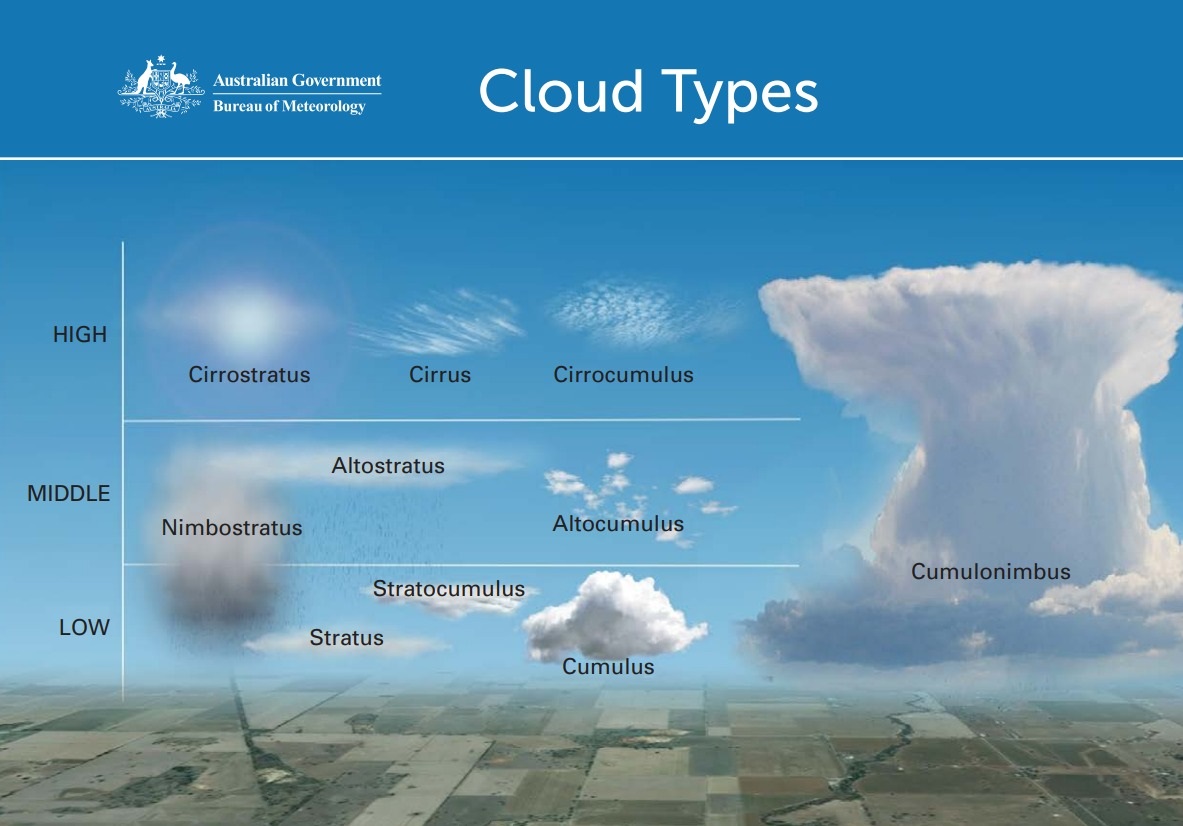
Summer Skills Fee Free Courses
Summer Skills is a fee-free* short course program to support school leavers, aged between 15 – 24 years, obtain job-ready skills over the summer months.
Whether you plan to attend TAFE NSW, university, have a gap year or are still undecided, we have a course that can give you the skills for a brighter future.
Priority industry areas have been identified under Skilling for Recovery and include short courses in Early Childhood Care, Aged Care, Disability, Hospitality, Construction, Agriculture, Business and Administration, IT and Digital, Retail, Transport and Logistics, Manufacturing/Engineering and Sport and Recreation.
For example - starting November 23, 2022 at Ryde: STATEMENT OF ATTAINMENT IN COMMERCIAL COOKERY BASICS
Or starting November 24th at Ryde: STATEMENT OF ATTAINMENT IN ESPRESSO COFFEE
Find out more at: https://www.tafensw.edu.au/summer-skills
Also Available:
- Be The Boss: I Want To Be A Video Game Designer
- Be the Boss: I Want To Be A Baker
- Be The Boss: I Want To Be An Information Technology Administrator
- Be The Boss: I Want To Be An Architect
- Be The Boss: I Want to Be a Marine Electrician
- Be The Boss: I want To Be A Cabinet Maker
- Be The Boss: I Want To Be An Automotive Mechanic
- Be The Boss: I Want To Be A Biotechnologist
- Be The Boss: I Want To Be A Pilot
- Be The Boss: I Want To Be A Music Producer
- Be The Boss: I Want To Be A Gardener
- Be The Boss: I Want To Be A Builder
- Be The Boss: I Want To Be A Confectioner
- Be The Boss: I Want To Be A Ship's Captain
Word Of The Week: Bark
noun; 1. the sharp explosive cry of a dog, fox, or seal.
verb; 1. (of a dog, fox, or seal) give a bark. 2. utter (a command or question) abruptly or aggressively.
.jpg?timestamp=1669272783474)

noun: bark; 1. the tough protective outer sheath of the trunk, branches, and twigs of a tree or woody shrub. 2. thin sheets of chocolate topped with ingredients such as nuts, confectionery, and dried fruit and broken into irregularly shaped pieces
From: Old English beorc (noun), beorcan (verb), of Germanic origin; possibly related to break
verb. 1. strip the bark from (a tree or piece of wood). 2. (Technical)tan or dye (leather or other materials) using the tannins found in bark. Middle English: from Old Norse bǫrkr ; perhaps related to birch.
From: Middle English: from Old Norse bǫrkr ; perhaps related to birch.
Archaic
noun: bark; plural noun: barks; a ship or boat; a sailing ship, typically with three masts, in which the foremast and mainmast are square-rigged and the mizzenmast is rigged fore and aft.
From: late Middle English: variant of barque. Middle English: from Old French, probably from Provençal barca, from late Latin barca ‘ship's boat’.
In the 18th century, the Royal Navy used the term bark for a nondescript vessel that did not fit any of its usual categories. Thus, when the British admiralty purchased a collier for use by James Cook in his journey of exploration, she was registered as HM Bark Endeavour to distinguish her from another Endeavour, a sloop already in service at the time. She happened to be a full-rigged ship with a plain bluff bow and a full stern with windows.
William Falconer's Dictionary of the Marine defined "bark", as "A general name given to small ships: it is however peculiarly appropriated by seamen to those which carry three masts without a mizzen topsail. Our Northern Mariners, who are trained in the coal-trade, apply this distinction to a broad-sterned ship, which carries no ornamental figure on the stem or prow."

A 1993 replica of HM Bark Endeavour. Photo: John M Wheatley.
Mukbang, #EatWithMe and eating disorders on TikTok: why online food consumption videos could fuel food fixations

You might have come across #EatWithMe videos on TikTok, which typically feature young women eating food while encouraging viewers to eat along with them. Many such content creators say they aim to help people with eating disorders overcome their fear of food.
But some videos tagged #EatWithMe also feature the hashtag “mukbang” (which are videos showing people eating an often vast amount of food).
So, what’s the connection between #EatWithMe videos and mukbang? And what are we to make of claims #EatWithMe videos could help people overcome a fear of eating?
#EatWithMe Videos
The #EatWithMe videos on TikTok represent a relatively recent genre that emerged during the pandemic.
The creators of TikTok #EatWithMe videos usually claim to positively influence viewers’ relationship with food. They encourage viewers to eat along with them, as a way to overcome urges to avoid food. Many say they are themselves in recovery from an eating disorder.
As an expert in eating disorders I (Vivienne Lewis) can tell you these videos are very unlikely to assist people in their recovery. In fact, a fascination with eating and watching others eat can be a symptom of a restrictive eating disorder. Watching #eatwithme and mukbang content could even fuel the eating disorder.
Firstly, eating disorder recovery is about more than just eating. It is about a person’s perception of their body and themselves, their self esteem, how they deal with emotions and feelings of self worth.
The eating part of recovery from an eating disorder involves five stages called the RAVES model. This stands for regular eating, adequate eating, eating a variety of foods, eating socially and spontaneous eating.
It often takes a person many months, if not years, to achieve this. It requires encouragement and support from an accredited practising dietitian, an accredited psychologist and family and friends. It can not be achieved through simply watching videos of people eating. If that was the case, a person would recover simply from watching friends eat.
Eating disorders are serious mental health conditions that require specialist treatment and care. Turning to untrained influencers for advice or treatment strategies comes with serious risk.

Mukbang: ‘Broadcast Eating’
It’s noteworthy that many #EatWithMe videos include “#mukbang” among the accompanying hashtags. The videos that feature both hashtags tend not to centre on eating disorder recovery but rather on the spectacle of seeing a person heartily, and often noisily, eat a large meal.
However, the fact many videos feature both hashtags means it would be easy for people with eating disorders to come across mukbang videos.
Mukbang videos – a phenomenon I (Sijun Shen) have studied – feature people eating vast amounts of food, such as 10,000 calorie meals or almost 50 pieces of KFC in one sitting.
Mukbang originated in Korea in around 2008, and is a phonetic translation of the Korean words 먹방 (먹다 means eat and 방송 means broadcast) – it literally means broadcast eating. Mukbang videos, which have been described as “gastronomic voyeurism”, soon became an international trend.
As anthropologist and ethnographer Crystal Abidin has observed, the ability to consume a large quantity of food while looking slim has been a general theme or selling point for mukbang videos.
Many mukbang celebrities are physically slim. Their videos, while not always explicitly claiming to be therapeutic, often send the unspoken message one can find release by overeating, all while staying slim. Many parts of Asia have punishingly difficult beauty standards that elevate slimness as a physical ideal worth pursuing at any cost. For people starving themselves in pursuit of this goal, there may be something cathartic in watching another person eat freely and with gusto.

As I (Sijun Shen) found through my research of mubkang culture, certain mukbang and “eat-streaming” communities in some countries (such as China) have been formed by fans who are also active in online eating disorder communities. Less discussed are reports of mukbang influencers being hospitalised, fainting or losing teeth during live eat-streaming sessions.
Mukbang and #EatWithMe videos share some common visual themes. Both usually (but not always) use the image of a relatively slim girl eating food as a form of visual entertainment and release.
It is not hard to see how people with eating disorders may start by watching #EatWithMe videos centred around eating disorder recovery but end up watching mukbang videos.
Given the link between mukbang communities and online eating disorder communities, it seems unlikely exposure to these videos is helpful for a person recovering from an eating disorder.
Eating Disorders Are Complex
Eating disorders are complex and require evidence-based treatment. This treatment can be expensive and hard to access, so it may be no surprise people are turning to TikTok for help.
But online influencers are generally not trained professionals.
While many content creators may mean well there is scant evidence watching TikTok #EatWithMe or mukbang videos can successfully treat eating disorders – and they may end up fuelling food fixation in people with eating disorders.
If this article has raised issues for you, consider contacting the Butterfly Foundation on 1800 33 4673 or Lifeline on 13 11 14.![]()
Sijun Shen, Lecturer, Media and Communications Studies, Monash University, Monash University and Vivienne Lewis, Assistant professor – Psychology, University of Canberra
This article is republished from The Conversation under a Creative Commons license. Read the original article.
Scientists need help to save nature. With a smartphone and these 8 tips, we can get our kids on the case
Judy Friedlander, University of Technology Sydney and Thomas Mesaglio, UNSW SydneyCitizen science is touted as a way for the general public to contribute to producing new knowledge. But citizen science volunteers don’t always represent a broad cross-section of society. Rather, they’re often white, male, middle-aged, educated and already interested in science.
This lack of representation has several problems. It can undermine the potential of citizen science to bridge the divide between lay people and experts. It also means fewer people benefit from the chance to advance their informal science education and gain valuable life skills.
It’s important that citizen science projects engage volunteers from across society, including young people. A new Australian initiative is doing just that.
The B&B BioBlitz aims to get school students gathering data about Australia’s natural environment. This year’s event shows how citizen science in school can help develop STEM skills and make gains in biodiversity research.
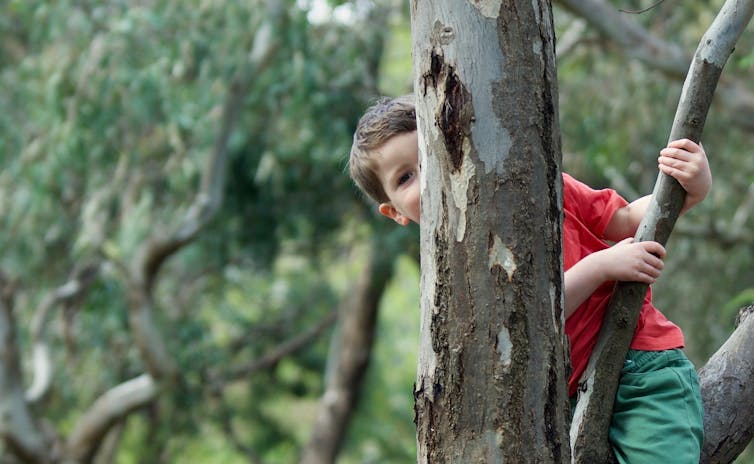
More Hands On Deck
It’s broadly acknowledged that Australia needs more hands on deck when it comes to scientific data collection. For example, only about 30% of Australia’s estimated 750,000 species have been formally named and documented. Rectifying this will require an enormous uptick in information gathering.
What’s more, Australia has one of the world’s worst extinction records. Citizen science is an important way to fill information gaps, identify species’ declines and their causes, inform conservation decisions and evaluate their effectiveness.
This year’s State of the Environment report recognised the need for more citizen science. It said the level of biodiversity research required “cannot be achieved by professionals and institutions alone”.
That’s where the B&B BioBlitz comes in.
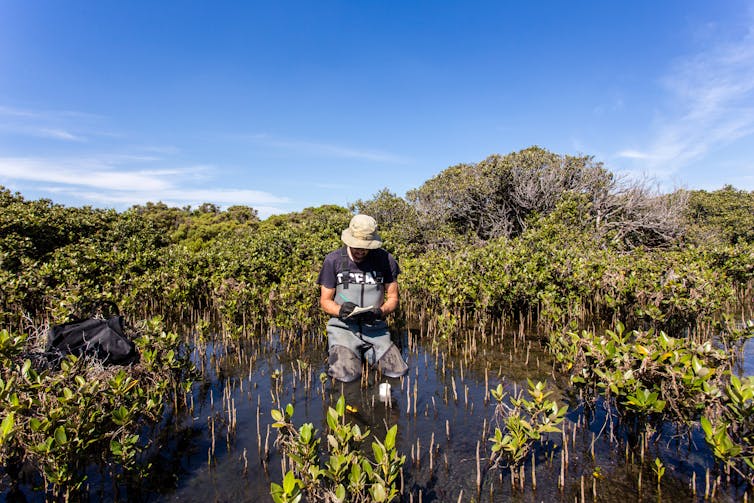
What Exactly Is A BioBlitz?
The B&B BioBlitz is a national school citizen science program co-ordinated by PlantingSeeds Projects – a non-profit sustainability organisation founded by the lead author of this article. The inaugural event ran in National Biodiversity Month in September this year. Both authors of this article were project organisers and educators.
Sixty schools from across every Australian state and territory participated. Participants comprised students from infants to high school, and their teachers.
Most schools are located in urban areas, which makes them particularly valuable sites for scientific research. Many threatened plant and animal species live in urban areas, yet, only 5% of citizen science projects in Australia are urban-based.
The project involved students taking images of plant and animal species in their school grounds on devices such as tablets and smartphones provided by the school. Students also recorded information such as the time, date and location of the photo.
A designated teacher uploaded the photos and data to the B&B BioBlitz project on iNaturalist, one of the world’s most popular biodiversity citizen science platforms and apps. At the time of writing, iNaturalist contained more than 121 million observations uploaded by citizens from around the world.
Throughout September, students made more than 2,300 observations in school grounds, involving 635 plant, animal and fungi species. Students could log onto iNaturalist to see a project “leaderboard”, browse the observations submitted and learn about species’ taxonomy and distribution.
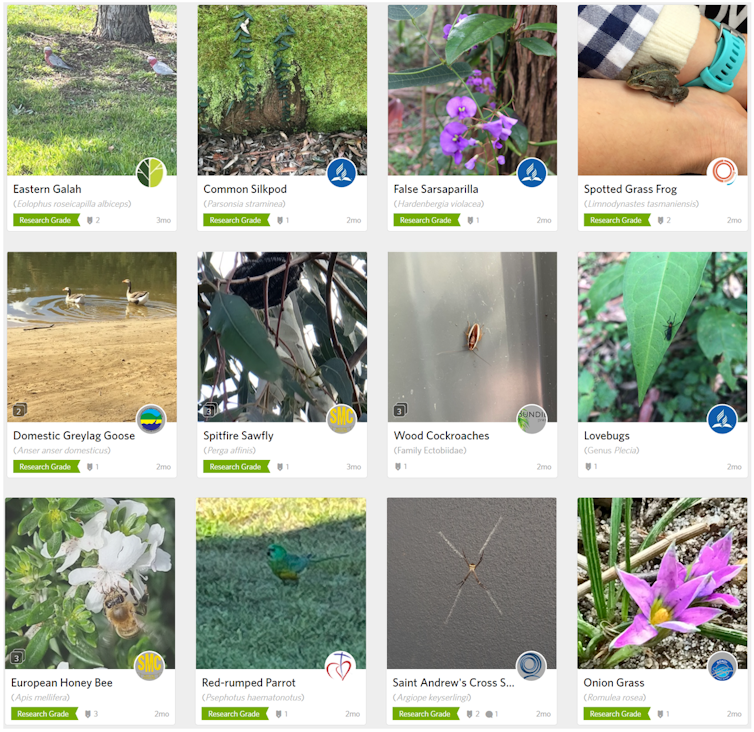
A study has demonstrated young people can contribute observations to iNaturalist that are “research grade” – and therefore more accessible and potentially useful to biodiversity research and monitoring. And the longer they participate for, the better their observations become.
Observations of species during this project contributed to more comprehensive datasets that scientists can now draw upon. Of note were images of an uncommon “Balsam Beast” katydid and the iconic Sturt’s desert pea.
Almost all observations uploaded to iNaturalist are also directly exported to the CSIRO’s Atlas of Living Australia.
The Pros And Cons
Verbal and online feedback by students reveals how citizen science can be a practical and positive experience.
One North Melbourne primary school student said the activity made her feel “like being more a part of a community”.
One student in Darwin said the activity was “the most fun he had ever had” and his teacher reported that while taking part, the student was “the most engaged he had seen”.
But the B&B BioBlitz was not without its challenges.
Many teachers, including science teachers, had limited knowledge of citizen science and often hadn’t heard of the term. This meant that teachers needed basic education on the topic prior to any school involvement in the BioBlitz.
Teachers are busy and face many pressing demands. However, if the benefits of citizen science are to be fully realised, there’s a need to broaden teacher awareness of the practice, and improve their skills in accessing databases such as iNaturalist.
8 Tips For Successful Biodiversity Citizen Science
So how can young people be helped to take a good citizen science observation? The following eight tips offer a guide:
Capture as many angles and as much information as you can. While some groups such as birds can often be recognised from a single photograph, many other taxa require multiple features for a positive identification to be made
When observing plants, photograph as many features as possible. This includes flowers and leaves (from above and below), bark, fruit if present, a branch showing leaf arrangement, and a shot of the whole plant to give a sense of its growth habit
Photograph fungi from above, below (showing the gills or pores) and the side
Record the “substrate” you find a fungus on, such as soil or dead wood, and the type of soil a plant is growing in
Insect identification can often be helped by the number and position of veins in an insect’s wing. Try and capture this by getting shots from directly above
Noting the plant you find a beetle or bug on can aid identification and provide useful ecological data
If you find a spider in a web, photographs of both the upper and undersides can be helpful
If in doubt, just record as much information as you can. You never know who might find your data useful!

Judy Friedlander, Adjunct Fellow, Institute for Sustainable Futures, University of Technology Sydney and Thomas Mesaglio, PhD candidate, UNSW Sydney
This article is republished from The Conversation under a Creative Commons license. Read the original article.
Clothes women wanted to wear: a new exhibition explores how Carla Zampatti saw her designs as a tracker of feminism

The late Carla Zampatti is celebrated in a splendid retrospective Zampatti Powerhouse at the Powerhouse Museum. Planned well before the fashion designer’s untimely death last year, the unveiling of her legacy will be bittersweet to her many fans.
Zampatti is often referred to as “Carla” by friends and those who worked for her, rather than her brand name, Carla Zampatti. Here, the simple name “Zampatti” removes the emphasis from Zampatti as designer to a simpler assertion: businesswoman, mother, philanthropist-entrepreneur.
It is a move as deft and elegant as the rest of the exhibition choices.
In one of the best-looking fashion exhibition designs Australia has seen, creative director Tony Assness serves up a dynamic vision of clothes punctuated by a vibrant red (one of Zampatti’s favourite design choices) that encourages excitement and discovery. Clothes are arranged by themes – jumpsuit, jungle, graphic, blouson, power – rather than date.
Curator Roger Leong leverages his years of experience to do a relatively new thing for Australian museums: tell the stories of clothes through the stories of women who wore them.

A Migrant Story
Zampatti’s story is an Australian migrant story. Born Maria Zampatti in Italy in 1938 (not 1942, as is often believed), she did not meet her father, who had migrated to Fremantle, until she was 11.
In Australia, she was forced to change her name to Mary. It was claimed the other kids could not pronounce Maria. She did not finish school. When she moved to Sydney in her late 20s, she reinvented herself as Carla.
The fashion business started on a kitchen table in 1965 under the label ZamPAtti. By 1970, Carla had bought out her business partner husband, and was sole owner of Carla Zampatti Pty Ltd.
Zampatti flourished in fashion. She had a finger on the pulse, was in the right place at the right time, and knew a more glamorous role was possible for a fashion designer than the industry “rag trader”.

In the 1970s, the markets suggested that the ultra-expensive haute couture was about to disappear, to be replaced by informal ranges created by a new type of designer often called a “stylist”. It was the decade of flower power, retro dressing and ethnic borrowings.
Until the 1960s, fashion had been dominated by the rise of haute couture and the “dictator-designer” system – mainly men who determined hem lengths and silhouettes for women. But in 1973, the French body governing high fashion added a new layer of designers, créateurs (literally “creators” or designers), who produced only ready-to-wear.
In 1972 Zampatti opened her first Sydney boutique, inspired by informal shops she had seen in St Tropez. Zampatti offered women bright jumpsuits, art deco looks and peasant-inspired ease.

She aimed to provide women clothes they wanted to wear. She draped the cloth and colours on herself. Like many women designers historically, she was alert to how her clothes made women customers look and feel. Zampatti remained the fit model for the whole range and would not produce anything in which she did not look and feel well.
Zampatti saw her “clothes as a tracker of feminism”.
The 1980s cemented Zampatti’s rise to prominence. She became a household name, even designing a car for women. In this time, personal expression became more important than unified looks dictated by designers. Zampatti’s Australian designing coincided with a new development in Italy: the stylisti. Small, focused family businesses alert to the zeitgeist and understanding quality flourished. It was an approach that emphasised quality and glamour.
Zampatti identified talent. She employed well-known couturier Beril Jents on the shop floor after she had fallen on hard times. She then employed Jents to improve the cut of her designs.
Zampatti continued to embrace the services of stylists and other designers including Romance was Born, whom she recognised could take her work to the next level.

The Stories Of Clothes
Worn equally by politicians and their circles on the right and the left, Zampatti injected more than power dressing into women’s wardrobes. She inspired a sense that women wore the clothes, not the clothes them.
In this exhibition we are given many examples, from Linda Burney’s red pantsuit worn for her parliamentary portrait to a gown worn by Jennifer Morrison to the White House.

The exhibition viewer can turn from serried ranks of brilliantly styled mannequins and enter large “listening pods”, screening brilliantly edited videos in the manner of artist Bill Viola. The women, who include Dame Quentin Bryce and Ita Buttrose, discuss the creative mind of Zampatti or reflect on their own Zampatti wardrobe. They are amongst the best such “talking heads” I have seen in a museum.
Like many designers, Zampatti was not that interested in her own past. She did not keep substantial archives and records, which is a testament to the skills demonstrated by the museum in bringing us this show.
Zampatti never turned her back on her personal story, but she was a futurist, one who looked forward rather than backward.
Zampatti Powerhouse is Powerhouse Ultimo, Sydney, until June 11 2023.![]()
Peter McNeil, Distinguished Professor of Design History, UTS, University of Technology Sydney
This article is republished from The Conversation under a Creative Commons license. Read the original article.
Minimalist poet Antigone Kefala wins the Patrick White Award for her contribution to Australian literature


The news that Antigone Kefala has won the Patrick White Award is completely thrilling. She is a most deserving winner by all the terms of that prize.
White established the award with funds from his 1973 Nobel prize. It is awarded without application “to a writer who has been highly creative over a long period but has not necessarily received adequate recognition”.
This well describes Kefala, who has been writing extraordinary poetry and prose for over half a century and who, though immensely admired and respected, is far too little known and celebrated in Australia.
Kefala was born in Brăila, Romania, part of the Greek diaspora settled there since the mid-19th century. Her family became refugees, fleeing to Greece then to New Zealand, after World War II, when Romania was occupied by the Soviets. She arrived in Australia on her own in December 1959. Her account of sailing into Sydney must be one of the most joyous acclamations of arrival in Australian literature:
AUSTRALIA … AUSTRALIA … we entered Sydney Harbour a summer morning. The colours of the rock wall at the gap were warm apricot, the sun was coming down on the waters, the whole landscape shimmering, overflowing with light, with heat, with movement.
I was suddenly released from the greenness, from the rain, the wind, released, at least for the moment, from my inner problems. My past in Romania, in Greece came back as meaningful experience in a landscape that had similar resonances. Sydney seemed alive with people, activity and intellectual excitement.
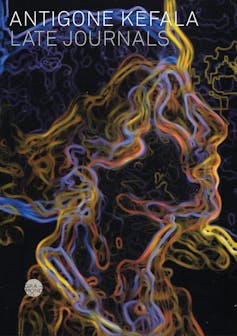
Kefala’s jubilation comes from her recognition that she might be able to forge a way of living in this new place that resonates with the landscape and culture of her past. Sydney is both new and old, simultaneously evocative and original.
The passage shows the profound interconnection between the outer world and Kefala’s inner self, something that is characteristic of her writing. It also demonstrates her awareness of the necessity of community and a milieu. Inevitably perhaps, those initial hopes met with some disappointments, but her three volumes of memoir – Summer Visit (2003), Sydney Journals (2008) and Late Journals (2022) – provide a record of her daily constitution of this community, and of a creative life.
New, Revived, Original English
Kefala’s first language is Romanian, her second language is French, her third is Greek. Finally, there is English – her fourth language and the language of her literature. As she writes:
I feel you have to live in a language to be able to write in it and […] I couldn’t write in Romanian or Greek or French because they were languages that I had somehow passed through. English was the language I was actually living in – imperfectly.
But, as she continues:
My approach to English is not quite an English approach. The kind of imagery that I use, the kind of vocabulary that I use, the whole texture of my language is not an English texture.
The result is a new, revived, original English, as in this short example from her poem Nameless:
You are the resonance
in the fanatic colour
of the sky
intoxicating light
that fans over the sea
a heavy cloth of shimmering
white gems on the horizonExcesses of a terror
that can never be appeased.
As her publisher Ivor Indyk has observed, Kefala’s voice is distinctive, characterised by a minimalism that is “evident in the short lines, which throw emphasis on syllables that are barely audible in English”.
This “accented English” is integral to the energy and intensity of her poetry. It revivifies English and its poetic capacities.

Some early readers of Kefala’s work struggled with these features, though she has always had her champions. The Patrick White Award recognises her brilliance. In their citation, the judges observed:
Kefala is a deliberately spare writer, practising an aesthetics of asceticism that is crucial to the power of her work across all forms. Her poetic minimalism belies the meticulous construction of echoes and patterns in her poetry, while the notable formal compression of both her prose and poetry distils intense experiences and perceptions.
Kefala has been contributing to Australian literature for 50 years, publishing many volumes of poetry, fiction and memoir. She has also been a strong supporter of community arts and has contributed to the promotion of a diverse Australian literature. In 2018, my colleague Brigitta Olubas and I held a conference on Kefala’s work, which led to the publication of Antigone Kefala: New Australian Modernities. In our introduction, we argued
Antigone Kefala is one of the most significant of the Australian writers who have come from elsewhere; it would be difficult to overstate the significance of her life and work in the culture of this nation.
Official recognition of Kafala’s enormous significance is not premature, but it is warmly welcome. ![]()
Elizabeth McMahon, Professor of English literary studies, UNSW Sydney
This article is republished from The Conversation under a Creative Commons license. Read the original article.
Watching Casablanca on its 80th anniversary, we remain in awe of its simplicity – and profound depth

In November 1942, a romantic drama directed by a Hungarian immigrant and starring an ex-naval officer and an obscure Swedish actress was released. The film began shooting without a finished script.
Many at Warner Brothers Studios thought the film would quickly disappear into obscurity.
It would end up winning three Academy Awards (for best picture, director Michael Curtiz, and screenplay), starred the iconic pair Humphrey Bogart and Ingrid Bergman alongside a host of recognisable supporting players, featured a lush score and evocative set design, and contained endlessly quotable lines. Its reputation grows and grows.
Casablanca has become one of Hollywood’s most beloved films.
A Film Of Vivid Moments
Casablanca is a heady mix of romance, cynicism, thrills and danger. Based on an unproduced play, Everybody Comes to Rick’s, the film mainly takes place in a night-club run by Bogart in the Moroccan city during the second world war.
Rick’s Café is where desperate refugees try to get hold of illegal exit visas to America. Complications – with Nazi officials and officious French bureaucrats – ensue.
One night, Rick’s old flame Ilsa (Bergman) turns up with her resistance leader husband in search of safe passage to the States. Cue the famous line:
Of all the gin joints, in all the towns, in all the world, she walks into mine.
It is full of vivid moments: Bogart and Bergman drinking champagne in Paris, Sydney Greenstreet in a fez, Peter Lorre trying to escape, Dooley Wilson sitting at the piano and singing THAT song.
Its production was fast-tracked to take advantage of the recent Allied invasion of North Africa. Casablanca was originally scheduled for an early 1943 release, but Warner Brothers capitalised on the resounding success of the US-led invasion, which in turn boosted box office receipts.
Casablanca would go into wide release on January 23 1943, to coincide with the Casablanca Conference, a strategic meeting between Winston Churchill and Franklin D. Roosevelt.
A Political Allegory
Casablanca’s clearest theme is that neutrality – whether in war or in love – is difficult to maintain.
At the outset, Rick is staunchly apolitical: he is jaded, unmoved by the refugee crisis unfolding around him.
But we also learn Rick has been involved in political causes, supporting losing sides against the Fascists in Spain and Ethiopia. The film traces that ambivalence through Bogart’s masterful performance. His cynicism gradually softens once Ilsa turns up, and his animosity to the Nazi chief Strasser grows.
This political about-face comes to a head in one of the greatest scenes in Hollywood cinema: the singing of La Marseillaise at Rick’s Café in full defiance of the Nazi officers belting out a German anthem.
It is a deeply patriotic and uplifting scene, and reminds us of cinema’s power to engage us, move us and make us cheer.
It also turns the night-club into a microcosm for the war, with it multinational clientele and the competing strands of partisanship, neutrality, aggression and political commitment.
For an America wary of entering the European theatre, scenes like this reminded audiences of the need to fight injustice, intolerance and belligerence.
Remembering Ingrid Bergman
It is worth dwelling on Ingrid Bergman’s luminescent performance.
She plays the role of a woman who never displays where her romantic allegiances lie. Should she leave with Lazslo to America, or should she go back to Rick, and rekindle a love affair that ended abruptly in Paris?
The ambiguity in Bergman’s performance is due in large part to both a script that was constantly being rewritten and Curtiz’s indecision on how the film should end. But it is also a reminder of Bergman’s greatness.
The critic Roger Ebert once noted:
[Bergman] doesn’t simply gaze at [a man’s] eyes, as so many actresses do, their thoughts on the next line of dialogue. She peers into the eyes, searching for meaning and clues, and when she is in a close two-shot with an actor, watch the way her own eyes reflect the most minute changes in his expression.
Her scenes with Bogart exemplify this approach.
Many film historians argue Casablanca’s greatness is due to its “invisible” style: there are no flashy camera movements, or ostentatious cuts, or “look at me” acting.
French film critic André Bazin once famously attributed the success of Hollywood studio films to “the genius of the system”.
Films like Casablanca succeeded because they were made within a thriving ecosystem that placed storytelling, creative expertise, and cast and crew competence at the heart of its artistic practice.
And Casablanca’s script remains unbeatable. It’s worth remembering the lines of dialogue that have stayed with us ever since: “Here’s looking at you, kid”; “This is the beginning of a beautiful friendship”; “We’ll always have Paris”; and “Round up the usual suspects”.
Casablanca’s Afterlife
Casablanca’s legacy is long-lasting.
Today, it ranks third on the American Film Institute’s 100 best movies of the last 100 years, and it is one of the most referenced films of all time.
Scholars love the film for its Freudian intertexts, while others see the title casa blanca – “white house: in Spanish – as a symbol for American foreign policy.
The Italian novelist Umberto Eco wrote Casablanca was "not just one film. It is many films […] it is a phenomenon worthy of awe”.
Watched today, we remain in awe of its simplicity, but also of its profound depth.![]()
Ben McCann, Associate Professor of French Studies, University of Adelaide
This article is republished from The Conversation under a Creative Commons license. Read the original article.
Spending too much money? Tempted by sales? These ways to ‘hack’ your psychology can help

It’s late November, which means the holiday sales period has well and truly begun. If you haven’t already seen your spending go up, the possibility is looming.
And you probably have some concerns about spending your money wisely. Furthermore, shopping can be a harrowing experience, and our attitudes towards money are tied up in all kinds of feelings.
Based on psychology, here are three tips to improve the way you spend your hard-earned cash this holiday season.
Before The Purchase – Patience Is Your Friend
One of the amazing features of the human mind is that we can mentally time travel: we can imagine what the future is going to feel like. Scientists call this “affective forecasting”.
Thinking about a future trip – imagining the warm sun, the sand between your toes, finding yourself smiling – is an example of such mental time travel.
However, it turns out we’re not very good at affective forecasting. We get wrong not only the emotions we will experience, but also their intensity and duration. Lottery winners are a classic example – contrary to expectations, many are not happy, or not happy for long.
More importantly, you can derive happiness from just anticipating future experiences. For example, one study measured the happiness of 974 people going on a trip compared with 556 people not going on a trip. As you might expect, the vacationers were relatively happier – but only before the trip.
So, how can we take advantage of our capacity to mentally time travel?
Tip #1: Pay now, consume later. These days, fuelled by the rise of “buy now, pay later” options, we get to consume what we want immediately. However, this instant gratification deprives us of a key source of happiness: anticipation. A better strategy is to commit to buy something and then wait a little before actually consuming it.
At The Point Of Purchase – Notice You’re Paying
An inevitability of every purchase is spending money. This represents a cost, both in terms of the monetary value but also the opportunity to buy other things.
Costs are a form of loss, and we don’t like losing things. For that reason, it psychologically hurts to spend money. Scientists call this the “pain of paying”.
According to one theory of shopping, we decide to buy after making a mental calculation: is the anticipated pleasure of consuming higher than the anticipated pain of buying?
This calculus is even represented in the brain. For example, one study looking at people’s brains with fMRI while they purchased food found neural activity in areas linked to higher-order, affective pain processing, which correlated with how high the price was.
How did you pay for your last meal? Did you have to dig into your wallet or purse trying to extract the appropriate combination of notes and coins? Maybe you simply pulled out a plastic card and swiped it on the reader? Or perhaps you absentmindedly touched your smartphone to the machine.

It turns out your method of payment changes how much pain you feel. In one study, researchers asked some university employees if they would like to buy a mug at a discounted price. Half were only allowed to pay in cash, whereas the other half had to use a debit or credit card.
Those who paid in cash self-reported more pain of paying. So, how can you use this to your advantage?
Tip #2: Ramp up the pain. If you’re worried about overspending this holiday period, ramp up the pain of paying. You can do this by using cash or receiving a notification each time money leaves your account.
After The Purchase – Stop Chasing Rainbows
A fundamental feature of human beings is that we are adaptive – we easily get used to the new normal. This applies to our purchases, too. Scientists call it “hedonic adaptation”: over time, consumption of the same thing brings decreasing happiness.
Remember the day you got your smartphone? You may have felt joy as you caressed the smooth aluminium back and watched light glint off the unblemished glass. Now look at your phone. What happened to the joy?
It’s normal to experience hedonic adaptation. However, one problem is that we don’t anticipate it.
Remember affective forecasting? Since satisfaction is a function of expectations relative to performance, when we fail to adjust our expectations in light of the inevitable hedonic adaptation, we end up dissatisfied.
The second problem with hedonic adaptation is that the obvious solution appears to be buying something new. Maybe you need a new smartphone to replace your slightly scratched-up old one? If this is your thinking, you’ve just hopped onto the hedonic treadmill.
Now the only way to maintain your happiness is to spend more and more money to get better and better versions of everything. So, how can you get off this treadmill?
Tip #3: Buy experiences, not things. It turns out people end up happier when they buy experiences rather than things. For example, a study that tracked how older adults spent their money found that only one category of spending was related to happiness: leisure purchases, such as going on trips, seeing a movie at the cinema, and cheering at sporting events.
One reason for this is that we adapt to purchases of experiences more slowly than purchases of material things.
So, the next time you’re tossing up between buying tickets to a festival or getting the latest gadget, pick up your scratched-up smartphone and pre-purchase some festival tickets for you and your friends.![]()
Adrian R. Camilleri, Senior Lecturer in Marketing, University of Technology Sydney
This article is republished from The Conversation under a Creative Commons license. Read the original article.
18th- and 19th-century Americans of all races, classes and genders looked to the ancient Mediterranean for inspiration

The ancient world of the Mediterranean has long permeated American society, in everything from museum collections to home furnishings. The design of the nation’s public monuments, buildings and universities, as well as its legal system and form of government, show the enduring influence of Mediterranean antiquity on American culture.
Until the late 19th century, Americans encountered the ancient world almost exclusively through reproductions – in books, artwork and even popular plays. Very few could afford to travel abroad to encounter Mediterranean artifacts firsthand.
Yet despite barriers to access, many Americans forged personal connections with the cultures of the ancient Mediterranean – not only the Greeks and Romans, but also the Egyptians and Israelites. Perhaps the newness of American culture inspired this deep interest in the ancient past.
One of the most fascinating aspects of Mediterranean antiquity’s influence on America, even before it officially became a country, is how it cut across cultural lines of race, class and gender. Far from being the preserve of a privileged few, the art and literature of the ancients was often embraced by Americans of all stripes – including the enslaved Black poet Phillis Wheatley (circa 1753-1784) and Black and Native American sculptor Edmonia Lewis (1844-1907). But the circumstances of these encounters and the way individual Americans thought about antiquity varied greatly.
I’m an art historian specializing in ancient Mediterranean art and culture. I am particularly fascinated by the way Americans, from the earliest days, made creative connections between past and present, despite being separated by thousands of miles and millennia of history.
In researching and selecting works of art for the exhibit “Antiquity and America,” on view at the Bowdoin College Museum of Art, I was excited to show an exceptionally diverse range of American encounters with the ancient world, especially in portrait painting.
Marker Of Education
Take, for example, Samson Occom (1723-1792), a member of the Mohegan nation, Presbyterian minister and one of the first Native Americans to pen an autobiography in English.

His unfinished portrait, painted by Nathaniel Smibert (1735-1756) in the mid-18th century, alluded to Occom’s Indigenous identity in the coloring of his skin and the styling of his hair. Simultaneously, it also referenced his training in classical literature and oratory, acquired by studying with Eleazar Wheelock (1711-1779), a Connecticut Congregational minister.
Occom’s pose and draped cloak recall those found on ancient statues of Roman senators – a portrait convention familiar in early America from prints circulating at the time – and one that would later become quite popular in American society.
While his learning in Greek and Latin was undoubtedly a source of great pride for Occom – and a way for him to level the playing field with the European colonists – it was used by others to demonstrate the “civilizing” effect of European culture and education in the British Colonies.
In 1776, Eleazar Wheelock sent his former pupil Occom to Great Britain to raise money for a Native American school – funds that were ultimately repurposed for the founding of Dartmouth College. Occom would later charge Wheelock with using him as a “gazing stock” in Europe while planning all the while to use the funds for the benefit of white settlers.
Shaping Public Opinion
A portrait of Sengbe Pieh, also known as Cinqué, who led the 1839 Amistad slave ship revolt, is an example of Black Americans’ use of the classical world for political purposes.

Commissioned by Robert Purvis (1810-1898), a Black Philadelphian and prominent abolitionist, this striking portrait by John Sartain (1808-1897) was intended to shape the popular image of Pieh and his fellow Africans during their Supreme Court trial for mutiny and murder in 1840-1841.
Pieh’s African identity is made evident not only in the tone of his skin, but in the bamboo staff he holds and the landscape in background depicting his homeland. The white cloak draped over his shoulder would have called to mind the white robes worn by Roman senators and, by extension, the Roman virtues of honor and dignity.
Pieh and his fellow Africans were ultimately acquitted and returned to the Sierra Leone Colony in 1842.
Feminist Icon

Caroline Sanders Truax (1870–1940), one of the first women admitted to the New York state bar, was so enamored by the ancient past she was portrayed as the Greek lyric poet Sappho by painter Jean-Léon Gérôme (1824–1904).
This was a bold choice for a representation of an American woman in 1899. Sappho, whose writing is among the only surviving sources of female authorship from antiquity, was already an icon of the first-wave feminist movement, and the homoerotic themes of her poetry were well understood. Was the choice the artist’s – or the sitter’s? The most likely answer is it was by mutual agreement, perhaps inspired by Truax’s knowledge of classical language and literature – and her own interest in composing lyric poetry.
The portrait was a sensation in New York society when it arrived from the artist’s studio in Paris. It was featured in several portrait exhibitions and newspaper articles – and was hung with pride by Truax and her husband in their home.

For generations of Americans, the history and literature of Mediterranean antiquity was fertile ground for contemporary comparisons. It was universal enough to be brought into debates about the Constitution and founding principles of democracy, slavery and abolition, and women’s rights and suffrage. It was also of great individual significance for Americans of many different backgrounds – a past they were on intimate terms with, despite the millennia and miles separating the United States from the ancient Mediterranean.![]()
Sean P. Burrus, Post-Doctoral Curatorial Fellow, Bowdoin College
This article is republished from The Conversation under a Creative Commons license. Read the original article.
Rosetta Stone: a new museum is reviving calls to return the artefact to Egypt

With the Arab spring of 2011, a downturn in tourism and the devastation of COVID, the odds have been stacked against the opening of Giza’s Grand Egyptian Museum, work on which began in 2005 and is due to complete 2023.
Nevertheless, it will house over 100,000 artefacts and become the largest archaeological museum complex in the world. It is sure to draw millions of visitors to see the most complete story yet of ancient Egypt, told by Egyptians.
Highlights will include the entirety of Tutankhamun’s treasure, displayed together for the first time. However, as dazzling as this will be, it is unlikely to completely distract from the ever-present repatriation debate.
In fact, the museum’s opening looks set to mark a turning point in the academic debate around returning its most obvious missing artefact – the Rosetta Stone – to Egypt.
The Case Against Repatriation
The Rosetta Stone has been the subject of a lengthy repatriation campaign. Rediscovered in 1799 by the French military campaign in the Egyptian Delta, following Napoleon’s defeat by the British, the stone was shipped to England in 1802. It has been on display at the British Museum ever since.

The British Museum has maintained a steady resistance to the stone’s return to Egypt. Legislation, including the British Museum Act 1963 (which prevents the British Museum from disposing of its holdings), covers its legal right to the stone. But there is now increasing pressure to return it to Egypt as a gesture of goodwill, recognition of the stone as Egypt’s cultural property and a symbol of a country that is increasingly reclaiming its heritage.
Some academics maintain that the stone should stay in London. There, they argue, more visitors will see it, and it takes pride of place among artefacts representing the collective efforts of humanity. They also highlight that the British Museum has kept it safe for two centuries and without British and French efforts, the stone’s significance would remain unknown.
For many years, one of the main academic arguments questioned the suitability of the Egyptian Museum in Tahrir Square, Cairo, as a home for the Rosetta Stone.
The Case For Repatriation
The argument that the stone is safer from a conservation perspective in the British Museum no longer carries the same weight in light of the new Grand Egyptian Museum, which now houses many objects formerly in Tahrir Square.
Ironically, the infrastructure of the British Museum is also in need of upgrading and refurbishment. The next few years will see this work commence in a radical overhaul called, appropriately, the “Rosetta Project”.
The British Museum positions itself as a repository of world culture, and there is certainly a case to be made for a more inclusive cultural heritage network. It can be argued that the Rosetta Stone is also part of British and French history, due to the decipherment success by Thomas Young and Jean-François Champollion, but in the end, it may come down to perceptions.

To some Egyptians, the stone is a symbol of colonialism, and the British Museum’s retention of it signals that the western dominance of Egyptian archaeology is still present. The British Museum, understandably, does not wish to relinquish its star object, but the pressure may eventually make its position untenable.
As one of the world’s most high-profile museums, its decisions are in the spotlight and any change in its stance on the Rosetta Stone could lead to other institutions being approached about the repatriation of Egyptian collections.
This year, more than 2,500 archaeologists signed a petition to repatriate the stone and, in 2021, a YouGov poll on the wider issue of returning artefacts to their country of origin found 62% in favour.
Implications For Worldwide Heritage
The British Museum has stated that they have received no formal request for the return of the Rosetta Stone, but as the 1963 Act prevents its return, the most logical way forward is the establishment of a partnership with Egypt’s Ministry of Tourism and Antiquities.

George Osborne’s position as chair of the British Museum is that the strength of the collection is in the representation of common humanity, but that the museum is willing to enter into a dialogue to ensure a satisfactory outcome for all parties.
However, as ownership will still reside with the British Museum, advocates for the stone’s return may feel this does not go far enough. On the other hand, there is a concern about the potential for cultural regression if museums start to divide their collections, although the likelihood of having to empty stores is small.
The Rosetta Stone is a perfect example of the continuing biographies of objects. Its significance no longer rests only on its role in the decipherment of hieroglyphs, and 18th- to 19th-century relationships between Britain, France and Egypt. It has taken on new meaning, and its importance now is as a symbol of the decolonisation debate, and of Egypt itself.![]()
Claire Gilmour, PhD Candidate, Anthropology and Archaeology, University of Bristol
This article is republished from The Conversation under a Creative Commons license. Read the original article.
How satellites, radar and drones are tracking meteorites and aiding Earth’s asteroid defence

On July 31 2013 a constellation of US defence satellites saw a streak of light over South Australia as a rock from outer space burned through Earth’s atmosphere on its way to crash into the ground below.
The impact created an explosion equivalent to about 220 tonnes of TNT. More than 1,500km away, in Tasmania, the bang was heard by detectors normally used to listen for extremely low-frequency sounds from illegal tests of nuclear weapons.
These were two excellent indications that there should be a patch of ground covered in meteorites somewhere north of Port Augusta. But how could we track them down?
My colleagues and I who work on the Desert Fireball Network (DFN), which tracks incoming asteroids and the resulting meteorites, had a couple of ideas: weather radar and drones.
Eyes In Space
Finding meteorites is not an easy task. There is a network of high-quality ground-based sensors called the Global Fireball Observatory, but it only covers about 1% of the planet.
The US satellite data published by NASA covers a much larger area than ground-based detectors, but it only picks up the biggest fireballs. What’s more, they don’t always give an accurate idea of the meteor’s trajectory.
So, to have any chance to find a meteorite from these data, you need a little outside help.
Weather Radars
In 2019, Australia’s Bureau of Meteorology started making its weather radar data openly available to researchers and the public. I saw this as an opportunity to complete the puzzle.
I combed through the record of events from the Desert Fireball Network and NASA, and cross-matched them with nearby weather radars. Then I looked for unusual radar signatures that could indicate the presence of falling meteorites.
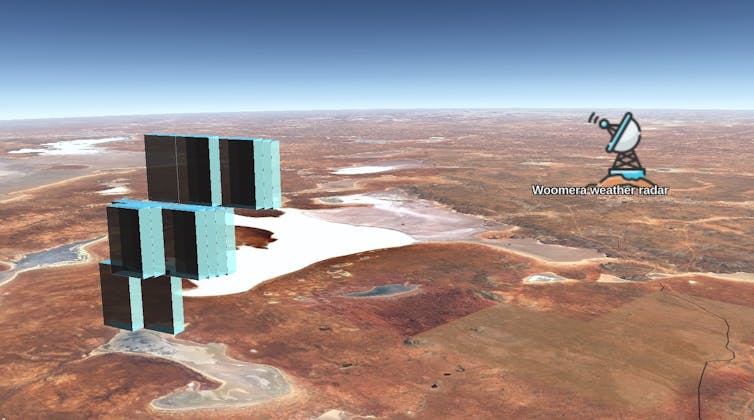
And bingo, the 2013 event was not too far from the Woomera radar station. The weather was clear, and the radar record showed some small reflections at about the right place and time.
Next, I had to use the weather data to figure out how the wind would have pushed the meteorites around on their way down to Earth.
If I got the calculations right, I would have a treasure map showing the location of a rich haul of meteorites. If I got them wrong, I would end up sending my team to wander around in the desert for two weeks for nothing.
The Search
I gave what I hoped was an accurate treasure map to my colleague Andy Tomkins from Monash University. In September this year, he happened to be driving past the site on his way back from an expedition in the Nullarbor.
Thankfully, Andy found the first meteorite within 10 minutes of looking. In the following two hours, his team found nine more.
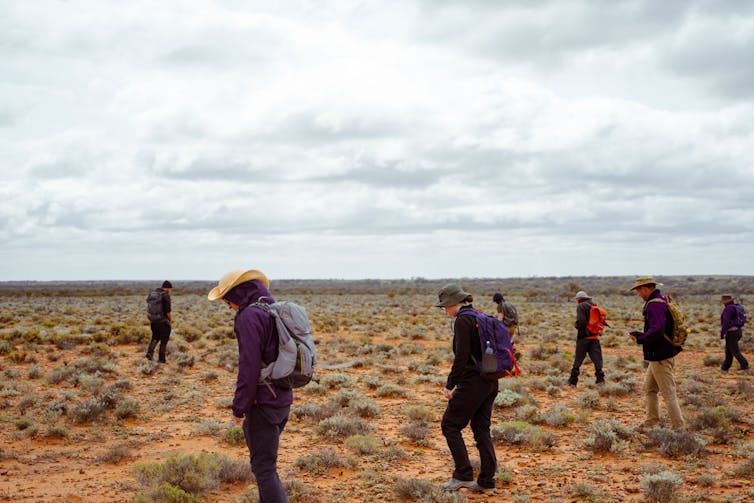
The technique of finding meteorites with weather radars was pioneered by my colleague Marc Fries in the US. However, this is the first time it has been done outside the US NEXRAD radar network. (When it comes to monitoring airspace, the US has more powerful and more densely packed tech than anyone else.)
This first search confirmed there were lots of meteorites on the ground. But how were we going to find them all?
That’s where the drones come in. We used a method developed by my colleague Seamus Anderson to automatically detect meteorites from drone images.
In the end we collected 44 meteorites, weighing a bit over 4kg in total. Together they form what we call a “strewn field”.
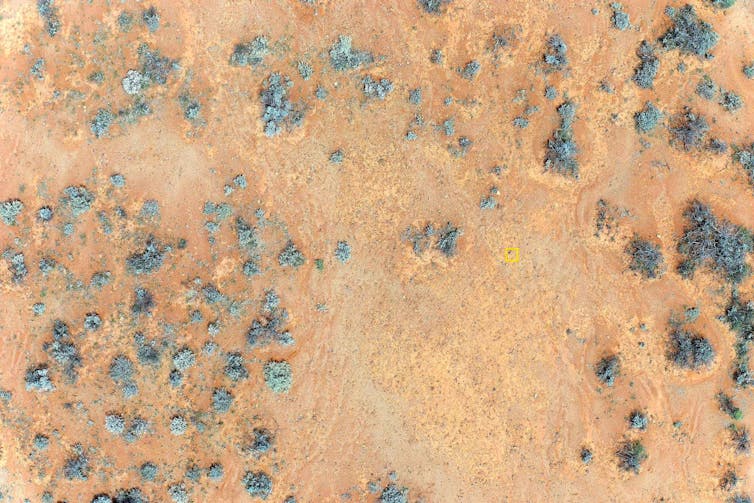
Strewn fields tell us a lot about how an asteroid fragments in our atmosphere.
That’s quite important to know, because the energy of these things is comparable to that of nuclear weapons. For example, the 17-metre asteroid that exploded over Chelyabinsk in Russia in 2013 produced an explosion 30 times the size of the bomb dropped on Hiroshima in 1945.
So when the next big one is about to hit, it may be useful to predict how it will deposit its energy in our atmosphere.
With new telescopes and better technology, we are starting to see some asteroids before they hit Earth. We will see even more when projects such as the Vera Rubin Observatory and the Asteroid Terrestrial-impact Last Alert System (ATLAS) are up and running.
These systems might give us as much as a few days’ notice that an asteroid is heading for Earth. This would be too late to make any effort to deflect it – but plenty of time for preparation and damage control on the ground.
The Value Of Open Data
This find was only made possible by the free availability of crucial data – and the people who made it available.
The US satellites that detected the fireball are presumably there to detect missile and rocket launches. However, somebody (I don’t know who) must have figured out how to publish some of the satellite data without giving away too much about their capabilities, and then lobbied hard to get the data released.
Likewise, the find would not have happened without the work of Joshua Soderholm at Australia’s Bureau of Meteorology, who worked to make low-level weather radar data openly accessible for other uses. Soderholm went to the trouble to make the radar data readily available and easy to use, which goes well beyond the vague formulations you can read at the bottom of scientific papers like “data available upon reasonable request”.
There is no shortage of fireballs to track down. Right now, we’re on the hunt for a meteorite that was spotted in space last weekend before blazing through the sky over Ontario, Canada.![]()
Hadrien Devillepoix, Researcher in Planetary Astronomy, Curtin University
This article is republished from The Conversation under a Creative Commons license. Read the original article.
Banksy in Ukraine: how his defiant new works offer hope

Art, in all its forms, has always been a powerful means of representing, resisting and remembering war. And the Russo-Ukrainian War is no different, with artists responding powerfully to Russian aggression through an explosion of artwork drawing attention to, and reinforcing, the resilience of Ukrainian people and culture.
A stream of artwork has been posted on Instagram and Twitter. Some of the artworks represent grief and trauma, whereas others reflect “the fire of hope and defiance that comes with such tragedy.”
International artists have also joined in the effort. On November 11, graffiti artist Banksy posted a picture to his Instagram of a gymnast doing a handstand, painted on the side of a building devastated by shelling in Borodyanka, Ukraine.

A few days later, Banksy confirmed that he was responsible for six other artworks in Kyiv and other cities across Ukraine, one of which appeared to take aim at Russian president Vladimir Putin, depicting him being thrown by a child in a judo match. It is not much of a stretch to interpret the child as a symbol of Ukrainian resistance.
Banksy’s other works are shown in a video posted to Instagram (above) accompanied by a soundtrack of women singing Ukrainian folk music. They show children playing on a seesaw made from part of a tank, a bombed out transport truck, a man taking a bath and a woman in a dressing gown donning a gas mask and holding a fire extinguisher.
Ukrainian messages of thanks and solidarity were posted to Banksy’s Instagram in response.
Russia’s War On Culture
The destruction of culture and cultural heritage has been among the many alleged crimes committed by Russia in Ukraine. In July 2022, Unesco reported damage to over 164 cultural sites including religious sites, museums, historic buildings, buildings dedicated to cultural activities, monuments and libraries.
As with so many aspects of the war, this reverberates with the Yugoslav War, where the searing image of the destruction of the national library in Sarajevo and its two million books and artefacts in August 1992 was one of the most iconic of the war.
An early cultural casualty in Ukraine was the Babyn Yar memorial park in Kyiv, believed to have been directly targeted by Russian forces as part of an erasure of Ukrainian history and culture.
In response, Unesco committed to the protection of cultural property as a priority. That commitment was based on the conviction that: “Culture is an essential public good for society, and access to cultural life is a basic universal human right.”
While art alone cannot change the dynamics or the course of the war in Ukraine, it can play an important role in reinforcing and demonstrating the resilience of cultural life. Whether or not it can also play a role in building peace and fostering reconciliation depends on its protection.
Unesco Responds To Threats To Ukrainian Culture
In September, Unesco announced a joint initiative with the Ukrainian NGO Museum of Contemporary Art “to encourage the continuation of artistic creation and access to cultural life in Ukraine”.
The fund will initially disburse a total of US$100,000 (£84,000) from the Unesco Heritage Emergency Fund to support seven projects, with ten more to follow. The projects were selected from an open call and include residencies and support for displaced Ukrainian artists in Dnipro and Kharkiv.
Unesco described their support of Ukrainian artists as “vital for preserving artistic expression as a basis for social cohesion, community resilience, and our common goal – fighting for freedom and democratic values”.
What Role Does Art Play In War?
All of this points to important questions about the role of art and the responsibility of artists in times of war, artistic representation of war and its horrors, art and the politics of resistance and the potential role of art in building peace and fostering reconciliation.
As historian Joanna Bourke observed in her book War and Art, art is intrinsically political, whether deliberately so or not. Artists make choices about how they represent war, often invoking “both the bitterness and the vulnerability of modern war”.
Banksy’s artwork in Ukraine draws our eye to the devastation wrought by the Russian invasion. By being painted on bombed out buildings, the images reflect how the experience of war disrupt the everyday, juxtaposing the mundane with the extraordinary – a woman in curlers and a dressing gown also wears a gas mask, children play on a tank trap seesaw.

Banksy’s intervention was warmly welcomed by Ukrainians, “hailed as a symbol of their country’s invincibility” as part of a wider Ukrainian effort to leverage art as a powerful site of resistance and demonstration of resilience.
The extent to which art might be able to contribute to peace and reconciliation is a question for later on. It seems quite far removed from the grief, anger and defiance evident in much of the artwork created to date.
For now, as the response to Banksy’s artworks demonstrates, art in Ukraine serves as a site of expression, of solidarity and a symbol of resistance. As the Ukrainian government expressed, such works are not only “about blood, death, and destruction … but also – about love, support, and hope”.![]()
Rachel Kerr, Professor of War and Society, King's College London
This article is republished from The Conversation under a Creative Commons license. Read the original article.
The concept of class is often avoided in public debate, but it’s essential for understanding inequality

In Australian news, opinion and popular culture, the figures of the hipster and the bogan are everywhere. These figures are proxies for cultural, commercial and moral aspects of class, signalling differences in fashion, accents and tastes. Perhaps one of the most recognisable examples is the popular television series, Upper Middle Bogan.
So potent and provocative are these figures in Australian popular culture, that in our experience of talking about class in the media earlier this year, following the release of our book Class in Australia, interviewers most often wanted to talk about hipsters and bogans.
These figures are important for understanding class in Australia, including how moralised classed judgements about “good” versus “trashy” culture are made. But to talk about class in Australia involves talking about material inequality, work conditions, and the social, economic and political relations that produce wealth and poverty.
In a settler colony like Australia, it also involves addressing how class relations have been built on the foundations of colonialism and the exclusion and exploitation of Indigenous people, as Eualeyai/Kamilaroi academic, lawyer, filmmaker and advocate Larissa Behrendt noted in her contribution to our book.
The ongoing crisis of COVID-19 has highlighted the need to acknowledge the drastically different experiences of the global pandemic, depending on the kind of work you do. Front-line “essential” workers, often precariously employed, many of whom are in working-class jobs, have fundamentally different experiences of risk and exposure than white-collar workers able to work from home.
COVID-19 has also exposed the complex and fragile global flows of migrant agricultural workers, whose labour Australians rely upon to put food on the table, and whose lives were put in limbo.

The Rhetoric Of Class
Class has a unique place in Australian public life. At times it looms large, acting as an organising frame to declare interests and political sentiments. In Australia, the concept of “class” has a cultural history with deep connections to unionism and the struggle for workers’ rights, including, for instance, the campaign for the eight-hour day.
Yet often class is obscured. It is markedly absent from contemporary public and political debates on poverty, inequality, disadvantage and wealth. These other terms appear to roll off the political tongue with ease. They lend themselves to policy discourse and political rhetoric where structural inequalities are broken down into a series of “risk factors” attributed to individuals.
When the concept of class is mentioned, it is often presented in an inverted top-down manner. Some of Australia’s most privileged and powerful people routinely use anti-“elite” rhetoric. The notion of elitism is used to stereotype and denigrate so-called inner-city latte sippers. Their education and “progressive” political values are cited as evidence that they fail to grasp the needs and beliefs of “ordinary” people, exemplified by the “quiet” Aussie “battler”.
The symbols of class are invoked when our highly paid politicians cosplay as working class, dressing in high-vis and helmets, wearing army fatigues, or getting on tractors when visiting farms. These performances are attempts to connect the political class with the everyday worker, while at the same time glossing over social and employment inequalities.
Whenever arguments about income or economic redistribution arise, we hear immediate invocations of a “class war”. For instance, arguing in favour of lowering the minimum wage in 2012, Australian mining magnate Gina Rinehart implored Australians to
get through the class warfare smokescreen […] if you’re jealous of those with more money, don’t just sit there and complain; do something to make more money yourself – spend less time drinking, or smoking and socialising, and more time working.
It seems that in Australia, as elsewhere, as US-based billionaire investor Warren Buffett quipped:
There’s class warfare all right, but it’s my class, the rich class, that’s making war, and we’re winning.
What Is Class In Australia?
The term “class” – as distinct from related concepts like socio-economic status, inequality or disadvantage – remains useful because it refers to the cultural, social, economic and employment relations that have produced widening inequality. It means acknowledging that some must sell their labour for wages, while others generate wealth from the capital produced from that labour.
At the same time, any genuine understanding of class in Australia requires qualifications. Class also refers to deep cultural and social practices which shape our identities, our communities and ways of being.
Class is a term that is hotly contested. Many have revisited the term, considering it in relation to, for instance, Indigenous experiences, gender and women’s work, and questions of race and racism. Not all distinctive experiences of difference, disadvantage and inequality – gender, race, Indigeneity, sexuality, ability, age for instance – represent equivalences that can be subsumed into class.
For instance, in our book, Rose Butler, Christina Ho and Eve Vincent discuss how ethnicity complicates straightforward understandings of class when it comes to education. Their research shows that many white parents denigrate Asian-Australian parents who invest in tutoring for their children, believing that it is “unfair” and does not allow kids to be kids.
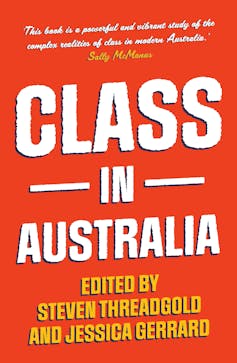
Behrendt, too, reflects on how Indigenous people have been left out of debates about class, as the concept itself was imported from Europe and, in many colonial settler histories, Indigenous people were not even treated as people. These examples and others in the book highlight the need for continual reflection on how different contours of inequality interact with class.
Class is often omitted from public debate because it reveals the systemic nature of inequality and poverty. It does not fit with the political narrative that society is meritocratic. The realities of class-based inequity call into question the idea that if you work hard and make the right choices, you can rise to the top.
The problem is that when wealth, inequality and success are understood to be the result of individual choices, the social relationships and structures that create such inequalities are hidden from view. This kind of thinking gives rise to individualised responses to inequality, or a presumption that inequality might be the result of personal characteristics or “failings”.
It is this kind of thinking that enables Bernard Salt to declare that young people might be able to buy a house if they just didn’t eat avocado toast, or former prime minister Scott Morrison to suggest that if you want to earn more all you need to do is work harder. Such comments demonstrate the significant and increasing discrepancy between political rhetoric and the reality of inequalities.
A richly informed understanding of class can play a powerful role in grasping how unequal social and economic experiences are articulated through relations of property, labour, capital and value in capitalist societies.
To put it plainly, class allows us to understand inequalities not as personal failings, but as experiences that are produced through social and economic relations. Using the term class makes inequality a public issue anchored in material structures and socio-cultural institutions. This makes class a necessary concept for understanding how Australian society functions, how the powerful maintain their interests, and how social and cultural institutions work to reproduce inequalities.![]()
Jessica Gerrard, Associate Professor, The University of Melbourne and Steven Threadgold, Associate Professor, Sociology, University of Newcastle
This article is republished from The Conversation under a Creative Commons license. Read the original article.
Get Your Tickets To The 2023 NSW Seniors Festival Premier's Gala Concerts
World-Leading Falls Researchers And Clinicians Call For Urgent Government Action On The $2.3bn Health Problem No One Talks About
- Falls and fall injuries among older people are a large and growing problem in Australia. Every day 14 Australians aged 65+ will die from a fall and 364 will have a fall that puts them in hospital.
- Treatment of injuries from falls in older people cost over $2.3 billion in 2020, with multiple flow-on effects for ambulance services, loss of independence by older people, and family impact.
- A new report suggests coordinated government action, including a well-implemented national fall prevention strategy, could reduce falls by 30% within 12 months.
- Establish a National Falls Prevention Coordination Group, modelled on the coordinated and nationally funded action in the United States and United Kingdom, adapted for the Australian context and informed by previous initiatives in Australia and New Zealand.
- Develop and implement a 5-year national plan for preventing falls that is funded to reach a critical mass of community-dwelling older people and those in residential care.
- Engage all levels of government and a broad range of sectors, including health and aged care, housing, transport, and planning and development.
- Include falls prevention strategies for people across the lifespan and in all settings to maximise benefits.
- Greater investment in translational falls prevention research.
ANZHFR Report Highlights Need For Cognitive Assessments In Hip Fracture Care
- 82% of patients had surgery within 48 hours, up from 81% in 2020
- 70% of patients had a preoperative assessment of cognition, up from 67% in 2020
- 92% of patients had a nerve block to manage pain before surgery, up from 79% in 2020
- 75% of patients in Australia were assessed for delirium, with 39% of those assessed identified as experiencing delirium
- 65% of patients in New Zealand were assessed for delirium, with 46% of those assessed identified as experiencing delirium
- Adjusted mortality-rate at 365 days reduced to 22.1% in 2020, compared with 24.8% in 2019
- Ward configuration changes, primarily conversion of orthopaedic wards to dedicated COVID-19 wards
- Hip fracture patients cared for on outlying wards, due to the absence of a dedicated orthopaedic ward, or suspected/confirmed COVID-19
- Transfer of hip fracture patients to other hospitals for definitive management
- Reduced access to rehabilitation, with closure of rehabilitation wards or transfer delays
- Reduced access to orthogeriatric services, due to staff redeployment to other roles in the hospital and community settings
- Challenges caring for patients in isolation rooms
- Improved access to operating theatres
Caravanners Urged To Seek Remedy For Dangerous Recalled Swift Cookers
- Overtightening the nuts when connecting the gas supply tubes to the burner.
- The aluminium tubes rubbing on the reflector plate that sits behind the unit.
- Vibration of the unit that is caused during transit.
Australians Working 6 Weeks Unpaid Overtime, Costing Economy Over $92 Billion: Go Home On Time Day Report
- The average Australian worker performs 6 weeks unpaid overtime per year, worth over $8,000 per worker per year
- The ‘Right to Disconnect’ is supported by six in seven (84%) workers, and has recently been recommended by the Senate Select Committee on Work & Care
- Across the workforce, this equates to $92 billion in lost income per year, roughly the same as the Commonwealth’s annual expenditure on healthcare
- Workers share of national income is at an all-time low of 44% in 2022, while the profit share of income is at an almost record high of 30%
- Respondents reported 4.3 hours of unpaid work per week, equivalent to 15% of total working hours. This equates to 224.3 hours per year per worker, or six standard 38- hour work weeks.
- Across the whole labour market, over half of all workers (56%) are unsatisfied with their working hours
- Almost one in two (46%) workers in Australia reported that they wanted more paid hours
- 84% workers support the Federal Government legislating a ‘Right to Disconnect’ that directs employers to avoid contacting workers outside of work hours, unless in an emergency, with only 8% who oppose
- The most commonly experienced negative consequences were physical tiredness (35%), followed by stress and anxiety (32%), and being mentally drained (31%), each affecting around a third of workers.
- Over a quarter of workers reported that overtime interfered with their personal life and relationships (27%), and 17% responded that it led to disrupted or unfulfilling non-work time.
- One in five workers identified that working outside scheduled hours negatively affected their relationship with work, with 22% who reported reduced motivation to work and 19% experienced poor job satisfaction.
Compulsory Dementia Education As Important As Pay Rise For Aged Care Workers
Losing Your Best Friend: Your Pet - And How Pets Grieve Too
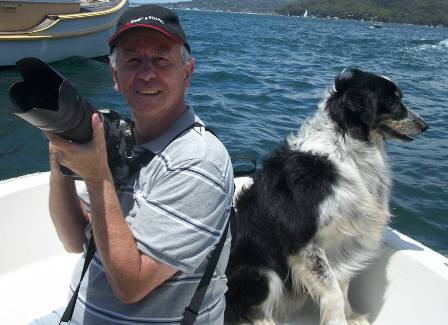
Profound grief for a pet is normal – how to help yourself or a friend weather the loss of a beloved family member
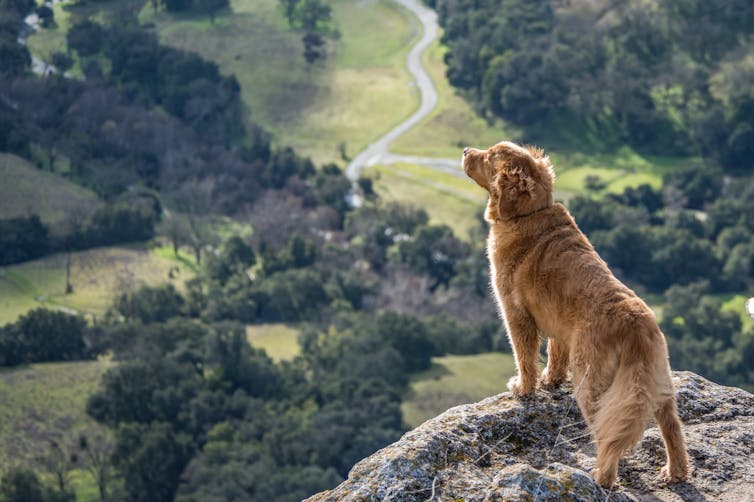
It’s been three weeks since my partner and I lost our beloved 14.5-year-old dog, Kivi Tarro. It’s impossible to describe what Kivi meant to us, or put words to how his death has affected us.
As I am still working through what life without Kivi means, there’s perhaps no better time to examine how grief impacts those who have lost an animal. This is also what a new review of scientific literature, published today, explores.
The review aims to give counsellors perspective into how to help people grieving the death of a pet. The authors highlight that the bond between humans and animals can be extremely similar to that between two humans, and so the loss can be just as profound.
There is a tendency, however, for society to invalidate that grief. This can leave people isolated and feeling ashamed or unable to express their grief, which can increase the intensity of grief and inhibit resolution.
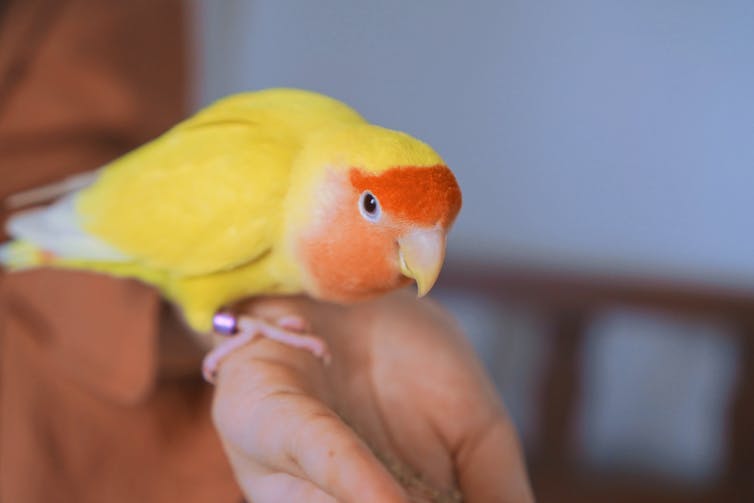
The authors’ advice for counsellors is to step away from their own biases and acknowledge that the human-animal bond can be deep and complex. Indeed, in some cases, animals have taken on roles of emotional and social support usually reserved for fellow humans.
As we come to better understand grief associated with the loss of an animal, more specific guidelines for counselling may occur. For now, it’s important to recognise that the loss of an animal can be every bit as painful as the loss of a human, and the grief experienced is similar.
Here I outline a few ways to help you weather their death, and to help a grieving friend.
Losing A Pet Hurts
Anyone who has loved an animal companion knows losing a pet hurts. Every relationship we forge with an animal is unique, and they become tightly woven into our existence.
To lose such a friend is not just to have sudden hole where they used to be. There are constant reminders of time spent together, threads in the tapestry of daily life left ragged and loose.
Everywhere we go with our other two dogs evokes memories of Kivi. So too do daily routines that frequently include our dogs.
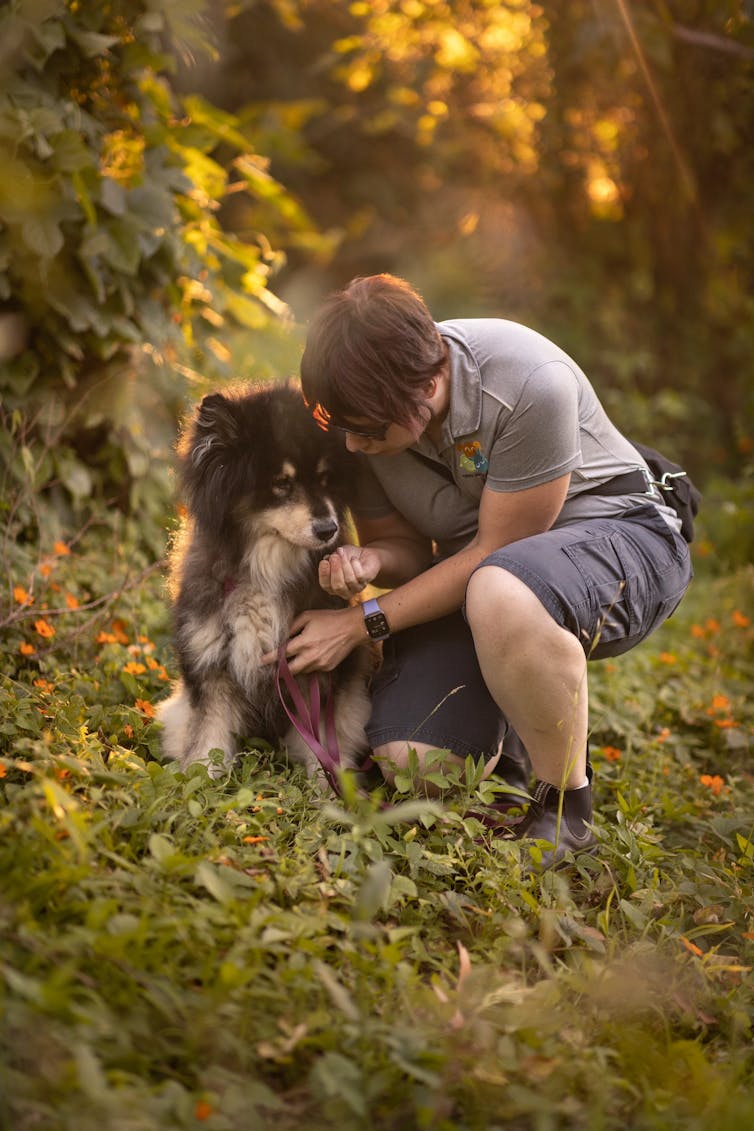
Grief is an emotion associated with a sense of loss, a feeling of emptiness when something important to us is gone. It is considered normal to grieve the loss of a relative or close human friend. But as the review notes, there are many kinds of grief, some especially relevant to pet owners.
Kivi’s decline was slow and we experienced ambiguous loss and anticipatory grief as we were forced to cross off one previously loved activity after another that he could no longer do with us as he aged.
We agonised over his quality of life and second-guessed ourselves, as we knew the time was coming and feared making the decision too early or too late. This process can lead many pet owners to experience responsibility grief, where they may feel guilt for not having done enough to extend the time they had with their pet.
Disenfranchised grief is where a person experiences a significant loss, but society does not acknowledge it as valid and worthy of social support. Society may view pets as “just an animal”, and therefore not a worthy or appropriate cause of grief.
This can make people feel ashamed or guilty for the effect losing a companion animal has on them, and strive to conceal it or move on without resolving it.

How To Weather The Loss Of Your Animal Friend
Grief is a very personal journey and no one can tell you how you should or shouldn’t experience it. Here are some things to remember:
embrace the grief. I found peace in accepting that I would be heartbroken and letting myself exist in that place
grieve in whatever way comes naturally, for as long as it feels right to. Everybody grieves differently and it takes as long as it takes, whether that be weeks or years
seek support from your social network. The review emphasises the importance of social support. If friends or relatives don’t seem to understand, reach out to other animal lovers. Perhaps seek out an animal bereavement group online
find ways to honour your pet’s memory. The review suggests writing a letter to them and a letter from them back to you. Or you could create something that expresses your feelings for them, hold a memorial, or perform a ceremony or ritual
mind your other animals. Some animals barely seem to notice when their housemate disappears while others may show signs of grieving themselves, such as reduced eating or increased fearfulness. Their distress is real as well, and you should speak to your veterinarian if it persists for more than a few days or is extreme.
Our two younger dogs did not look for Kivi at all and we were glad we hadn’t included them when we said goodbye to him. Our distress would have affected them more than Kivi’s passing
- seek professional help if you are struggling. This IS grief, and professional psychologists and counsellors are trained to help.

How To Support Someone Grieving Their Pet
If you have a friend or relative who has recently lost an animal, here are some tips for being a positive and helpful presence:
acknowledge and validate their pain and grief. You don’t have to understand it to believe in it
sharing your own experiences of loss can show people you understand, but it may also make someone feel more isolated because their experiences are different. Step carefully and keep the focus on them
send a card, a gift or a message. I did not have the emotional bandwidth to respond to all of the heartfelt messages I received when Kivi died, but I appreciated every one of them. It meant a lot to know my grief was recognised and my social circle knew I was heartbroken. I particularly appreciated other people sharing their memories of Kivi
maintain your support without judgement. It takes some people years to recover from such a loss, and that’s okay. Society may have expectations for how long grief of an animal should take, but the review points to research that shows the stronger the bond between a human and an animal, the more intense their grief at losing it.

Melissa Starling, Postdoctoral researcher, University of Sydney
This article is republished from The Conversation under a Creative Commons license. Read the original article.
Nitrous Oxide – Not A Laughing Matter
 Medical professionals are calling for tighter restrictions on the sale of nitrous oxide gas cartridges, colloquially known as ‘nangs’, due to potentially serious harm for users including lasting neurological damage. Nitrous oxide or ‘laughing gas’ is normally used by dentists and medical professionals to provide sedation and pain relief to patients undergoing minor procedures. It’s also a food additive, used to aerate whipped cream, and sold in gas cartridges online and in convenience stores.
Medical professionals are calling for tighter restrictions on the sale of nitrous oxide gas cartridges, colloquially known as ‘nangs’, due to potentially serious harm for users including lasting neurological damage. Nitrous oxide or ‘laughing gas’ is normally used by dentists and medical professionals to provide sedation and pain relief to patients undergoing minor procedures. It’s also a food additive, used to aerate whipped cream, and sold in gas cartridges online and in convenience stores. UNSW Solar Innovator, World-Leading Oceanographer And Molecular Tech Entrepreneurs Awarded Prime Minister's Prizes For Science

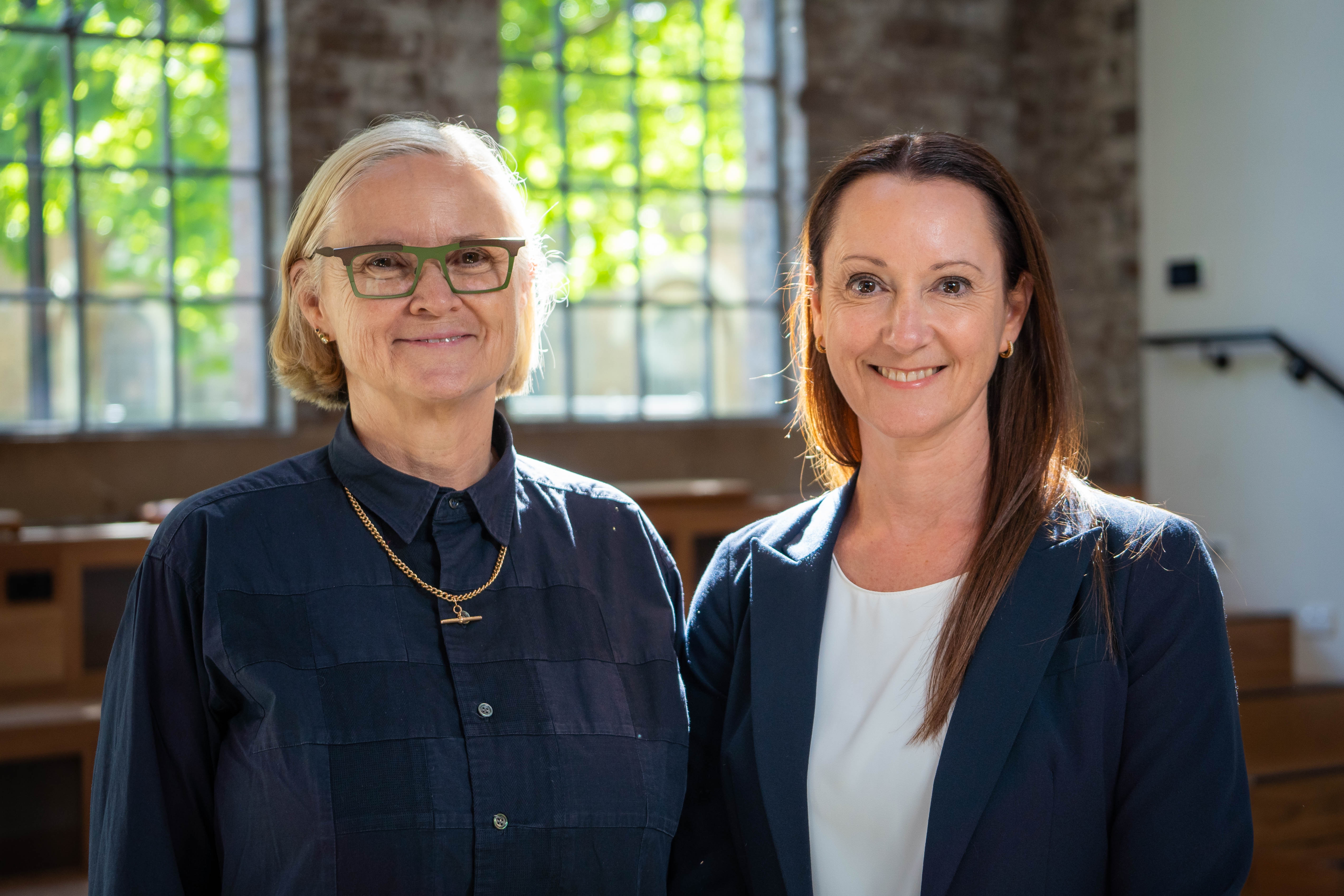
Children As Young As 10 Are Repeat Self-Harming: Study
Shocking Question: Can We Store The Energy From Lightning?
Solid Salamander: Prehistoric Amphibian Was As Heavy As A Pygmy Hippo

Exercise Can Reduce Severity Of Breast Cancer Treatment Side Effects

Sea Level Rise To Dramatically Speed Up Erosion Of Rock Coastlines By 2100
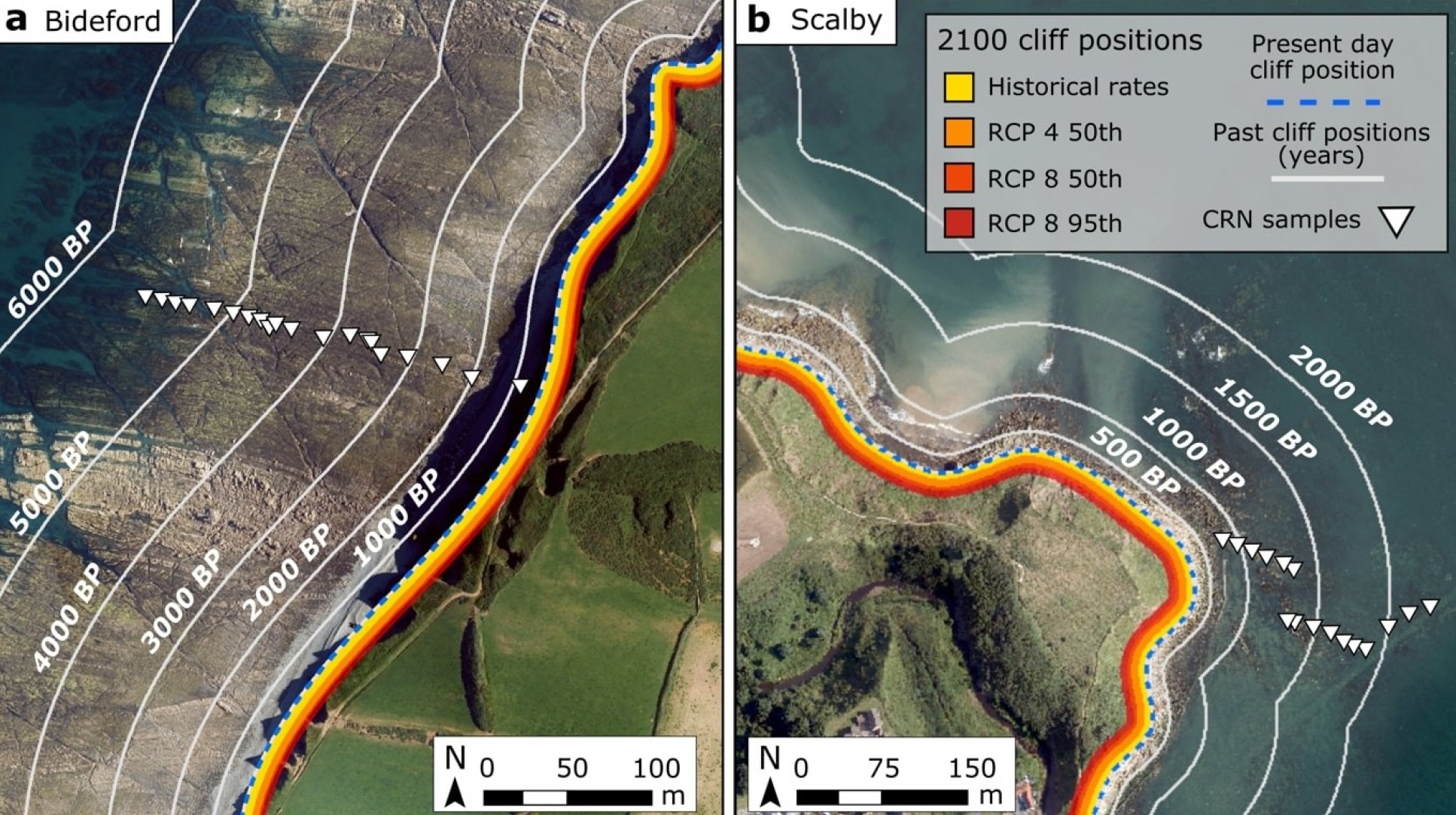
It’s time-out for leap seconds: an expert explains why the tiny clock adjustments will be paused from 2035

Meeting in Versailles, France, on Friday, the Bureau International des Poids et Mesures (BIPM) has called time-out on “leap seconds” – the little jumps occasionally added to clocks running on Coordinated Universal Time (UTC), to keep them in sync with Earth’s rotation.
From 2035, leap seconds will be abandoned for 100 years or so and will probably never return. It’s time to work out exactly what to do with a problem that has become increasingly urgent, and severe, with the rise of the digital world.
Why Do We Have Leap Seconds?
Roll back to 1972, when the arrival of highly accurate atomic clocks laid bare the fact that days are not exactly 86,400 standard seconds long (that being 24 hours, with each hour comprising 3,600 seconds).
The difference is only in milliseconds, but accumulates inexorably. Ultimately, the Sun would appear overhead at “midnight” – an indignity metrologists (people who study the science of measurement) were determined to prevent. Complicating matters further, Earth’s rotation, and thus the length of a day, actually varies erratically and can’t be predicted far in advance.
The solution arrived at was leap seconds: one-second corrections applied at the end of December and/or June on an ad hoc basis. Leaps were scheduled to ensure the timekeeping system we all use, Coordinated Universal Time (UTC), is never more than 0.9 seconds away from the Earth-tracking alternative, Universal Time (UT1).
But all this was before computers ruled the Earth. Leap seconds were an elegant solution when first proposed, but are diabolical when it comes to software implementations.
This is because a leap second is an abrupt change that badly breaks key assumptions used in software to represent time. Base concepts such as time never repeating, standing still, or going backward are all at risk – as well as other quaint notions like each minute lasting exactly 60 seconds.
Leaping Into Danger
Question: what’s worse than mixing computers and leap seconds? Answer: mixing billions of interconnected networked computers, all trying to execute a leap second jump at (theoretically) the same time, with a great many failing in a wide variety of ways.
It gets better: most of those computers are learning about the impending leap second from the network itself. Better still, almost all are constantly synchronising their internal clocks by communicating over the internet to other computers called time servers, and believing the timing information these supply.
Imagine this scene then: during leap-second madness, some time-server computers can be wrong, but client computers relying on them don’t know it. Or they can be right, but client computer software disbelieves them. Or both client and server computers leap, but at slightly different times, and as a result software gets confused. Or perhaps a computer never receives word that a leap is happening, does nothing, and ends up a second ahead of the rest of the world.
All of this and more was seen in the analysis of timing data from the last leap-second event in 2016.
The ways in which computer confusion over time can impact networked systems are too numerous to describe. Already there are documented cases of significant outages and impacts arising from the most recent leap second events.
More broadly though, consider the networked critical infrastructure our world runs on, including electricity grids, telecommunications systems, financial systems, and services such as collision avoidance in shipping and aviation. Many of these rely on accurate timing at millisecond scales, or even down to nanoseconds. An error of one second could have huge and even deadly impacts.
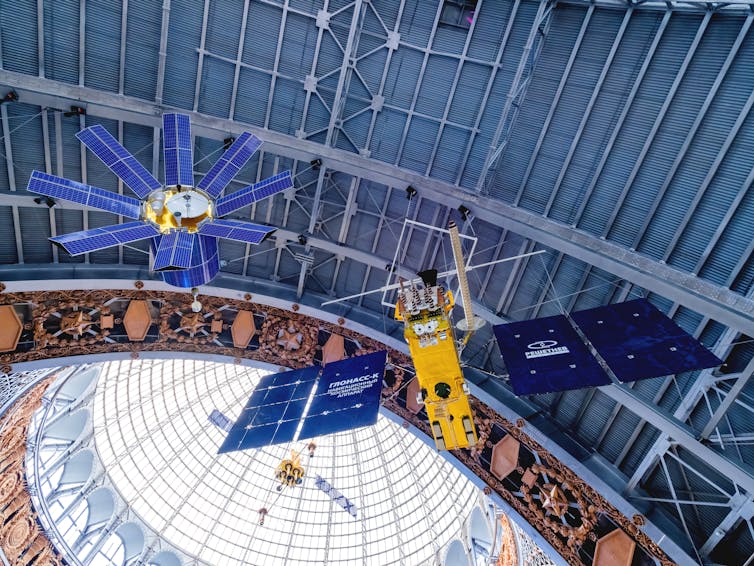
Time’s Up!
In recognition of the growing costs to our computer-based world, the idea of doing away with leap seconds has been on the table since 2015.
The International Telecommunications Union, the standards body that governs leap seconds, pushed back a decision several times. But pressure continued to grow on multiple fronts, including from major tech players such as Google and Meta (formerly Facebook).
The majority of international participants in the vote, including the US, France and Australia, supported the recent decision to drop the leap second.
The Versailles decision is not to abandon the idea of keeping everyday timekeeping (UTC) aligned with Earth. It’s more a recognition that the disadvantages of the current leap second system are too high, and getting worse. We need to stop it before something really bad happens!
The good news is we can afford to wait the suggested 100 years or so. During this time, the discrepancy may grow to as much as a minute, but that’s not very significant if you consider what we endure with daylight savings time each year. The logic is that by dropping the leap second right now, we can avoid its dangers and allow plenty of time to work out less disruptive ways to keep time aligned.
How Could We Deal With This Down The Track?
An extreme approach would be to fully adopt an abstract definition of time, abandoning the long-held association between time and Earth’s movements. Another is to make larger adjustments than a second, but far less frequently and with far better preparation to limit the dangers – perhaps in an age where software has evolved beyond bugs.
The decision of how far we’re willing to let things drift before a new approach is decided upon has its own deadline: the next meeting of the Bureau International des Poids et Mesures is set for 2026. In the meantime, we’ll be stuck with leap seconds until 2035.
Since the Earth has surprisingly begun to spin faster in recent decades, the next leap second may, for the first time, involve removing a second to speed up UTC, rather than adding a second to slow it down.
Software for this case is largely already in place, but has never been tested in the wild – so be prepared to leap into the unknown.![]()
Darryl Veitch, Professor of Computer Networking, University of Technology Sydney
This article is republished from The Conversation under a Creative Commons license. Read the original article.
Groundbreaking studies of Earth’s churning oceans recognised at Australia’s most prestigious science prizes this year

This year, Australia’s prestigious Prime Minister’s Prize for Science has been awarded to a physical oceanographer whose work has had a “transformative impact” on our understanding of Earth’s oceans.
Professor Trevor McDougall AC from the University of New South Wales has made major contributions to unveiling the fundamental physics of the ocean.
During his illustrious career, McDougall has discovered previously unknown ocean mixing processes – the turbulent ways seawater churns and irreversibly changes under various conditions.
His discoveries have improved climate models, allowing us to better predict our planet’s fast-changing future.
“The ocean is notoriously difficult to observe; we know more about the surface of the Moon than we do about the seafloor,” McDougall said.
“We study the ocean because it transports a lot of heat from the equatorial regions towards the poles and also because it acts as the thermal flywheel of the climate system.”

A world-leading authority on ocean mixing, McDougall was recognised for his many contributions, including a redefinition of the thermodynamic description of seawater. The latter was accepted by the Intergovernmental Oceanographic Commission in 2009 as a new international standard.
“To receive the Prime Minister’s Prize for Science is an incredible honour, and it’s also an honour for the early career researchers that I’ve been working with for the past ten years,” said McDougall.
“They’ve been integral to some of the results that have been recognised in this prize.”
Predicting Sea Level Rise
Earth’s oceans and their role in climate change are also the focus of another prize recipient this year – physical oceanographer and ocean modeller Dr Adele Morrison from the Australian National University (ANU).
She won the Malcolm McIntosh Prize for Physical Scientist of the Year for her innovative methods of modelling ocean circulation around Antarctica.
Morrison’s research has greatly reduced uncertainty in predicting future sea level rise from Antarctic ice sheet melt, driven by warm ocean currents in the Southern Ocean.

Such work is particularly pertinent to Australia, with 85% of Australians living in places that could soon be affected by rising sea levels.
Morrison hopes to “inspire the next generation of scientists to unravel new discoveries and technologies that limit the impacts of climate change and our transition to a zero-emissions world”.
Molecular Diagnostics And Solar Cell Improvements Also Recognised
Several other researchers and inventors received accolades at the ceremony held on November 21 at Parliament House in Canberra.
Adjunct Professor Alison Todd and Dr Elisa Mokany, co-founders of the molecular diagnostics company SpeeDx, received the Prize for Innovation. Their highly advanced diagnostic tests have improved diagnosis and treatments for several infectious diseases and cancers.
The other Prize for Innovation went to Dr Nick Cutmore, Dr James Tickner and Mr Dirk Treasure of the company Chrysos. They have successfully commercialised an X-ray technology that measures the presence of gold and minerals in ore samples.
Professor Si Ming Man from ANU was awarded the Frank Fenner Prize for Life Scientist of the Year for his work on inflammation and new therapies for inflammatory diseases.
The Prize for New Innovators went to University of Melbourne’s Dr Pip Karoly, whose unique seizure forecasting technology is improving the lives of millions of people with epilepsy.
UNSW Associate Professor Brett Hallam was also awarded the Prize for New Innovators, whose discoveries and patented tech have improved solar cell performance by a whopping 10%.
Inspiring Our Youngest Future Scientists
Each year, the prizes also include recognition for outstanding achievements in science teaching.
Mr George Pantazis from Marble Bar Primary School in Western Australia was awarded the Prize for Excellence in Science Teaching in Primary Schools for his work integrating First Nations cultural knowledge, including the critically endangered Nyamal language, in the school’s science, technology, engineering, and mathematics (STEM) program.
This “wouldn’t be possible without the support of our teachers and the community, in particular the Nyamal people and their Elders”, said Pantazis.
“This prize is the highlight of my career. I owe it all to the students. Without them, I have nothing.”
The Prize for Excellence in Science Teaching in Secondary Schools went to Ms Veena Nair from Viewbank College, Victoria. She has collaborated with countless academics and industry leaders to not only show students the practical application of STEAM (science, technology, engineering, arts and mathematics) subjects, but also find pathways for them in STEAM careers.
“As a first-generation migrant, I’m deeply thankful to my birth country India, where I got my foundation skills – and to my adopted country Australia, where I was given the wings to fly,” said Nair.
For 23 years now, the Prime Minister’s Science Prizes have been awarded for outstanding achievements in scientific research, research-based innovation and excellence in science teaching. The recipients share a prize pool of $750,000.
This is the first year since 2019 the prizes were held at the Parliament House again, with the 2020 and 2021 events having taken place virtually.![]()
Signe Dean, Science + Technology Editor, The Conversation
This article is republished from The Conversation under a Creative Commons license. Read the original article.
Why do kids bully? And what can parents do about it?

Bullying is unfortunately a common problem in Australian schools, with surveys suggesting one in five teenagers are bullied.
While schools are responsible for ensuring a safe environment, parents are likely to be distressed and unsure about what to do if their child is being bullied.
What exactly is bullying? And how can you help your child if you are concerned?
What Is Bullying?
Bullying is not just kids being thoughtless or a bit mean. It is not a single act, a mistake, or a mutual disagreement.

Bullying is a repeated act of aggression that is intended to cause harm. It can be physical (harming the person or their belongings), verbal (written and spoken words that cause harm), or social (isolating someone, harming their social standing, or sharing private information).
It is not a “normal” childhood experience – it is targeted and has long-lasting and serious effects for the victim.
These effects include reduced engagement in education and loneliness at school, loss of self-esteem, psychological distress, depressive symptoms, problems with sleep, suicide and suicidal ideation, non-suicidal self-injury and substance abuse.
Bullying Can Be Overt And Hidden
Bullying can be overt with observable actions like kicking or name-calling.
Or it can be covert, which is more hidden and can include whispering, exclusion, and rumours. While females and males are equally likely to have experienced bullying and are equally likely to bully, males are more likely to engage in overt physical bullying, while females are more likely to engage in covert bullying through social or cyber behaviour.
A 2019 Mission Australia survey found 21% of young people aged 15–19 reported bullying in the past 12 months. Of those who had been bullied, nearly 80% said the bullying took place at school.
More than 70% said the bullying was verbal, 61% said it was social, 36.5% said it was cyberbulling and about 20% said it was physical.
There is less concrete data about younger children’s experiences of bullying. One reason is they tend to over-report behaviours that would not be defined as bullying. For example, a young child may believe they are being bullied if someone does not want to play with them.
Bullying in this age group can also be viewed by some researchers and educators with less concern as it can be incorrectly labelled as a “normal” part of childhood.
Why Do People Bully?
Bullying behaviour is often motivated by a desire to meet basic needs for recognition, attention and approval. It is a misguided attempt to increase your popularity by making other people look small.
As UK bullying expert Elizabeth Nassem notes, if children are popular they can
achieve respect, influence, admiration and leadership over their peers – sadly, at the expense of other children.
Another reason young people is bully is because they have been mistreated, experienced shame, or bullied themselves by peers, parents, or siblings. They bully others as an attempt to seek revenge and regain a sense of self-worth.
There are also systemic reasons why young people bully. Schools that don’t adequately supervise students, or have practices or policies that exclude young people with diverse needs can contribute to bullying.
When systems exclude or shame young people, young people within the system are more likely to do the same.
How Can Parents Help?
Bullying is a complex problem. While the onus should be on schools to fix it, parents can be empowered to support their child if they are the victim of bullying.
1. Make space for your child to tell you
Children need to talk about their experiences of bullying in order for parents to act. However, research indicates they often don’t speak out, with one study indicating only 53% of children told their teacher and 67% told their parents they were being bullied.

Young people report they don’t tell because adult responses are often ineffective, insensitive or excessive.
They also say they fear looking weak, making the situation worse, and that adult support might undermine their sense of autonomy. In one study, children explained the main reason they wouldn’t report bullying behaviour was because they “didn’t want to be a little nark” [an informer] and lose the approval of their peers.
These findings suggest it is important to provide space for your children to talk and to be well equipped to respond when they do.
Listen to your child carefully, ask them what role they would like you to play in solving the problem. Assure them you will handle the situation sensitively and with a view to protect them from further harm.
Parents can also praise their children’s maturity and strength when they report bullying and reinforce that it is not “telling-tales” or “weak” when someone’s safety is at risk.
2. Approach school
While it can be distressing to hear your child has been bullied, it is important to process these feelings before you act so you can be calm.
Your first action should be contacting the school to report the bullying. It is not advised to contact the other child’s parents directly. This can escalate the issue, break your relationship with the parent, take away your child’s power, and the other parents may not act – so it leaves the problem unresolved.

When you contact the school, ask for an investigation of the issue and a response timeline. This approach demonstrates that you are open to other perspectives and not seeking to blame anyone. It also indicates you expect an outcome.
You may also request that your child’s identity is not shared to protect them from further retaliation. If there is no response, follow up until there is a resolution. Don’t promise your child you won’t do something because if your child or another is unsafe, you need to intervene to ensure their safety.
3. Provide your child with skills
Your child can also be better equipped by teaching them emotional and interpersonal skills to help them navigate instances of bullying.
These skills include self-regulation, social skills, and problem solving. This can enable your child stay calm and not appear distressed, to be assertive when appropriate, and to consider creative ways of resolving difficult situations.
You can also teach your child safe, practised, and planned responses they can use in instances of bullying. One example of this is “fogging”. This is a technique where the child agrees the bully may or may not be correct but does not get defensive and upset.
For example, a bully may say “your shirt is ugly”. A fogging response would be “you may be right”. With this approach the bully is not getting a reaction to their insult and therefore not meeting their need for attention and control.
4. Gather a support crew
Help your child identify safe spaces, peers and adults they can turn to for support.
They need to understand that in the middle of the bullying behaviour, they have people they can depend on who care for them. Bullies try to isolate. Your child needs to know they are not alone, they are loved, and they are supported.
If this article has raised issues for you or your child, you can call Lifeline on 13 11 14 or Kids Helpline on 1800 55 1800.![]()
Mandie Shean, Lecturer, School of Education, Edith Cowan University
This article is republished from The Conversation under a Creative Commons license. Read the original article.
Disclaimer: These articles are not intended to provide medical advice, diagnosis or treatment. Views expressed here do not necessarily reflect those of Pittwater Online News or its staff.